2 Volumes
Culture: The Flavors of Philadelphia Life
Philadelphia began as a religious colony, a utopia if you will. But all religions were welcome, so Quakerism mainly persists in its effects on others, both locally and in America, in Art, clubs, and the way of life.
Philadelphia's Archepelago of Colleges
New England had a much more religious founding culture,
Academia in the Philadelphia Region
Higher education is a source of pride, progress, and aggravation.
Although New England and Virginia were colonized fifty years before Philadelphia, the earlier American colleges were created to train ministers. The Quaker churches of Pennsylvania, Delaware and New Jersey had no ministers, of course, and the concept that everyone ought to be a minister led the three Quaker colonies of the Delaware Bay to universal lay education sooner than those who were thinking of ministers as an elite. It also led to troubled questioning about education: what's the purpose of all this, anyway? To some extent, that's the farmer mentality showing through, although it shows up in a different light when you reflect upon the pervasiveness of Quaker education. The Philadelphia Yearly Meeting still has fifty-five private schools and three highly selective colleges under its care. That's pretty remarkable for a church of only ten thousand members, competing with tax-favored education. The main exception to the religious centrality of higher education was the University of Pennsylvania, founded by the deist Benjamin Franklin. Even there, a perceived need to concentrate secular activities in one unusual college dramatizes the pervasiveness of religion in Colonial society.
The Quaker colonies -- Pennsylvania, Delaware and New Jersey -- currently contain about 350 colleges and universities of varying size and focus, with roughly a million students in attendance at all times, and a growing number of local students studying abroad, taking a year off or deferring further education for some other reason. Southeast Pennsylvania is also distinctive in its concentration of graduate and professional schools within metropolitan Philadelphia, with a large number of free-standing liberal arts colleges feeding students inward from several hundred miles around. If these friendly neighboring undergraduate colleges are taken into account, the Philadelphia influence seems considerably greater and its apparent insularity easier to accept. Only Princeton stands aloof from this interwoven community, although the University of Pennsylvania, the central pivot, is starting to stand aside from it. The neighboring schools are slowly developing a greater affection for the city than for its largest university, which unfortunately has allowed itself to become their largest competitor rather than their leader. It's interesting to speculate what will happen if Penn fortuitously gets several big bequests, placed in the hands of a President from Elsewhere who overvalues faculty prestige and undervalues student education, the unfortunate general hallmark of the Ivy League. The invisible archipelago of semi-affiliated colleges would then probably rearrange itself around a different graduate school focus, since grievances tend to last longer than gratitude.
The anxieties and competitive recriminations of the whole college admission process are clearly asserting that America has too few pre-eminent universities and must quickly upgrade some from the ranks of the second and third prestige tiers. The nation now has thirty dominant universities (self-described as "research universities"), and apparently needs to reach three hundred to satisfy approaching student and industry demand. The analysis suggests the Philadelphia region now has two of them, needs twenty. The only reason to question this conclusion is concern that the scramble for entrance might be more related to credentials than educational need. That is, colleges have translated SAT scores into entrance tranches, so that embarrassment about asking someone his SAT score is eased by asking what college accepted him, now essentially the same question. One worries that the day after any student takes that multiple-choice test, his thirst for education can be dispensed with.
Others worry about this, too. I am familiar with one chemical engineer who has offered to fund a hundred-million dollar effort to induce more Americans to study chemistry. Like others, he is alarmed by the universal dominance of foreign students, mostly Asian, in our university science programs. If we let that continue in a science-based society, our grandchildren will be working for their grandchildren.
A third concern for the future of academia is the degree to which distorted capital expansion has been funded by government spending, especially medical spending. That may seem a peculiar viewpoint for a physician to hold, but just ask what will happen when we cure three more major diseases, such as cancer, Alzheimers, and schizophrenia. That will materially reduce the need for medical care among young adults, and prolong life expectancy among the elderly to the point where Congress will rebel at the cost of medical research, at present an unthinkable idea. Since for example Penn's medical school consumes 75% of its budget, you can imagine what convulsions lie ahead, and more easily understand the resentments lurking in colleges without medical schools. The next time a university president announces plans for a new medical school, someone should rise from the audience and ask whether that decision had been prompted by eagerness for indirect overhead allowances. And if so, how permanently the president thinks that is likely to be forthcoming.
Future Directions for Colleges

|
| Nicholas Murray Butler |
As Columbia University's president for forty-two years, Nicholas Murray Butler officiated at many graduation exercises in front of Columbia's Low Library. In later years, it became a prevailing joke among snickering undergraduates that he would inevitably make reference in his commencement address to the Library behind him, repeating his firm opinion that "A University is a collection of books".
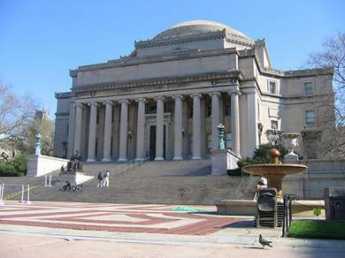
|
| Columbia University |
There are other opinions about what universities are, but Butler's famous oration that its library is the heart and soul of any university, is certainly defensible. It's thus plausible for what is happening to libraries to be the text here for what is currently happening to colleges. Librarians following best practices of their profession are engaged in a massive exercise in book-trading with each other, rather like the frenzied teen-age trading of postage stamps and baseball cards. Those books they have but don't much use, are traded off in return for books needed to complete a distinguished collection in whatever topic has been designated their "core mission". With efficient trading, a physical concentration of a thousand books on one topic is more valuable than the same thousand books scattered around the world and far more valuable than a thousand-book assortment of mixed messages collected in one place, which is how each library begins. Thus, having collected a higher assessment value, and a "distinguished collection" reputation, they are ready to face the threats to librarian existence from the Internet. For convenience if for no better reason, scholars in any particular topic start to congregate at a college which has a complete collection of books in their area of interest. In itself, this congregation of like-minded becomes a further attraction to other scholars. Ultimately, with a strong faculty in a particular topic, students with an interest in a career along such lines are attracted to specific colleges and become eligible to become graduate students and eventually teachers. Hidden in here somewhere is a means to advance many careers, and let's face it, to enhance faculty salaries. But it's sort of harmless, designed for the good of educational attainment and the intellectual enrichment of the nation.
Since about a quarter of a million students are constantly attending college in the general region of Philadelphia, several hundred institutions around here are continuously sorting themselves out in a gigantic archipelago of college libraries, each linked to variable football success and endowment size, specialized interests, and levels of talent. By the monograms on their sweatshirts, ye shall know them.
It surely goes too far to blame all this on Nick Butler, or a national conspiracy of librarians. We are engaged in a massive national effort to expand the excellence of our colleges and universities, to meet the transformation of our society from the industrial to the information society, and to maintain our leadership among developed nations. Fifty years ago, the Economist tells us, only three American universities could compete with Oxford and Cambridge; nowadays, at least thirty are better than anything in Europe. Judging from the present vicious scramble for admission to prestige colleges, the market could immediately absorb fifty more premiers, highly selective, world-beating universities. So, say a thousand college presidents, why not us?
In my opinion, you can see here a main underlying justification for college tuitions of fifty thousand dollars a year, per student. The individual parents say they can't afford such tuitions, and so the nation as a whole may possibly not be able to afford them, either. So far, at least, no one questions that an informal Marshall Plan for colleges is a good thing. Whenever you see a situation universally accepted like that, look out. What everybody knows, is often not worth knowing.
Among other things, American education is also headed for the specialization trap. It's rapidly becoming apparent that employers undervalue a liberal education in the people they hire; it won't take those eager beavers long to figure that out when they apply to college. Here's a tip, kids: a chemical engineer can expect to make a much larger income than a chemist. The Human Resources employees of Walmart and Microsoft were not elected to shape the future of graduate education, but that's who is going to do it if we follow present trends. If it's too strong to heap blame on industry's front men, take a look at the leaders of industry; it's rather easy to assess the academic credentials of, say, the board of directors of any local country club for their ability to shape academic policies. Whoever is making educational policy, let's restrain the growing dominance of pre-employment training in our national goals for a liberal education. Maybe it wasn't so bad when clergymen were in charge of colleges.
Other internal trends collide with external vocational pressure on colleges. The committee chose to select the concentration areas for a college library soon notice that it is easier to become notable for a rare and obscure subject than an important recognized one. Will, that leads to a desirable outcome? Everyone has a dozen editions of Shakespeare, and you can be very certain that Oxford, Cambridge, Harvard and Yale all have distinguished collections of Elizabethan literature, associated with famous scholars. Why in the world would a small struggling college try to collect Shakespeare books or Shakespeare experts? Furthermore, it is probably possible to buy a tape recording of the most distinguished Shakespeare scholar in the world, giving a breath-taking lecture on the second Act in Hamlet. Could the new Assistant Professor of Literature in a small college compete with that tape recording? On the other hand, should our most struggling colleges specialize in minor obscurities?
In fact, anything the small college teacher could say would seem shabby by comparison with the world-acknowledged master of the subject, holding forth with the lecture that made him famous. And so, one wonders, whether the current fashion to sneer at the Canon of books, written by "dead, old, white men" is not a way of avoiding comparison with performances that have survived the much hotter competition. If you carry this a little further, you can see a pressure to avoid offering courses in subject areas which centuries of serious consideration have designated to be the best that civilization offers. The top of the cultural heap has risen to the top because many generations have found what deserves to be there; one would normally suppose those topics, those authors, would be the ones you would want to study if you yourself aspire to be considered an educated person. But if present trends continue very much further, you may find that colleges which have decided to specialize in minutiae are in addition avoiding exposure of the students to what our culture considers to be the best. This is one of those things where a little is probably pretty good, but too much of it is destructive. A well-financed, highly talented college applicant can go to a place where the best of our educational product is presented in an outstanding way. Less competitive student applicants may be faced with a choice between bizarre topics, taught very well, or outstanding subjects taught rather poorly. Or, perhaps worst of all, forced to drop down to a lower rung of the academic ladder, where teaching aspirations are low in every topic so only Shakespeare, Dante, Plato, Dickens and the like can overcome deficiencies in the way they are taught.
A quick look at the other end of the spectrum gives the same thought a different twist. The universities which can afford to be insanely selective of their entering student class can also afford to ignore them. Intensely motivated, supremely talented kids, will surely succeed no matter how poorly their courses are taught. They will work hard, mainly to compete with their classmates, who are just as competitive as they are. In fact, it is surely already true that the peer pressure from their classmates has a stronger direct influence on their achievements than the faculty does. Perhaps the faculty has a strong influence indirectly, just as the president of the University is a role model five times removed. If we do not somehow reconsider the processes now underway, the archipelago of colleges will become little more than a postal sorting machine, doing its best to avoid leaving many imprints on the envelopes except a score. As the CEO of America's largest investment banking firm once told the people doing his hiring for him, "Harvard, Yale, Princeton -- Princeton preferred --, 3.6 or better. We don't care what they majored in." With a little more sophistication, displaying just a little more insight into the process, he might have added, "But make certain that what they majored in, was rigorous." If it ever gets to the point where the label you wear is more important than the training you received, the power of universities to set their own prices, select their own customers, and define their own product will have come to the end of the trail. Judging by other industries, that time will probably occur when America finally succeeds in building more first-class university campuses than we can use.
Colleges and Religions Drift Apart
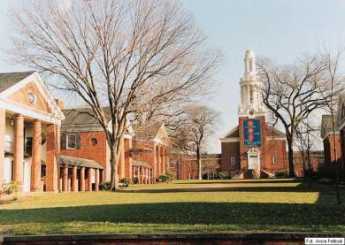
|
| Yale Divinity School |
Until fairly recently, academic institutions have existed as an outgrowth of religion, sort of enlarged monasteries charged with acting in loco parentis. The Catholic Church in Europe had its medieval universities, but could probably have got along without them. It was Protestantism, especially American Protestantism, which needed a place to train ministers. Harvard, William and Mary, Yale, Princeton and the other early American colleges were established to train ministers. If there was room, they sometimes took students with no intention of entering the ministry; more often, the non-ministers had enrolled with a religious vocation but drifted away from it. In time, the professional schools of medicine and law joined theology as learned professions, and of course, the colleges needed a supply of educated teachers for themselves.
And so it evolved that colleges and universities of the Philadelphia region almost always had religious sponsors, sometimes rather remotely connected, and among Catholics, the different Orders had their own colleges. Temple had Baptist origins, Princeton was Presbyterian, Eastern University was originally Eastern Baptist Theological Seminary. There is Moravian College, and so on. Since this was once an entirely Quaker region, we have Bryn Mawr College, Haverford College, and Swarthmore, although the Quakers were slow to trust the idea of colleges, since they hoped their members would remain unmoved by clergymen. The other dominant religion of the colonies, the Anglicans, split off from the British church as Episcopalians and then got somewhat scattered by the awkwardness that many Anglicans were Tories. The non-Tory Anglicans tended to wander off into Methodism, a form of Episcopalianism formed by non-ordained leaders cut off from British influences by the Revolution. The Presbyterians, however, were the heart of the American Revolution; their Scotch-Irish ancestors had no trouble saying what they thought of the British. With the attainment of Independence, they prospered as victors. Gradually, the original idea of a college to train ministers evolved into a college to teach future lay leaders of religious groups about their faith. Hidden in this transformation of the schools was an acknowledgment that leadership was migrating away from the clergy. Even the Atlantic Seaboard Quakers, who always declared they had no truck with clergy and had no fixed doctrine to teach, grasped the central point of this and formed their three colleges so that Quaker children could acquire a Quaker education, and presumably, find other Quakers to marry. That was the slogan of the times, but the underlying realization was that the enduring values of religion are guarded and promoted by an educated elite, not an ordained clergy.
This drift toward what is called secularism had some peculiarly Philadelphia variants. The University of Pennsylvania was founded by Benjamin Franklin, a deist, and has never had a divinity school, although it has a school of religious studies. A deist is someone who believes that something called God may have created the world and established its rules. Perhaps so, but since that original and final act of creation, God has simply left the world to run along on its own. Out of this arms-length piety and the dissensions of the Revolution, grew up the tradition of wealthy Philadelphia families sending their children to Harvard and Yale if Episcopalian, and to Princeton if Presbyterian. Princeton was a natural direction to take during the 19th Century when wealthy estates occupied the banks of the Delaware River all the way up to within walking distance of Princeton, and the River was the main highway. This hurt Ivy League University of Pennsylvania by draining off sources of support, either toward other Ivy League schools or to the trio of Quaker colleges. It particularly hurt Penn's undergraduate college, since the Quaker Colleges, and Princeton, held back from forming professional and graduate schools, and looked to send their graduates to Penn after the formative undergraduate years. Dickinson, Franklin and Marshall, Ursinus, Muhlenberg, and Lafayette did the same, remaining content to provide a sound liberal education rather than training for a career. Consequently, an opportunity was created for free-standing graduate schools without an undergraduate base, like Hahnemann, Women's and Jefferson Medical Colleges, or Lehigh and Drexel for engineering,, Moore School for Art. Mergers and academic imperialism have tended to push all of these free-standing units toward fuller university status. All in all, nearly a quarter of a million students now attend colleges in the Philadelphia region, and almost a million in the broad exurban area, depending on what you call a college. But a sound liberal and practical education has long ceased to be the same as a sound religious one.
Meanwhile, religion has lost its dominance in American life. Things reached some sort of climax in 2000 when Yale University officials contemplated closing the Yale Divinity School. It was said to be an expensive distraction, out of the mainstream of University life. Momentarily forgetting that the teaching of Divinity was the main reason for founding the University, those former flower children of the sixties, now fortified with tenured rank, abruptly learned that religious feeling in America is not entirely dead. Dying, perhaps, but not so dead as to forget the legalities of restricted endowment funds.
The next step in this evolution is not so clear. In 2006, while the majority of older colleges may be concentrated in "blue" states, the majority of Americans nevertheless live in "red" states, where religion is both strong and actively displeased with ceding spiritual leadership to secular universities. The decisive outcome becomes whether this topic is deemed mainly educational (decided by professors), or mainly religious (decided by clergy). At the moment it is not decisively either one.
Financing a Research University

|
| Harvard |
Fifty years ago, only three American universities, Harvard, Yale and Princeton, were considered world-class. The benchmarks for them were Oxford and Cambridge Universities; both British universities had long history and great prestige. Making allowance for wartime disruption, it was also considered pretty classy to study at the Sorbonne, or Humboldt University in Berlin. Sweden, Vienna, Rome were right up there in prestige.

|
| Oxford |
By 2004, a London magazine was offering its view there were thirty American Universities better than anything in the European Community, in particular, Oxford and Cambridge. We'll pass over the Economist's anguished analysis of what's wrong in old Europe, and focus here on what American universities are doing right. They certainly do seem to be doing something right, but nevertheless, it's still possible to be uneasy about where they are going.
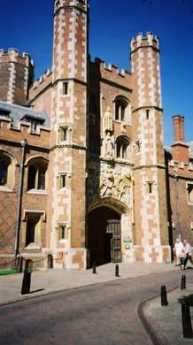
|
| Cambridge |
For example, the top three all have more than ten billion dollars apiece in their endowment funds, and thus each perpetually generates roughly half a billion annually in disposable income from passive sources. You can accomplish a lot of worthwhile academic things with that much money. Operating revenue like student tuition, fees, research grants, and royalties should support normal running expenses, so endowment income is available for new frontiers of learning, research, and social endeavor. These well-run institutions unquestionably do accomplish many innovative and important advances, to the point where it is simply trivial to point out a few areas of waste or misjudgment. Multiplying their annual discretionary funds by thirty offers an overwhelming force for good in the nation, and in the world.
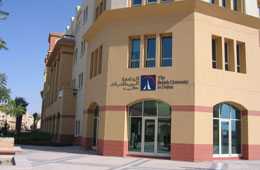
|
| British |
The other twenty-seven premier research universities may not all have ten billion dollars apiece, but they have the Avis or we-try-harder motivation that may make up for it. The nation really does appreciate its worth. Applications for admission outnumber available places twenty to one, would be even greater if more people thought they had a chance to get in. Outstanding professors are in scant supply, commanding higher and higher salaries. In fact, a patient of mine who is a trust and estate lawyer tells me he gets a little uneasy about the growing number of university professors he sees with million dollar estates. A calm view would be that the nation recognizes the value of superior education, and is forcing the pace for a greater supply of it. Unless our economy experiences a disastrous decline, it is reasonable to expect a hundred universities to migrate up the quality chain in the next generation; most of those eligible for it are grimly determined to see it happen. China can make all the widgets it pleases, but that won't make them catch up with this champion competitor. The French can maybe make better wine, but unless they pep up their schools, they're going to have no shot at glory.
Whew. That's intentionally laying it on thick because American academic triumphalism has a darker side to give one pause. In the first place, the arrogance of it shows. Even the European aristocrats, formerly world experts in flaunted put-downs, are irritated; and red America is really sore at blue America. Sprinkling a few research universities into Arkansas and Idaho might relieve regional divisiveness somewhat, but lasting social peace can only derive from starting in the third grade of, say, North Philadelphia, Kensington, and Norristown. In economic downturns, the country would have big trouble financing universal, bottom up, academic excellence. The tragedy is that money isn't the main problem in the science classes of the thirty research universities we already have; an alarming number of those seats are filled with foreign-born students, not even to mention the honors students.
Secondly, the system is already under strain. The families of students are hard pressed by tuitions of fifty thousand dollars a year, and increasingly ready to complain about the inability, of classes of three hundred taught by non-tenured teachers, to justify to them such breath-taking fees. They may not understand educational financing, but they can count, and then multiply two numbers together. Faculty rewards favor research, not teaching, and teaching is what the students think they are paying for, their parents think they are sacrificing for. If what they are truly paying for are just credentials, they worry that affirmative action will cheapen the credentials. One clear sign of unease is the tendency of children from wealthy families to walk about the campus in torn overalls. This may be more than just a fad, it may be a sign they hope to hide from the university's system of redistributive taxation. Some people pay those high tuitions, but mostly tuitions are discounted for the eager family's ability to pay. Wearing blue jeans won't help, the universities demand to see the family's audited tax returns. In my presence, a university president remarked that the system was designed to extract the last dime from every student. The whole middle class is being asked to give until it hurts, for the unspoken goal of elevating a hundred more research universities to world class. Very few question the premise that unmatchable universities are the key to American world eminence. Quite a few, however, have anxiety that it may not work out for each individual. It may only be a lottery with slightly better odds.
Now, let's get to the research part of the research university. In the past ten years, American universities have collectively received six or seven billion in commercial patent royalties; the aggregate now runs appreciably more than a billion dollars a year and it's growing.
The normal arrangement is to give 20% of royalty income to the professor whose name is on the patent. Since most research is performed by large teams, it is possible to imagine considerable inequity and academic bad feeling in this system. In other walks of life, striving for a bigger share of two hundred million a year would cause differences of opinion about fairness. Here and there, you read articles by participants in this system who are concerned over the message it is sending to the students about personal values. Universities that began with a mission to educate the clergy are now seemingly overpraising the big payoffs.
Many business analysts feel that a successful corporation needs to spend 10% of its revenues on research and development. Behind that is a realization that prices and profit margins are largest for new inventions, steadily declining as the new invention attracts competition and eventually becomes a mere commodity. The scientific term entropy is a perfect description of the way world economies seemingly work, like clocks gradually winding down. So businessmen get rid of old products and look for new ones, and the universities are the source of most new ideas and products. Put every last cent into R & D for new products, while the developing countries grind out widgets. If we eventually graduate hundreds of thousands of Americans from unmatchably excellent research universities, the outcome will take care of itself. Even flying airplanes into our tall buildings can't make much difference in this academic arms race. It's essentially how Ronald Reagan defeated the Soviet Union, and it's discouragingly difficult to argue it is totally wrong.
However, you can imagine ways that it might all fall apart. The source of at least half the capital now pouring into the research universities comes from the federal government, particularly the National Institutes of Health, the National Science Foundation and the Department of Defense. It only takes fifty-one votes in the U.S. Senate to change that suddenly, for reasons of national defense, to defend the value of the dollar, to combat inflation, or lots of other reasons. Even now, universities often face annual crises at the end of a funding cycle, when projects have been awarded, people hired, but funding is delayed for uncertain periods of time because of distant political wrangles within the budget process.
That's known as a cash flow problem, and even it is trivial compared with what would happen if federal research funding were delayed a full year. Just look at any university and see all the big tall buildings. They have largely been built to house research activity, and the university would have big difficulty selling them if they were empty. They've usually been paid for with mortgages, and it costs a lot of money to heat, air condition, clean and repair them. Just cut off the cash flow long enough, and you will see how risky it was to get into the research arms race.
The University City
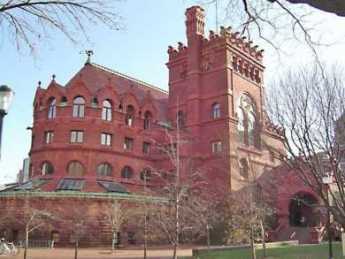
|
| University of Pennsylvania |
In 1920, the University of Pennsylvania graduated 34 students with B.A. degrees, and 134 with M.D. degrees. Today, the campus is a little self-contained city of 50,000 inhabitants. The transformation of the campus during that period is an outward expression of revolutionary expansion of the student body, involving demolitions, restorations, new construction. And the nearly constant shortage of parking space.
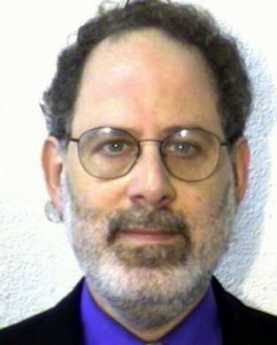
|
| David Hollenberg |
David Hollenberg, the University Architect, recently gave the Franklin Inn Club an interesting description of the University from the point of view of bricks and mortar. Since almost every building on the campus is undergoing or plans to undergo a major building project, he had a lot of material to cover. The disappearance of the railroad-based industrial area of West Philadelphia has been an economic problem for the city, but of course, this abundance of vacant land has created a major opportunity for the University of Pennsylvania. One reflection of this abundance is the opportunity to become the developer for much of the whole region around the campus, working with private developers who wish to be in the University area, and are therefore willing to coordinate their plans with those of the University. It's a remarkable opportunity. Since it comes at the time of a major economic downturn, one can only hope that the University does not impoverish itself taking advantage of this good luck.
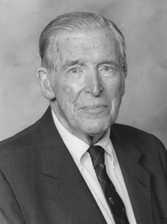
|
| Jonathan E. Rhoads |
As the graduation statistics illustrate, not so long ago the University was largely a medical school, with appendages. There are rumors of considerable friction from time to time, between the President of the University and the Dean of the Medical School as to who was boss; it is easy to imagine the trustees swinging from one side to the other. The most notable Provost of the University in modern times was Jonathan Rhoads, who also happened to be Professor of Surgery. If you know Quakers, you know that disputes were seldom rancorous. And if you know Jonathan, you know he almost always won the disputes.

|
| Cira Center |
While today, the dominant change is caused by the Cira Center buildings and the acquisition of the former Post Office building, it is well to keep in mind that the new Cancer Center is a billion-dollar project. A great deal of the medical school expansion is centered on burgeoning research, particularly in molecular biology, largely financed by the National Institutes of Health. While the leaders of the NIH have long struggled with Congress to keep politics out of both the administration and the substance of research, it seems to old-timers that the politicians are slowly winning. Senator Specter's seniority on the Appropriations Committee may have had as much to do with the prosperity of West Philadelphia, as the quality of research, however eminent. We are about to find out, and if things go hard with us in favor of say Chicago, it could be a wrenching experience. Most of those research buildings cost more to heat, air-condition, insure and clean than the entire tuition base of the students; and they wouldn't be good for much if you tried to sell them.
The University is almost unique in being located on contiguous land, near existing public transportation, and occupying substantial old structures capable of renovation to new purposes. Mr. Hollenberg was asked whether it was cheaper to grow like this within a city, or whether it is cheaper to plant a totally new university in several open corn fields, as we often see happen. While this is a hard question to answer, and depends to some extent on the type of architect in charge, it is his view that big-city restoration is a considerably cheaper way to expand than building from scratch on open land, although if you are starting the institution itself from scratch, there isn't much choice but the cornfield.
And then, there is the ancient argument between academics and bricks and mortar. Development officers agree that it is easier to raise donations when you can name a building for the donor; grand visions for new frontiers of teaching are a much harder sell. So a question does hang over this expansion, however exciting, whether the endowment will keep up with the structures, once the excitement of physical expansion dies down. These are definitely things to worry about, but right now you seize the opportunities as they go past, leaving integration to your successors to figure out.
------------------------------------------------------------------------------------------------------------------------Paying for College I
It's almost two platitudes that during the Nineteenth century America changed from a largely agricultural nation into a largely industrial one. And toward the end of the Twentieth century, we are going on from an industrial economy toward a service economy. This latest shift of direction is one of the main causes of soaring college tuition costs. Demand for first-class college education grows faster than price increases, competition, and internal efficiencies can seemingly control.

|
| College Cost |
Tuition costs at the top of the educational pecking order have now reached $52,000 annually, with room and board and other costs sometimes adding another fifteen thousand. Attending college already costs well in excess of the average after-tax income of working Americans, perhaps even in excess of the average income of college graduates. College costs regularly exceed the disposable income of undergraduates' parents and must be temporarily subsidized while the nation collects its wits, but subsidy cannot be a permanent solution to a problem so large. Average incomes of college graduates do exceed the average income of those who only finish high school. That extra income is gamely said to justify the investment, even taking into account the invisible loss of 4 years of earnings, perhaps even a trailing six-figure indebtedness. However, a meaningful score can only be toted up in retrospect, after inflation and taxes work their way into a net-net appraisal. Faith in some postulated answer to this accounting puzzle colors various belief systems, like: How much should we worry about widening income gaps between any income segments? What is the particular value to society of income redistribution between those who pay full tuition and those who receive financial aid?. There could be legitimate questions about many other values throughout the whole system. During the Vietnam War, many uncomfortable questions were raised about the educational system, even leading to riots on college campuses. It was often implied that many students were in college merely to escape the military draft. While that may have been precisely what was in many minds, the scramble for elite college admissions has intensified since the end of the draft, seemingly proving a college education has other merits. Steadily rising tuition costs are rapidly narrowing the income advantage, so one supposes the intrinsic merits of higher education can soon be measured by whatever enthusiasm for admission survives the bursar's bite. There are a few reasons for doubt, many reasons for anxiety.
In the first place, undergraduate tuition charges are poorly related to underlying instructional costs. It is natural to expect some markup for any product on sale, and some cushion for the unexpected. However, the difference between the tuition for night school and day school is a pretty disconcerting example. Comparatively few universities offer the same undergraduate courses as night-school courses, but a number of them do. The tuition for regular undergraduate courses is about average, somewhere around $5000 per course, but the tuition for night school is around $1200 per course -- same teacher, same textbook, same exam. Without access to the accounting data, one is led to suppose the tuition for night school comes pretty close to the true instructional cost of these courses. And therefore led to the supposition that the 300% markup for undergraduates implies that undergraduates, blue jeans and all, subsidize a great deal of unrelated activity throughout the university. This sort of discovery does not enhance the image of justice in academia.
In the second place, colleges can as easily re-direct surpluses into the endowment fund as out of it. They batter the concept of donor intent in both directions, breaking the linkage of tuition to underlying costs, and the linkage of donations to needs. Ultimately universities may be defined as mere steps to a higher income for wise investors, and cannot complain if proof of adequate return is demanded. Such accountability might even be a wise precaution, based on observation of the way Great Britain has made Oxford and Cambridge dependent on government subsidy, then subsequently allowing class warfare antagonisms to degrade the government contributions. These prestigious universities are now much humbled by transforming income inequality into a mark of shame. Unless American universities are designed to follow the same path, they will be forced to choose between competing for the way businesses do, or the way churches have traditionally done. Unfortunately, there is a reason to fear which was a college president will tip, with a cash register in one hand, and a begging cup in the other.
America is almost unique in its large proportion of small liberal arts colleges. No doubt, many of them would prefer to remain as they are, but it seems attractive to encourage thirty to fifty of them to become universities. When asked the differences, one college president replied the main difference is the presence of graduate students. Judging from the competitiveness of admission, the demand for graduate students is much closer to supply than at the undergraduate level; some tuition distortion reflects an effort to increase the supply of college teachers. Income prospects after graduation are probably an influence, but since the main occupational opportunity for graduate students is to teach undergraduates, increasing the openings for college graduates in a service economy must also imply matching the increase with more people to train them. However, only a minority of university undergraduates go on to become graduate students, so creating fifty universities also rebalances the incentives to become teachers. There are observers who advocate replacing teachers colleges with universities, a proposal which necessarily collides with the present informal dual-track system. High school teachers are mainly trained in teachers colleges, while university professors are products of graduate schools. The two streams are kept carefully separate because the commotion created by mingling them would probably be considerable. Nevertheless, this may be the rate-limiting step which will have to be addressed.
Mention of secondary education must be made, however, in order to grapple with the issue of automating education. It must be obvious that one distinguished Shakespearean scholar could replace thousands of lesser teachers of the same subject by the use of video recordings of the distinguished lecturer at work, both for introductory college courses and more advanced levels in high school. True, a small handful of pure scholars needs to be segregated away from the mass of college teachers, most of whom might prove to be graduate students. Face to face interaction is essential at every level of education of course, but automation holds such huge financial promise that greater experimentation and innovation seems inevitable. The education industry needs to make much more strenuous efforts to reduce its costs through greater adaptation to information technology if only to improve its ability to teach such adaptations to entrants into other industries. Shortening the school year, wider expansion of the Junior year abroad, and employing graduate students to teach, are debatable methods for reducing the cost of education; but an enthusiastic embrace of the computer revolution must improve educational quality before other nations leave us in their dust.
And finally, caution must be mentioned. Some degree of specialized focus of college courses is inevitable; we cannot develop scientists and engineers without it. But we must not eliminate the liberal arts, carelessly calling them luxury in a busy age. To a probably excessive degree, universities have replaced religions as a secular place to examine and teach young people how to live and behave. In little more than a generation, universities have a determined (long) hairstyle and (blue jeans) dress style, sexual morals, and political belief systems, mostly in a libertarian direction. That is not why we have colleges, or at least not why students must pay a quarter of a million dollars to experience them. There is another layer of intangible value in a liberal education, perhaps only perceived by personal experience. As I look back on a great many decades, I realize that almost every important step upward in my life was unexpected, almost unwelcome. Someone came out of the blue and offered it to me. Other people were watching and judging from behind some social bush. By contrast, almost every advancement that was strived for mightily, perhaps even a little too competitively, was to some degree gratuitously thwarted by others, often quite openly. Unobserved headhunters are watching for many qualities, particularly the ability to play this game. Spending some extended time learning what our society is all about through liberal education is a technique for self-advancement, too; universities would impair their customers' main chances in life by disturbing it.
Paying For College - II
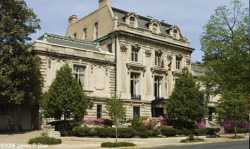
|
| The Cosmos Club Washington D.C. |
To begin with an anecdote, I belong to a Philadelphia club which reciprocates with the Cosmos Club in Washington DC. It's a handy place to stay overnight on the rather infrequent occasion of visits to Washington on business. It happened I had an early breakfast at the Cosmos and was the only guest in the dining room. A pleasant well-dressed man came in and asked if I minded if we sat together. "I'm Bob Goheen. I work at Princeton." Since he was widely known as the President of Princeton University, he was indeed welcome. He could hardly be expected to know my daughter was then a sophomore at his college, so he was, of course, unprepared for what I had to say.

|
| Empty Pockets |
After introductory pleasantries, I told him of my arithmetic problem. My daughter was taking five courses, so the family was paying ten thousand dollars a year, per course. Since most of her courses had over two hundred students in the lecture hall, the University was being paid two million dollars to teach each course. Was it possible I had got the arithmetic wrong? Mr. Goheen neither flushed nor displayed hostility, but his manner did change. Well, of course, the tuition pays for far more than direct teaching costs. It's expensive to maintain a first-class library, the University has a responsibility to help the town of Princeton with its problems, the University is proud of its very extensive scholarship program for needy students, there is research to be sponsored. Yes, said I, you have fallen into the trap I prepared for you. My complaint is that if I had donated money for those worthy causes, it would all be tax-deductible; but by having it extracted from me under the name of tuition, I was denied the tax advantage. As expected, he quickly changed the subject. And to his evident relief, I let him do so without resistance.
Since that time, I have had the opportunity to play the same game with several college presidents; not all of them have been suave about it. The only one who took me by complete surprise was the President of Lehigh University, who not only told me he agreed but added that he had made himself unpopular with his peers by promoting exactly similar ideas. There is a very serious problem, here. Somehow, the higher education industry has got to engage in some statesmanship because it is only a matter of very short time before someone proposes a government solution.

|
| National Institutes of Health |
It is possible to treat this issue as a problem of how to pay for universal college education, which would put it in a category now occupied by health care, and probably reach a political impasse for similar reasons. Or it could be treated as a problem of teasing apart the instructional costs from the research and scholarly costs. The problem to be solved, viewed from this latter direction, assumes that excellent teaching could occur, isolated from the scholarly activities, in the manner now accepted for secondary and elementary teaching. Conversely, research institutes with no teaching responsibilities are widely accepted in Europe, for instance, while in America the National Institutes of Health are their most prominent example of its workability. It can be argued that a scholar engaged in research makes a better teacher; it can also be argued that talent for teaching is not necessarily found in those with a talent for research. While it is true that some researchers are productive even in old age, for the most part, research is like poetry and sports, a young person's game. A creative scientist can usually look forward to acting as an administrator after reaching a certain age; why not instead look forward to a career in teaching? There appears to be no serious problem with this suggestion, except the nontrivial issue of relative prestige linked to ascending income. In summary, the question is whether we can afford to put another Harvard in every town of a specified size, or whether we will be forced to transform most existing colleges into enlarged high schools, as we build more of them. Obviously, that's a cheaper method, the question is whether it is a good enough product. Whatever the model to be mass produced, the overall cost would be reduced by stripping out populations who do not need so much education, and getting Google or IBM, or someone similar, to apply massive amounts of information technology to reducing the cost. In achieving universal health care, by contrast, we can reasonably foresee research reducing most of the delivery costs we now contend with, even eliminating some of the major diseases. In education for a service economy, the potentially increasing educational need is unfortunately endless.
Therefore, no matter what pattern we adopt, it must be organized to be in competitive tension with the manpower needs of the economy, rather than unmeasurable goals like becoming well rounded. If the reason we need a vastly more educated population is to supply better-educated graduates to run the economy, some kind of tension must exist between the two, or the educational establishment will ruin us with purposeless expansion, just as some elements of the healthcare industry might wish to do with their services, and almost all trial lawyers unashamedly wish for in their area of expertise.
In this area of economic design, lies the answer which President Goheen should have made to me in the Cosmos Club. By asking for a massive tax deduction, I was yielding to the idea that education was always a responsibility of government, always paid for by rejiggering the tax code. In that direction lies disaster, since control of the tax code lies in the realm of politics and leads to populist solutions. We must not unbalance power relationships so that economic leaders, asking for a better-educated workforce, are not eventually confronted with crippling taxation for the betterment of bloated academia. A typical college has as many employees as students. We cannot get caught up in an unrestrained process leading to half of the population teaching the other half, except for those who have retired and receive a pension from both activities. Rather, this expensive quest for quality must be seen as the other half of the immigrant's dream, which is no longer that of average performance in an industrial economy, but rather that of excellence in a service economy.
The University Museum: Frozen in Concrete
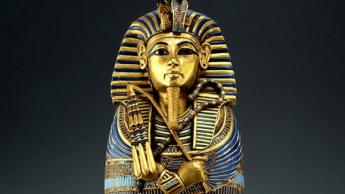
|
| King Tut |
Recently, a charming archeology scholar from the University of Pennsylvania, Leslie Ann Warden, entertained the Right Angle Club with the interesting history of King Tut. Interest in this subject is currently heightened by a traveling exhibit of the tomb relics currently on elegant display at the Franklin Institute. However, Philadelphia also has a permanent exhibition of Egyptian artefacts lodged in the University Museum. Since this museum is the second largest archaeology museum in the world, after the British Museum, that makes it the largest in America. An interesting sidelight is that Ms. Warden spoke in the grill room of the Racquet Club, which was the first effort by William Mercer to use "Mercer" tiles in a building. Mercer at that time was the curator of the University Museum. We learned from Ms. Warden that King Tutankhamen was unknown before his tomb was discovered, all records of this part of the Egyptian dynasty having been lost or deliberately obliterated by successors. Therefore, the discovery of these magnificent art objects started a massive expansion of scholarship about the entire Third Millenium.
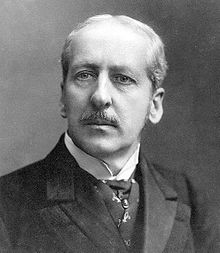
|
| William Pepper |
The establishment of the University Museum around 1890 was apparently mostly due to the enthusiasm of William Pepper, then Provost of the University of Pennsylvania. What seems to have got Pepper going was an expedition to Iraq, the place where civilization began, in Mesopotamia. The relics brought back from this celebrated effort needed a home, and Pepper decided it had to be here. One famous philanthropist after another, often in the role of Chairman of the Board of Trustees, carried on the tradition after Pepper's premature death. Some of them have their names on buildings, some declined. To a notable degree, the feeling of special possession was exemplified by Alexander Stirling Calder, who turned the statues in the garden to face inward rather than out toward the street. Asked whether a mistake had been made, he is said to have replied that due to the Museum's withdrawn character, it was more appropriate for the world to face the Museum. No more icily accurate comment has ever been made about the University's relation to its city neighbors.
The real knock about the Museum is that too much has been crowded into too little real estate, and the fault lies with the automobile. After the University outgrew its space at 9th and Market around 1870, moving then to West Philadelphia, the architects and the donors originally envisioned a grand boulevard of culture stretching from the South Street bridge many blocks westward. The Museum, Franklin Field, Irvine Auditorium, The University Hospital were to be the start of an imposing array of culture. Unfortunately, that was a horse-drawn conception, soon to be overwhelmed by the worst traffic jam in the city. The Schuylkill Expressway was the final blow, setting huge auto-oriented structures in place where their easy removal became difficult to imagine. The 1929 stock crash, followed by confiscatory income and estate tax rates, merely emphasized the plain fact that restoring the grand vision was beyond the ordinary aspirations of even massive private wealth. Transforming the imposing plazas of the University Museum into parking garages was probably a result of excessive despair, but if you have ever tried to find a place to park in that region you can somewhat sympathize with the small-mindedness which prompted it. Bringing back this region is going to require immense vision and resources, neither of which is exactly thrusting itself forward at present. So, unfortunately, one of the central cultural jewels of the City is buried in the midst of an impenetrable thicket of concrete and speeding automobiles, too big to move, too small to burst its bonds.
It's well worth a lot of anybody's time, and many visits. If you can find a way to get there.
Pyramid-Building, Greatly Simplified

|
| Egyptian pyramids were supposed to be built |
Everyone who went to Sunday School knows the Egyptian pyramids were supposed to be built by huge numbers of slaves, quarrying stone blocks, transporting them with only crude rollers, and setting them precisely in place under the supervision of slave-drivers with whips. The number of stones has been estimated, a reasonable time estimate made for carving a block, and modern scholars have calculated that every single person in Eqypt must have been either a slave or a slave-driver. In fact, there is a theory among British scholars that such a mobilization of the entire nation could only have been motivated by religious fanaticism, since it's so hard to imagine keeping a nation at work involuntarily in the hot sun for twenty or more years, even with whips.
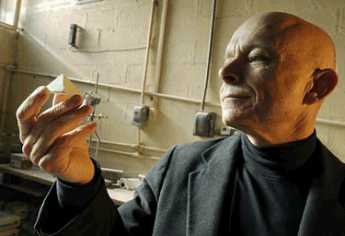
|
| Michael Barsoum |
As recently described to the Right Angle Club by Professor Michael Barsoum of the Ceramics Department of Drexel University, we probably have to revise our views. A "Eureka" moment seems to have first arrived for a French Professor named Joseph Davidovits several years ago, with the thought that perhaps the building blocks of the pyramids may have been cast in place rather than carved. Poured concrete, so to speak, rather than carved out of a quarry and pushed over the desert in some fashion and hauled up into place. Since the blocks seem precisely chiseled to fit together exactly, it has always been hard to imagine how this was done, when the Egyptians were thought to have no iron tools, only pure copper as a metal ingredient, not even bronze.

|
| Khufu Pyramid |
The insight was brilliant, although the evidence for it was weak, and it has been pretty easy to pick holes in the proposal. Poured concrete is much easier to reconcile with the remarkable leveling of the stone blocks, where the bottom level of the Khufu pyramid is the size of eight football fields but only varies from true level by one inch overall. Exploratory cuts into the sides of the pyramids reveal the component stones to vary enormously in size and shape in the interior, although the exterior surface is quite smooth. Similarly, the lateral sides of the pyramids vary from true north by only 1/15 of a degree, a remarkable achievement for stone cutting with primitive tools. Broad Street in Philadelphia supposedly runs North and South, for example, but it deviates from true north by six degrees. The pyramid builders, like the architects of ancient Beijing, must have used the Pole Star for orientation, rather than a magnetic compass.
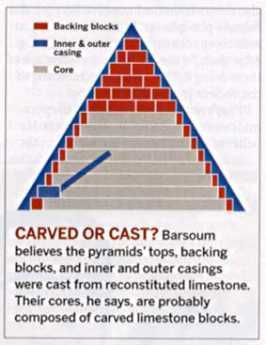
|
| Carved or Cast |
While Davidovits got this line of thinking started, Michael Barsoum has considerably advanced the proof of idea by addressing a large number of nitty-gritty questions about just how all this might have been accomplished. For example, the science of ceramics shifted the idea from the Portland Cement model to a recognition that the calcium in the cement came probably from diatomaceous earth, which is to say the crushed skeletons of diatoms on the ocean floor. Microscopic examination of the cement reveals large numbers of intact diatoms, with the cement layer surrounding the limestone aggregates. Furthermore, analysis of the stones shows that the outer shell of the pyramid was cast concrete, but the interior main mass was composed of stone rubble of various sizes and shapes. The apex of the pyramid was pure casting, probably because of the difficulty of fitting exterior and interior stones at the point. So, the Drexel team carried Davidiovits' idea from a general concept to a practical description of how the construction was probably accomplished. Carbon dating was attempted, but this technique stops being accurate for such remote time periods.
To nail down the idea that Philadelphia really explained how to build pyramids, funds are being collected for the construction of a 27-foot model pyramid in Logan Square. Let's hope the community gets behind this effort, which is both scholarly and entertaining, with an element of international competition mixed in. After all, Philadelphia is still smarting from the erection of the Eiffel Tower, six feet higher than Philadelphia City Hall, as the tallest structure in the world at that time. Let's be clear about it: the Eiffel Tower was the tallest structure in the world, while our City Hall remained the tallest building.
B. Franklin, Scientist
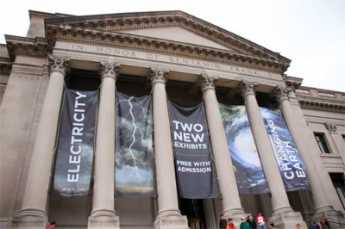
|
| Franklin Institute |
FROM time to time, the Franklin Institute has a display of its own and other museums' collections of the scientific instruments of Benjamin Franklin. It's well worth anybody's visit when it is available because the beauty and craftsmanship of these instruments alone make them remarkable works of art. Franklin was financially able to retire at the age of 42, and it tells you something of the 18th-century culture that Franklin took up scientific experiments in order to be like other independently wealthy gentlemen. Science, or natural philosophy, this seems to have been in a class with getting a coat of arms and having his portrait painted, all of which cheapens our view of Franklin as a scientist.
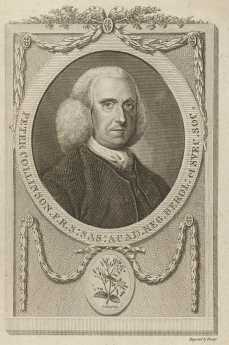
|
| Peter Collinson, F.R.S. |
In fact, Franklin was conducting an active correspondence with other scientists interested in electricity for many years, in particular, one Peter Collinson, F.R.S. in London. Collinson collected thirteen of Franklin's letters about his experiments, the earliest dated 1747, and printed them in 1751 as an 86-page book called Experiments and Observations about Electricity . By 1769, several more letters expanded the book to 150 pages, almost all of them describing reproducible experiments in great detail. The kite and key episode are described, but soberly and sparingly. Without making the point too graphically, an appendix was added describing how lightning had been used to kill some turkeys, so a somewhat increased power would probably be enough to kill a person. Franklin recognized that something was moving from here to there, that it had positive and negative charges, and that it was possible to store it up in a storage battery. He recognized the difference between substances that would conduct electricity and other substances that would act as insulators. Later on, he would discover that the torpedo fish stores and transmits electricity, suggesting that somehow animals made and used electricity as part of life. And of course, he put the discoveries to practical use as lightning rods, which he refused to patent.
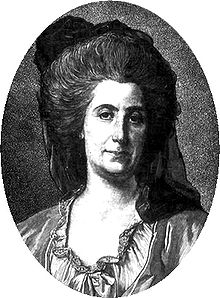
|
| Madame Helvetius |
By the time he went to England and France as a negotiator, his wide acquaintanceship in the scientific world was happy to introduce him to other famous people, like kings, Voltaire, Mozart, and Madame Helvetius the wife of the Swiss philosopher, the only woman to whom he is known to have made a proposal of marriage. When someone mentioned standing before a king, he replied he had stood before five of them. King Louis XVI, for example, appointed Franklin to a four-man committee to investigate hypnotism, then being touted as "animal magnetism" by Franz Mesmer. The other three committee members were unfortunately also destined to become acquainted with the guillotine: Brother Joseph-Ignace Guillotin himself, and two future victims of the invention, Antoine Lavoisier the discoverer of oxygen, and Jean Sylvain Bailly who first calculated the course of Halley's Comet, not to mention Louis XVI himself. It is not easy to think of any other scientist who was able to mix his scientific fame with changing international history, acquiring in the process the sobriquet of the founder of the American diplomatic corps. But then, he was witty as well as smart, and his career is a warning to those who now hope to devote their whole lives to being admitted to a prestige college and then coasting on its reputation. Franklin, it should be remembered, dropped out of school after the second grade.
A Toast to Doctor Franklin
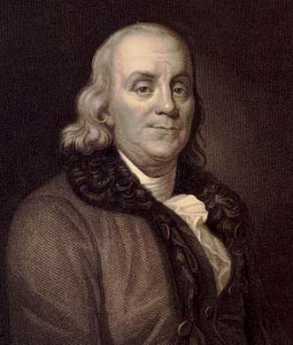
|
| Benjamin Franklin |
Benjamin Franklin's formal education ended with the second grade, but he must now be acknowledged as one of the most erudite men of his age. He liked to be called Doctor Franklin, although he had no medical training. He was given an honorary degree of Master of Arts by Harvard and Yale, and honorary doctorates by St.Andrew and Oxford. It is unfortunate that in our day, an honorary degree has degraded to something colleges give to wealthy alumni, or visiting politicians, or some celebrity who will fill the seats at an otherwise boring commencement ceremony. In Franklin's day, an honorary degree was awarded for significant achievements. It was far more prestigious than an earned degree, which merely signified adequate preparation for potential later achievement.
And then, there is another subtlety of academic jostling. Physicians generally want to be addressed as Doctor, as a way of emphasizing that theirs is the older of the two learned professions. A good many PhDs respond by rejecting the title, as a way of sniffing they have no need to be impostors. In England, moreover, surgeons deliberately renounce the title, for reasons they will have to explain themselves. Franklin turned this credential foolishness on its head. Having gone no further than the second grade, he invented bifocal glasses. He invented the rubber catheter. He founded the first hospital in the country, the Pennsylvania Hospital, and he donated the books for it to create the first medical library in the country. Until the Civil war, that particular library was the largest medical library in America. Franklin wrote extensively about gout, the causes of lead poisoning and the origins of the common cold. By inventing bar soap, it could be claimed he saved more lives from the infectious disease than antibiotics have. It would be hard to find anyone with either an M.D. degree or a Ph.D. degree, then or now, who displayed such impressive scientific medical credentials, without earning -- any credentials at all.
Beyond Most of Us
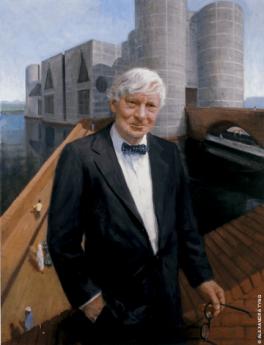
|
| Louis I. Kahn |
The Athenaeum is slowly migrating into a national historical museum of American architecture. In this spirit, it recently presented a lecture by Carter Wiseman of Yale on the subject of Louis I. Kahn to an overflow audience. Professor Wiseman drew his remarks from his recent book about Kahn, called Beyond Time and Style.
Many giants of Philadelphia architecture, like Strickland and Walter, are known to us for the memorable public buildings they designed, but Kahn and Venturi are known for their scientific contributions to the theory of architecture. Their reputations were consequently made among architectural scholars, and then passed on to the public in the form of praise that is a little hard for laymen to understand. For example, Wiseman begins his course on Kahn by telling the students they probably will not understand Kahn at the beginning of the course, but all will revere him by the end of it. The rest of us, of course, have not attended the lectures, and a reciprocal effect probably has something to do with Kahn going to his grave, deeply in debt. No doubt the additional fact that he had three families with three women simultaneously, somewhat strained his cash flow as well.
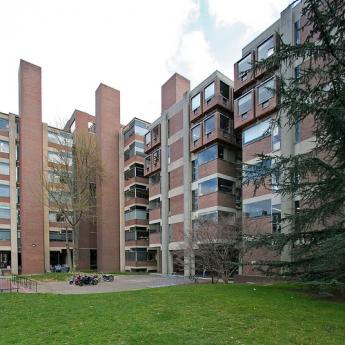
|
| Richards laboratory of the University of Pennsylvania |
Kahn encountered the architectural field toward the end of the period of Modernism, which he referred to as "machines to live in". Rather than overturn the whole idea of Modernism, he softened its harshness through ingenious use of interior lighting, and the use of rough rather than smooth shiny materials. His teaching was that closets, elevator shafts, corridors and the like were "servant" spaces, to be hidden and subordinated to "served" spaces, like reception areas. The overall effect was a deceptive simplicity, often regarded by the public as simple boxes when the underlying design was anything but simple. For some reason, the concepts of rough surfaces and subordinated spaces was particularly effective in India and Pakistan. It was least popular in his two famous American laboratory buildings, the Richards laboratory of the University of Pennsylvania, and the Salk Institute in La Jolla, California. Both of these laboratories were widely praised by architects, and resoundingly hated by the chemists who used them, because chemists are particularly fond of closets. He does have one group of particular enthusiasts among those who own and inhabit the tall glass office buildings which became so popular after the Seagram's tower on Park Avenue in New York. Washing all that glass is a problem and surfaces which don't look dirty so soon, gain advantage.
Professor Wiseman spared his audience the story of Kahn's death, presumably because it is so well known. He died in the washroom of Penn Station in New York, and his body lay unidentified in the morgue for three days. It is supposed that someone stole his wallet with identification papers, because there couldn't have been much else in it to steal.
Exit, Pursued by a Bear
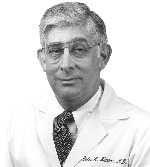
|
| John Kastor |
Everybody ends up getting fired in a recent book by John Kastor about recent events at the University of Pennsylvania just like everybody ending up dead in an Elizabethan play. The vital difference, of course, is that the dramatis personae at Penn can still relate to a bewildered audience their own versions of those grand events. To protect himself, the author peppers his book with more footnotes than a Ph.D. thesis. And thousands of stakeholders at the University can now realize that during those eventful times they were as clueless as Rosencranz and Guildenstern.
One basic fact about that institution is that the medical school spends three-quarters of the entire university budget. That leads to grudges in the little law school, the little engineering school, and the little president's office, as they knuckle under to the Golden Rule. The department chairman with the gold makes the rules. Since most of that gold comes from research grants, hence ultimately from the federal government, the medical students and the teaching faculty don't have the same power they had during the Vietnam War era, either. Although medical school tuition imposes a crushing burden on the students and their families, leading to debts close to a quarter of a million dollars apiece, the tuition money doesn't amount to much in the university scheme of things, either. In some schools, tuition amounts to two percent of the medical school budget. You could eliminate the students entirely and not see much difference in the "school".
Unfortunately, when you become dependent on government grants, you find they can suddenly be terminated, or awarded without funding, or held up for several months by Congressional bickering. Meanwhile, there are salaries to pay, contracts to fulfill. Even if you can furlough some of the staff, it's not easy to see what you do about a thirty-year mortgage on a research building when there is a lull in its research funding. If you try to save money, the granting agency will try to get it back; they aren't authorized to make grants to be squirreled away. If you shift money to unauthorized uses, you risk going to jail. And yet, if you don't do something along those lines, the whole enterprise can collapse.
Having said that much to be fair, it is still uncomfortable to see the financial transparency of our most valued nonprofit institutions vanish behind a Byzantine fog of secrecy, out of which arise the magnificent towers of new buildings, and in front of which an occasional limousine is to be observed. No wonder the research scientists feel the constant pressure to produce. A Nobel Prize every ten years, or so, would go a long way toward quieting envious remarks from the liberal arts faculty.
Housed in those ivy towers are three institutions, the teaching hospital, the medical school, and the university, with three boards of trustees, and at least three ruling potentates. At irregular intervals, congressional committees do things to the Budget Reconciliation Act which enrich one of the three components of the institution or suddenly impoverish another, or both. Integration of the three under one governance sounds plausible until you notice how radically different is the mission of each one. You can take a big building away from one component and rent it back to them, and things like that, but you can't do it without starting whispers about Enron. You can gather up surplus funds from one of them during the decade of the eighties, but you have trouble giving it back twenty years later. Officials at Blue Cross come snooping to see if health insurance premiums are passing through this shell game, ultimately paying salaries in the department of English Literature. Everybody distrusts everybody else, somebody sasses somebody, and everybody gets fired.
Nothing unusual about that. It happens at every medical school.
Please Don't Lose Any Sleep Over This
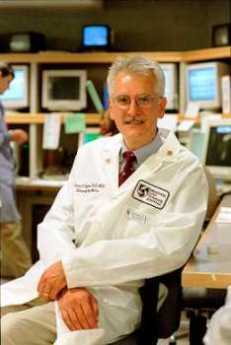
|
| Dr. Charles Czeisler |
The Institute for Experimental Psychiatry Research Foundation meets alternatively in Boston and Philadelphia, in recognition of its rather complicated historical relationship with Harvard and Penn. The Spring 2005 trustees meeting was held in Boston, with Dr. Charles Czeisler of the Brigham and Women's Hospital making a presentation of his work with sleepy resident physicians. Sleep is now a central focus of the work of the Institute, particularly the effect of lack of sleep on performance. Resident physicians are a group with lots of experience with sleep loss, so much that such experiences as residents are central imprinting in the lifelong brotherhood of the profession. The public tends to regard the torment of protracted craving for sleep as some kind of dangerous hazing inflicted on professional newcomers by sophomoric seniors. Every once in a while, someone gets hurt by these games. That seems to be a general public reaction. For the most part, by contrast, members of the profession who have themselves undergone the experience turn away silently from such unfeeling remarks. As the old contraceptive joke about the Pope has it, if you don't play the game, don't make the rules.
In the first place, it is wrong to suggest that resident physicians are somehow helpless victims of authority, abused slaves of somebody's profit motive, or warped masochists enduring the process in order to inflict it on someone else. Perhaps the example of my classmate Seibert is useful. As a freshman medical student, Seibert was so overwhelmed by the volume of facts he was expected to learn, that he decided to give up sleep entirely. Seibert, by the way, was no moron; he was an honors graduate of a very selective Ivy League university. And he actually did stop sleeping for more than two weeks until he collapsed and had to be stopped. This was his own choice, gamely adopted in spite of general ridicule. And to show that overachieving is not limited to physicians, there was my oriental patient, the daughter of the President of her country. She related that as a graduate student she did not go to bed for three years; during all that time, she sat at her desk, slapping her face to keep awake. What we are talking about here is a self-selected group of committed and dedicated people, perhaps overly shamed by the specter of failure.
The work of our Institute has helped document and understand the injurious effect of sleep loss on performance; no one can go very long without sleep before responses and vigilance begin to deteriorate. A great many vehicle accidents are caused by drowsy drivers; it is a concern that pilots of airplanes on long-distance flights are to some provable degree less competent to land the plane. Therefore, it is not completely surprising to find that interns on protracted duty do make 20% more errors in medication orders, and nearly 50% more diagnostic errors. It is jarring to discover a measurable increase in the number of intern auto accidents, particularly when driving home from work. Maybe we ought to pass a law about it.
Commiseration is one thing; proposals to interfere are quite another. For one thing, the time-honored protection against the harm of this problem is redundancy. The complex, fast-paced and dangerous environment of a hospital, like that of an airline cockpit, has very little tolerance for lack of vigilance. Our solution has been to do everything three times, with overlapping responsibilities and repeated opportunity for catching errors before they get through to the patient. Although the malpractice lawyer seeks to pin the whole blame on some person, particularly one who is covered by insurance, the reaction of doctors to adverse events is to presume that at least three people must have cooperated in letting it slip through. At night and on weekends, the reduced staff tends to weaken the defensive network. But by every assessment, the greatest threat to our protective screen of redundancy is cost control. Any manager of managed care can find duplication and overlap in ten minutes of searching for it in a hospital; redundancy is a big factor in the high cost of running a hospital. The law of decreasing returns will dictate that it becomes very expensive to eliminate the last one percent of errors. To state it in reverse: it is very tempting to save a bundle of money in a competitive world, by accepting only a small increase in the errors. Since it is a matter of opinion, physicians are grimly determined that it shall be physicians who strike that balance. Those who press for more punitive treatment of physicians in the matter of errors should reflect that it surely will convince physicians to flee the risk of responsibility for the decision of where to strike the balance.
If you bend metal repeatedly it will crack; if you stretch a rope too hard it will snap. These unfortunate events are not called errors, and it is improper to search for blame in them. The medical profession is aghast that the public does not seem to appreciate that average life expectancy has increased by thirty years in the past century. That's not ancient history; life expectancy has increased by three years in the past ten. A system that produces a result like that is entitled to a certain amount of tolerance for its errors if we must call them errors. In other environments, that's known as pushing the envelope. Anyone who thinks it's fun to stand on your feet for thirty-six consecutive hours -- hasn't tried it.
Surgeons are perhaps somewhat more conscious of the need to train young professionals to drive themselves beyond ordinary endurance. After all, if an operation is unexpectedly prolonged, the surgeon can't just quit, he must finish. Neurosurgeons, with their fourteen-hour procedures, are particularly vehement on the topic. But it is true of every physician, too. When the telephone rings in the middle of the night, will this young fellow haul himself out of bed, or will he tell the patient to take an aspirin and call again in the morning? Increasingly, we hear complaints from patients that other doctors didn't even take the trouble to examine them; the implication that we are somehow not like that is very flattering. Part of the training is forbearance, too. At three in the morning, it is very easy to feel sorry for yourself and to reflect that an administrator with four times your income is home in his nice warm bed. The fact is, that if the person who is up and on his feet doesn't do the job, no one will.
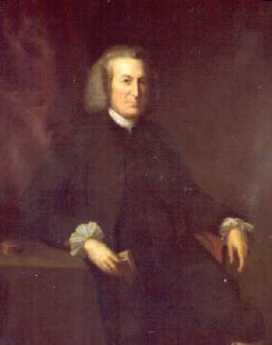
|
| Cadwalader |
Some incomprehension from bystanders must simply be endured with patience. Beyond that, it could be futile to seek a complete understanding. Quite recently, I was explaining to a young lady in a tailored suit who Thomas Cadwalader was. His portrait, beneath which we were standing, hangs in the great hall of the Pennsylvania Hospital. Although he died in 1789, Dr. Cadwalader is still famous for his remarkable, unfailing courtesy. A sailor in a tavern on Eighth Street once waved a gun and announced to the crowd he was going out the swinging doors to shoot the first man he met. The first man happened to be Dr. Cadwalader, who tipped his hat and said, "Good morning, sir." So, the sailor shot the second man he met.
The young lady in the tailored suit brightened up. "The moral of that story, " she said, "Is always wear a hat."
Why Are Hospital Prices So High?

|
| Aspirin |
Cost analysts maintain it really does cost ten dollars to write a simple business letter, so maybe it's no surprise when hospitals charge ten dollars to administer an aspirin tablet.
But there's also another form of hospital overcharging. Mark-ups of prices of several hundred percents over audited costs are routine in hospital bills. These are not hidden cross-subsidies, either; they emerge on the yearly audit as multi-million dollar "losses", neatly balanced by "contractual allowances". Translated, these are discounts to insurance companies.
Why do hospitals raise prices, then turn around and discount them? Why do they overcharge, then call it a loss when they write it off?
It's an important question, because it results in confronting patients without insurance with much larger bills than the effective price to insured ones; patients who can't afford to pay are charged more than those who can.
The old-time system of hospital wards to care for people who couldn't pay have been replaced by collection departments and hospitals are very aggressive in pursuing the very people who can least afford to pay, and who are grossly overcharged in the first place.
Health savings accounts with high deductibles were conceived as a way for people to self insure but they have been thwarted by hospital overcharges. Since HSA deductibles are guaranteed, hospitals perpetuate their present largest source of loss -- unpaid deductibles. So why do hospitals continue to post abusively-high prices for patients without large-insurance-company coverage?
Until hospital officials come forward with a coherent defense of their practices, outsiders can only guess at motives. Start with the old legal approach of "Cui bono?" (Who might have a motive?) and divide the answers into those with a motive and those with the means. The line-up will then consist of hospitals, insurance companies, limited-license practitioners, and the state government. Limited licensees, acupuncturists and the like, surely must hate high-deductible health insurance because their fees mainly fall below the two or three thousand annual deductibles. Old-line health insurance companies also have plenty of motive to keep out competitors, fearing antitrust action if they get too obvious. That leaves the state government.
States have ample power over hospitals. Substantial annual payments are negotiated with hospitals for Medicaid services, charity care, and educational grants and subsidies. Tax exemptions are repeatedly challenged and re-negotiated, and overall non-profit corporations are entirely creations of the state legislature. So, unless it is a violation of federal law, the state government has the means to compel hospitals to do anything. Power, yes, but where is the incentive for states to wish for exorbitant hospital prices? Or confer monopoly status on certain insurance vendors by according them sweetheart discounts?
All current plans for "reforming" health care involve providing government-paid insurance to those without. Will the result be to permanently institutionalize the artificially-high public prices to be paid in full by the government? If so, you can well understand why hospitals support these "reforms".
So hospitals are no better than stores that mark up their prices and then loudly proclaim that they will give you a discount. 200% mark-up, 10% off; terrific.
The Blue Cross Discount (6)

|
| Blue Cross Blue Shield |
Since I've alluded to the two basic problems in health financing today, perhaps I need to explain them. What's known in hospital circles as the Blue Cross discount refers to the wide disparity between what the hospital will accept from an insurance company and what they will demand in payment from someone who has no insurance. It's often double the price. It's a tragedy that forty million Americans don't have health insurance, all right, because it costs them twice as much. It's a punishment for the terrible crime of not buying insurance, to call a spade a spade.
That sounds like a pretty easy problem to fix, doesn't it? Stop overcharging them, and half of the problem of the uninsured would go away.
Furthermore, most of the people who do have health insurance are effectively able to buy it at seventy cents on the dollar, because they don't pay income tax on the money that goes for "health benefits" which is to say health insurance premiums.
Taken together, most people thus pay seventy cents for health care which will cost uninsured people two dollars. Most people would suppose that we ought to give a break to some poor devil who can't afford insurance, but in fact, we skin him alive financially. It's impossible to name any other necessity of life that's treated this way, and it's hard to think of any other problem that would be so easy to solve -- just charge everybody the same amount. If you are really bighearted, charge poor people just a little less,
Now, I refuse to get drawn into a history of the origin of these egregious situations. It has to do with price controls during World War II and the fact that investment capital for the health system was impossible to raise during the depression of the 1930s. But it doesn't matter in the slightest how this came about. What matters is how to make it go away.
Healthcare Reform: Looking Ahead (2)

|
| health care |
The Industrial Revolution crowded people together into smoky, draughty unhealthy places to live and work, and thus created ideal conditions for the spread of smallpox, tuberculosis, plague, poliomyelitis and many other infectious diseases. With better sanitation and hygiene, those diseases declined steadily for two centuries. Meanwhile, medical science developed a steady stream of expensive enhancements to health like removing an inflamed appendix, inserting pins into broken bones, utilizing CAT scans and artificial kidneys. These things each made life more comfortable and extended it a little longer, but steadily increased the cost of care. Here and there major leaps forward occurred, like the discovery of antibiotics and the prevention of arteriosclerosis, but it seldom seemed that medical care was stamping out disease, it was just making it more complicated and expensive. But if you stopping plodding forward for a moment and looked backward, the aggregate progress was astounding. Dozens of diseases either disappeared entirely or are well on the way to disappearing, like polio, smallpox, tuberculosis, syphilis, rheumatic fever, and what have you. Life expectancy for Americans at birth, which had been 47 years in 1900, was approaching 80 years in 2000. When I started as an attending physician in 1955, I was in charge of a 40-bed ward continuously full of diabetic amputees; during the last fifteen years of my practice, however, I did not attend a single diabetic amputation. At some point in this amazing medical pilgrimage I can remember realizing that for really important purposes, there were only two diseases left. Arteriosclerosis and cancer; and now arteriosclerosis mortality has declined fifty percent in ten years.
So now it is possible to have the luxury of asking: what will happen when we finally cure cancer? Oh sure, there is Alzheimers Disease, HIV/AIDS, schizophrenia and childbirth, plus an apparently endless variety of ways to produce self-inflicted conditions. Everyone will eventually die of something, so doctors will keep busy. It is not necessary to predict the end of medical care to see that some important social transformations are likely. For example, if we cure cancer around the time of financial chaos caused by the retirement of baby boomers, it is going to be hard to resist the demand that we reduce spending on medical research. Every tedious word of the impending debate on the topic could be written right now to save time because it is a very strong probability that spending on medical research will decline, once an effective cure for cancer is behind us.
Let's, however, continue our march into the future of healthcare reform. When employers became self-insured for employee health costs, they came into possession of data about what they were buying. It didn't look adequate to them to explain the sums of money they were spending, so they concluded they were being hoodwinked by hospital cost shifting, with consequences summed up as the Clinton Health Plan. Now put yourself in their shoes when the Wall Street Journal tells you cancer has been conquered. Michael De Bakey once pressured Lyndon Johnson to start a crusade against Heart Disease, Stroke, and Cancer, and now even cancer is gone. A significant number of C.E.O.s are likely at that point to decide that since Far Eastern competitors don't have this cost to contend with, perhaps it is time to declare that you have been fleeced long enough. Give the employees some money, and tell them to buy their own health insurance.
There are even some more legitimate arguments for doing so. Individually owned and selected health insurance would be portable, putting an end to "job lock", the fear of changing jobs for fear of losing health coverage in the process. Employee divorces create a different twist to job lock, and inequities jump out at you from the tangle of arguments about dual coverage for working couples. Add same-sex marriages to this issue and employers are driven to despair. Individual policies would simplify all of these issues, and open the door to life-long coverages, which we will discuss in a later section.
If medical progress makes just the right progress in the impending time interval before doomsday, it is even possible to start talking about eliminating health insurance in a practical way. If there is no threat of medical expense, why buy insurance against it? Since everybody will die of something, it is hard to envision a time without insurance. But maybe Medicare is enough. Senator Edward Kennedy (D, Massachusetts) will finally have his universal single-payer system -- by default.
What we have here are the daydreams of a corporate C.E.O., struggling to make his numbers for the next quarter, and they are pretty strong stuff. But who can doubt the power of these concepts to move the system away from an employer-based formulation?
The American Health Non-system
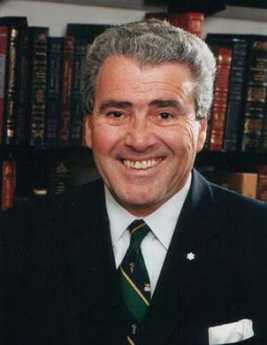
|
| Dr. Jock Murray |
Dr. Jock Murray has recently been Chairman of the American College of Physicians. He is also a Canadian. Recently, he was invited to address the College of Physicians of Philadelphia on an evaluation of the lessons to be learned from comparing the health systems of the two neighboring nations. It was an excellent, fair, and well-balanced address. The man who introduced him referred jokingly to the American non-system and Dr. Murray emphasized two epigrams about national systems in general. No nation on earth can afford to fill all of the health demands of all its people. So, all nations confront the three main demands, to deliver everything, to deliver it to everyone, and to do so immediately (ie without waiting lists). Fulfilling any two of these three demands is possible, but to deliver all three is impossible. Comparison of health systems in various countries amounts to identifying which two of the three they have chosen to have, which one they choose to surrender. I hope and believe Dr. Murray would mostly agree to this caricature of his remarks.
As a member of his audience, it does seem to be fair to acknowledge we have a non-system, and probably even fair to go further and observe we fundamentally resist those irksome constraints implicit in having a planned system. No organized system, and proud of it. But we do have something else. Let's call it a vision.
Without formally stating it, or even widely acknowledging it, Americans seem to have embraced a dream that we can indeed have everything for everybody right away. Yes, we can. The method available is to gamble that research can eliminate the disease. We hope, although we know it is not certain, that cancer, schizophrenia and Alzheimer's disease will reduce the cost of care. Our model exists in Rheumatic Fever and poliomyelitis, for which there are essentially no remaining treatment costs. We know that everyone ultimately dies of something; we assume we are already paying everybody's terminal costs. Eliminating diseases postpones terminal costs, but surely does not add to them.
We have knowingly and recklessly embarked on a program of pouring huge amounts of money into medical research. I believe the public mostly suspects that much of our present high cost of health insurance eventually finds its way into supporting research, and the public mostly acquiesces in whatever cost-shifting is involved. The people who devote their lives to research in turn vaguely recognize that we might reach a point where the country cannot afford this gamble any longer, and they could have half-wasted a career. We all vaguely understand it's a gamble; major elimination of disease might not be just over the horizon and might lead us on to indefinite postponement of a foolish dream.
But those are the chances you take; we seem resolved to take them. We are going to give it a go. If we can, we are going to spend whatever it takes to give everything to everybody, right away. We are going to eliminate diseases, on the unproven but plausible assumption that doing so will eventually bring costs down.
Cost of Medical Care
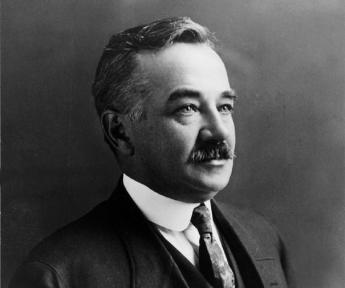
|
| Milton S. Hershey |
On several occasions, Richard A. Kern M.D. (1891-1982) told the story of his part in the founding of the Hershey School of Medicine. Dick Kern was a distinguished professor of Medicine at Temple University, well known for his contributions in the field of asthma and allergy, a past president of the College of Physicians of Philadelphia, and a former Grand Master of Pennsylvania Freemasonry. The Milton S. Hershey School was considering the creation of a medical school and needed advice.
Milton Hershey had been a strict Mennonite, which is closely related to Quakerism, and had accumulated a huge fortune making chocolate candy. He left generous trusts to endow a theater and various other public services in the town of Hershey, but his ownership shares in the chocolate company had been left to the Hershey School for orphans. The value of the shares had far outgrown the ability of the school to employ them usefully, and they were considering a medical school. In 1963, as at present, everybody else was wondering how to get out from under the crushing cost of running a medical school. The sudden inquiry from a donor both willing and able to start a whole new medical school from scratch was an opportunity not likely to appear again soon. Kern carefully considered the options, including the danger of scaring off the naive potential donors with too high a price. Finally, he screwed up his courage and suggested a price to the trustees, of fifty million. The prompt answer was, done, you've got your medical school.
In due course, Kern found himself on the platform at the inaugural ceremonies of the school, sitting next to the guest of honor, that man who had made such an instant decision. Chatting amiably, Kern mentioned that he had always wondered how high the Hershey Foundation would have been willing to go. The answer was just as prompt as the original one. "Hundred-twenty."
Flexner Report, Revisited
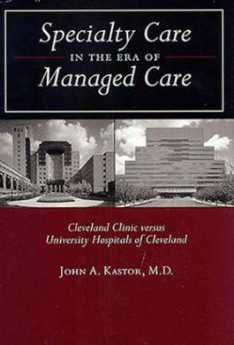
|
| Specialty Care In The Era Of Managed Care |
Book Review
Specialty Care In The Era Of Managed Care
Cleveland Clinic
versus
University Hospitals of Cleveland
John A. Kastor, M.D.
0-8018-8174-9
The Johns Hopkins University Press
Abraham Flexner's 1910 Report practically canonized the notion that medical schools must be owned by universities. Forty years later, Dwight Eisenhower firmly disagreed. Asked why ever would he give up the pleasant life of Columbia University president to get into the nastiness of national politics, he replied, "The White House doesn't run a medical school." During the same era, Secretary of State Dean Acheson and Senator Robert Taft, political enemies but personal friends, were riding to New Haven together to a Yale trustee meeting. The two agreed it was unfair for 40% of university budget to be spent on 1% of the student body, and decided Yale should get rid of its medical school. Their subsequent motion failed by only one vote at the meeting. And as a final Flexner footnote, Princeton University which shrewdly never owned a medical school, is now nonetheless in the news over the central underlying discordance -- managing huge sums which, either by contract or donor restriction, are inflexibly assigned to a single department, thus substituting the donor's priorities for those of the University president. Medical school ownership of teaching hospitals raises the same issue except in reverse. It is politically impossible to treat an affiliate as a cash cow without learning the harsh reality of the Golden Rule: the affiliate with the gold will promptly remake the rules.
Understanding these issues but seldom emphasizing them, John A. Kastor has done us all a great favor by studying and publishing the unseemly disorders which result, in many cities and institutions. His particular focus in this book is on Cleveland, where all that matters medically is the prospering Cleveland Clinic and its struggling rival, Case Western Reserve. The book is mainly focused on a particular question: under managed care, should teaching hospitals adopt the Cleveland Clinic's style and organization, in order to prosper as they do? In the end, he cannot quite bring himself to recommend it. Essentially, the Clinic is run by doctors, for doctors. The clinic pays salaries, but (so far) bills fee-for-service. The over-reimbursed procedural specialties such as surgery subsidize the under-reimbursed cognitive specialties (prompting East Coast colleagues to sneer at "organized fee-splitting".) Cleveland's Clinic, like all group practices, must devise strategies to a)induce acquiescence to the subsidy of internists by surgeons, b)discourage physicians from starting competitive practices in the neighborhood or c)turning their salaried incentive into an instant 40-hour week. Not everyone will submit to what is between the lines, most notably at the Clinic's Florida satellite. But since the alternative is to hire non-physicians with concealed animosities to doctors to run hospitals and medical schools, all physicians who actually treat patients must give the physician-run group practice model some thought based on experience with its alternative.
We all have an unfortunate tendency to assume that weakness of character is the main cause of the executive misbehavior so widely observable in all corporate environments. In the medical world, a much more powerful force is generated by shifting quirks of reimbursement. Once the pecking order is established between hospital and school, medical school and university, it gets violently upended by the underdog suddenly getting riches from the Senate Finance Committee, then upended again by Ways and Means a few years later. Or bureaucrats in Rockville, in Baltimore, or the Executive Office Building. Eisenhower was wrong, the White House does run medical schools and hospitals when they would very likely be better run by physicians. In fact, Flexner's offhand interposition of the University into this dogfight seems a little quaint. Just to mention the indirect residency reimbursement program, the institutional research overhead allowance, the old cost-plus reimbursement of hospitals, the institutional patent revisions, is to start a list which can get to be quite long. In most of these cases, an institutional component which needed to be subsidized in the past has now become prosperous and is asked to return the subsidy. The chief executive is then caught between duty to his institution, the threat of investigation if funds shifting is suspected, and his own sense of fairness. That these upheavals are so frequently pacified without serious harm to the patients, is a credit too seldom given.
Dr. Kastor's writing is somewhat hampered by a need to footnote, document and defend everything he says. Nevertheless, the book will be read by physicians like a novel with a great many villains. It's encouraged reading. One hopes that the next book in the Kastor series will examine the Florida satellite clinics of the Cleveland Clinic and of the Mayo Clinic, one making money and the other losing money. Maybe some basic issues of an effective medical organization can be resolved by making different comparisons.
But don't expect permanent axioms to emerge; Medicare Risk contracts are coming. Under capitated systems, administrative incentives are slanted to discourage expense, especially expensive surgical procedures. Perhaps group practices will soon face a need to have their internists subsidize their surgeons, reversing the traditional arrangement. The threat to collegiality, so evident in this book, is destined to continue.
Picking Up the Usual Suspects
The federal government directly controls about half of health care spending and makes rules affecting most of the rest.
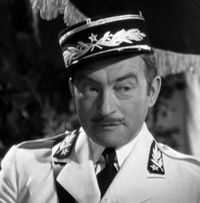
|
| Claude Rain |
Every group or business which receives some of this money is alert not to lose it. Many other groups are alert for openings to get more of it. All employ sentries in Washington. False alarms are frequent, stealth attacks are a constant threat, constituents paying the bills demand immediate reassurances. Members of Congress seldom initiate a disturbance unless someone from inside an industry brings it to them. Consequently, when proposals do surface and seem to be serious, the question to be immediately answered is -- who's behind this? If you know who starts something, you can readily imagine the motive, assess the political strength, decide how to respond. With what little was generally known about the Clinton Health Care Plan of 1993, it was easy to imagine a host of people with some motive, but very hard to say who was actually pushing one. Must be a Democrat, obviously, but not immediately obvious which of several possibilities was the real agitator.
Health insurance companies would always seem likely to have proposals about national health insurance. Blue Cross dominates the market in large geographical markets, mainly East Coast, and would seem fearful to lose that dominance in a major upheaval. But other market areas of the country are dominated by commercial insurance companies who might seek to upend the Blue Cross monopoly, but whose form of business would be even more seriously threatened by health insurance innovations. Most commercial health insurance was written by large life insurance companies who regard health insurance as a small sideline for the convenience of their industrial customers. Blue Cross was somewhat more comfortable with government work, particularly since the 1965 Medicare and Medicaid programs were patterned after them. However, Blue Cross was non-profit, thus lacking in incentives, and historically controlled by health care providers. That is, Blue Cross was formed by and dominated by the hospital associations, and Blue Shield was formed by and dominated by medical societies. Since doctors and hospitals were very prompt in announcing their deep concerns and uncertainties about the Clinton Plan, Blue Organizations seemed unlikely to make daring proposals so likely to provoke trouble at home.
Not that some doctors and some hospitals didn't try to see what might be made of this opportunity. At the American Medical Association, certain leaders known to have Blue Shield involvement offered conciliatory remarks about waiting for further details before taking a stance but were abruptly halted by a general opinion that things had apparently already gone too far for substantive negotiation. Much the same thing occurred at the Hospital Association; the winners had too much to lose, the losers had too little influence to matter, and nobody stepped up to claim an inside track. Hospital trustees didn't know what was going on, strongly suspected something was going on and didn't like either situation. If the doctors got mad enough at a hospital, they could ruin it, and if hospitals got mad enough at Blue Cross, it too was ruined. The main strength behind the Blue Cross monopoly position was the secret discount provided to them by hospitals, which was refused to competitor insurance companies but could easily be extended in the interest of fairness. If need be. The commercial competitors wanted that discount much more than they wanted new insurance models.
There is one subset of doctors and hospitals that might be suspected of generating a sweeping revision of the medical system -- academia. Medical schools think of themselves as the appropriate source of vision about the profession they are training, and they run large prestigious hospitals. Their heavy dependence on government research grants, teaching subsidies, and tuition support programs puts them in constant contact with Washington bureaucracy and politics; propinquity is a great match-maker. Their style of salaried faculty creates estrangement from making a living by being paid fees for specified services, and they are reasonably comfortable with the flaws and techniques of professional promotion within a large organization. So, a slogan which has been attributed to Wilbur Cohen himself does not greatly jar on their ears. The author of the Medicare Act is said to have announced that the entire medical system of America could be accommodated by thirty or forty Mayo Clinics. Twist that just a little, and you are imagining he said forty or fifty medical school teaching hospitals. The briefest contemplation and rebuttal will knock down that proposal, such as pointing out that we have several times that many teaching hospitals at present without achieving anything like the nation-wide coverage envisioned. After absorbing the administrative chaos of readjusting to that model, you would confront the old repeated history of grossly overestimating, and then grossly underestimating, the future manpower needs of a medical system in the process of constant scientific turmoil. Suppose you built the fifty Mayo Clinics and found you needed two hundred? Suppose you built two hundred and found you needed seventy? And then, finally, remember that each big city could expect to contain one of these organizations, but the fewer of them there are, the longer the distance everyone else would have to travel to get to them. No one has even ventured to speculate how you could go about doing such a thing, let alone doing it three or four times to get it right. But, but. The infeasibility of academia at the center of medical care delivery does not eliminate the possibility that the idea underlying the Clinton Health Plan may have originated in academia, or that academia might support some similar proposal with something else at its center.
Since it was soon clear that the traditional "players" in the health policy arena were unlikely to be sponsoring some self-serving policy that might masquerade as the Clinton Health Plan, the search went on. There were a number of professional groups within the medical community who had traditionally chafed at the domination of the hierarchy by physician leadership. Nurses, hospital administrators, pharmaceutical companies, druggists, corporate human resources officers, public health officials, social workers, biology teachers all represented groups who derived status with the public by displaying inside knowledge of medicine. But all of them fell silent when a physician entered the room, and tended to shift their emphasis to faults of the "system" or the "industry". Their Washington representatives placed their emphasis on changes in the existing system which might elevate the prestige and income of the members and were particularly vigilant for system modifications intended for other purposes which might nevertheless create advantageous loopholes for the members. All of this is normal striving in the good ole' American way, a polite variant of the mixture of bellicosity and restraint usually seen in the Union movement. These people wanted to improve their income and working conditions but were ultimately quite hesitant about radical proposals that might sink the ship. A quick survey showed they were not supporting any particular reform project, even though they could be counted on to support any reform project. Furthermore, they consistently injured their political strength by extending beyond economic goals to issues like radical feminism in the case of nurses, or direct advertising to the public as in the case of the drug companies, or practicing medicine without a license in the case of limited-license practitioners. These people had votes, influence, and lobbyists, but they did not have a national project for health care reform of their own devising, and they surely were not the people behind the Clinton Plan.
During the six months before The Plan was presented to Congress and the Public, a White House task force said to consist of five hundred secret members was meeting under the direction of President Clinton's wife Hillary. No doubt part of their purpose was to give Hillary a public platform on which to show her stuff, with the idea of someday succeeding her husband as President sort of in the back of her mind. But most of it was also quite practical; somebody had to figure out what this proposal was going to be, and newly elected Bill had to spend most of his time learning how to run the rest of the country. Buried in here was an efficiency principle too; the staff members of every important congressman and senator were involved in the process, making the deals and surfacing the political angles before things had to come down to votes and filibusters. Meanwhile, the rest of the country had to wait outside closed doors, fed by rumors and spin.
How well I remember one public seminar on the subject during this period of suspense. The audience was filled with people thought to be influential with the public, the usual suspects in that sense, too. Representatives of various interest groups were seated up front at a table, and for some reason, I had been picked to represent doctors. Next to me was a druggist who had made a billion dollars starting an HMO; it was intriguing to watch how many well-dressed women with no interest in health care paraded up to the table to show their stuff to the billionaire, while we waited for the meeting to begin. All of the usual suspects of Philadelphia medical care were at the table, each of us wondering what the other was going to say. When some last Very Important Person had wandered in and taken a seat, it was time to begin. The moderator told a funny story or two, and then asked each one of us what we thought of the Clinton Health Plan. One by one, to the utter amazement of us all, we each explained how we were opposed to it.
So obviously this proposal was not coming from the usual agitators. But, remember, somebody was surely behind it. Before we take a stab at that mystery, let's humanize the usual suspects by describing a few of them.
A Toast To J. William White, MD
JWilliam White left a legacy to the Franklin Inn, the income from which was to pay for an annual dinner, with all the trimmings. Good as its word, the Inn holds the J. William White dinner every year on Benjamin Franklin's birthday, although inflation and fluctuations of the stock market require it to make a modest charge for attendance. White also created the J. William White Professorship in Surgery at the University of Pennsylvania, a chair which was once occupied by Jonathan Rhoads.
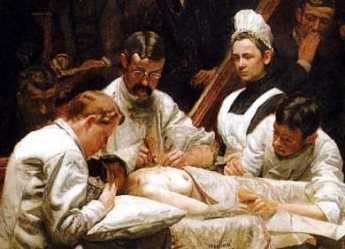
|
| William J White MD |
These trust-fund memorials do little to convey the wild and glamorous image of Bill White. White was a member of the First City Troop and fought the last known honest-to-goodness duel on Philadelphia's field of honor (in the accidental "wedge" of disputed land between Delaware and Pennsylvania). The right and wrong of the argument about wearing the City Troop uniform are in dispute, but the details boiled down to White at the critical moment raising his gun to the sky and firing at the stars. That it was not a meaningless gesture was then brought out by his opponent ( a fellow Trooper named Adams) taking slow and deadly aim -- but missing him.
White was an academic in the sense that he was the first, unpaid, Professor of Physical Culture at the University of Pennsylvania. Active in the Mask and Wig Club, he was a chief surgeon at Philadelphia General Hospital, chief surgeon to the Philadelphia Police, and chief surgeon to the Pennsylvania Rail Road. He is the surgeon actually operating in Thomas Eakins' Agnew Clinic, while Agnew himself stands as the "rainmaker", to use a term from legal circles. He was Chairman of the Fairmount Park Commission, and numerous other positions where political contact was more important than surgical skill. When World War I came along, he was off to France with the University of Pennsylvania Hospital Unit, writing two books with Theodore Roosevelt. Although his friendship with Henry James suggests greater literary talent, he was supportive of Adams' transfer of citizenship in protest of America's staying out of World War I; but nonetheless, Roosevelt published more than thirty books. What emerges from the history of Bill White is flamboyance and lots and lots of unfettered energy. He might feel a little out of place at one of his endowed dinners today, but he was probably always a little out of place in any company -- and didn't care a whit.
REFERENCES
| Philadelphia Gentlemen: The Making of a National Upper Class: E. Digby Baltzell ISBN-13: 978-0887387890 | Amazon |
Philosophy Means Science in Philadelphia
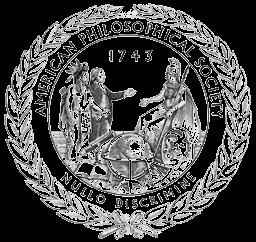
|
| American Philosophical Society Seal |
In the age of the Enlightenment, science was called natural philosophy; that accounts for the present custom of awarding PhD. degrees in chemistry and botany. The sort of thing which interested Ralph Waldo Emerson was called moral philosophy, and you will have to visit some other place than the A.P.S. if that is what interests you. Roy E. Goodman is presently the Curator of Printed Material (some would say he was chief librarian) at the American Philosophical Society, founded in 1743 by Benjamin Franklin who was clearly the most eminent scientist of his day, having discovered and explained the nature of electricity.
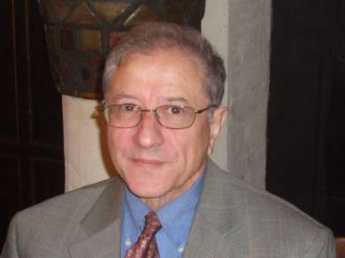
|
| Roy E. Goodman |
Roy Goodman is descended from cowboys and rodeo stars, but in spite of that he gave an entertaining talk recently at the Right Angle Club about this society devoted to useful knowledge, this oldest publishing house and scholarly society in America, once the home of the U.S. Patent Office, and scientific library and museum. They have many rare items in their collection, but the unifying theme is not a rarity, but curiosity. You might say some of the items reflect the whimsy of Franklin, but it would be fairer to say it is an enduring monument to Franklin's universal curiosity about all things.
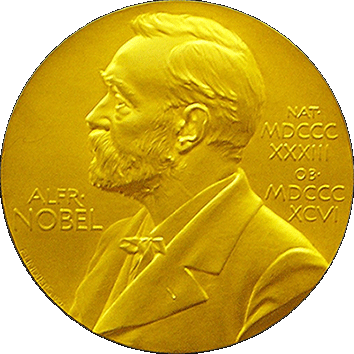
|
| Nobel Prize Medal |
There are about 900 members of APS, about 800 of them Americans, about 100 of them winners of a Nobel Prize. Let's just make a little list of a very few notables in the past and present membership. Start with the first four Presidents of the United States, add Alexander Hamilton and Lafayette, David Rittenhouse and Francis Hopkinson and you get the idea that Founding Fathers got in early. Robert Fulton, Lewis and Clark, Alexander Humboldt, John Marshall were early members, and more recent ones were Madame Curie,
TOAST TO E. DIGBY BALTZELL (1915-1996)
A TOAST TO E. DIGBY BALTZELL (1915-1996)
The Franklin Inn Club, Philadelphia
Annual Dinner, 15 January 2010
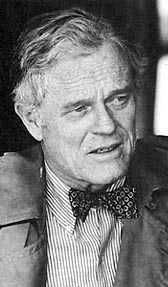
|
| E. Digby Baltzell |
I am grateful that our President, Deborah Goldstein, and the Board have given me this opportunity to make precedent -- tonight to strengthen the tradition of the Franklin Inn Club by raising a new toast, following our 18th century icon, Benjamin Franklin, and the 19th century men who founded the Inn, with a 20th century member. We are, after all well into the 21st century. It is my original privilege to honor a member and author who contributed strongly to American social thinking: E. Digby Baltzell.
Digby and WASPS Let me right away make two statements about Digby and WASPS. His name is associated with that acronym because it appeared in his book of 1964, THE PROTESTANT ESTABLISHMENT; ARISTOCRACY AND CASTE IN AMERICA. But contrary to a popular misconception, Digby did not invent the term WASP. I know, because a Jewish girlfriend from New York City used that term on me critically ("That's what we call people like you") in 1952. And there is good evidence that the term was in use as a put-down, like other American ethnoreligious slurs, two decades before Digby gave his term for White Anglo-Saxon Protestants scholarly standing in his book.
Secondly: however dear his idea was to him, Baltzell gave up on WASP aristocracy before his death. His subtitle had contained his aim: "Aristocracy and Caste in America." He was inspired by Tocqueville's attempt to save the French aristocracy from its own destruction by writing "Democracy in America" during the presidency of Andrew Jackson. Baltzell was concerned about his own aristocratic class. These were prep school and Ivy League educated people with family lineage, trust funds, and above all, what might be called Rooseveltian motivation. Either TR, Republican, or FDR, Democrat, party did not matter. Both Roosevelts had the aristocratic drive to excel: not only to lead but to assimilate other talents into leadership. That was the key to the matter: for a responsible aristocracy perpetuates itself by absorbing into ruling power new immigrant energy and multi-class talents, such as, in the 1930s, Fiorello LaGuardia, mayor of New York City, and Sidney Weinberg of Goldman Sachs.
An aristocracy is irresponsible, however, when it merely replicates its own ethnic and religious features. By protecting itself with clubbishness it ceases to be an aristocracy and rigidifies into a caste. Baltzell, 1964, feared that WASPS in the USA would let that happen, and wrote in the strong hope that they would not. But it was already happening. Looking back, we can see that the game was almost over.
Digby and Me Who was Digby Baltzell? He was born in Rittenhouse Square and grew up in Chestnut Hill to what he called an "impecuniously genteel" family. They sent him off to St. Paul's School in New Hampshire, an exclusive Episcopalian* boarding school formed in an English tradition. In his senior year, his alcoholic father was fired from his insurance company, and soon after died of a heart attack. For college, Digby could not afford Harvard, Yale, or Princeton, where all his classmates went but settled for the University of Pennsylvania. There he got himself through on scholarship, with various jobs such as ticket-taker, usher, and parking lot attendant at Franklin Field. He went on to get a Ph.D. at Columbia and came back to Penn, where he taught for the rest of his employed career.
I never met Digby personally because he died in 1996, the year that I joined the Inn. Yet I identify with the man I just described in some distinct ways. My own alcoholic father, a mellow, dear, and vulnerable man, lost his job as a stockbroker while I was in college. There, at Williams, I was a member of the same hard-drinking fraternity, St. Anthony Hall, as Baltzell had been at Penn. I'm not Episcopalian, but being a Scotch-Irish Presbyterian makes me categorically WASP. I feel like Digby did, that I have been a marginal member of the elite. I became an academic to try to figure out what the hell was going on around me. I have, like him, "an insider's heart and an outsider's mind." That has qualified me not to make a fortune, but to write books.
Digby and Us We all live in a time of social phenomena Digby never reckoned with -- of Bill Clinton as a white trash national leader; of John Kerry, a Catholic agnostic from St. Paul's School who lost the election of 2004 to G.W. Bush, a retrograde pseudo-Texan who had renounced his father's waspismo. Personalities that Baltzell might barely have imagined: Oprah Winfrey, a multicultural pop icon who is incidentally black; and the Afro-Saxon lawyer-intellectual whom we have chosen President of the United States, Barack Obama.
Baltzell finally gave up the attempt to invigorate his idea of a responsible ethnoreligious elite. He realized, and said, "what the Jews have done since World War II is the great untold story." And when he died he was preparing to undertake a book on the end of the Protestant establishment. He recognized that it had been replaced by a meritocracy based on professional performance, which, I think, is far more congruent to American social dynamics. I conclude that Baltzell's last and never completed project was an admission that his three books on the WASP establishment were a failed effort to firm up a transient power structure. I believe that Baltzell had been trying to implant in America a British notion of ruling class flavored with Tocquevillean nostalgia for a lost French aristocracy. Our nation has wholly different components from those, and he was bound to fail. Even as he struggled to make the point, he acknowledged the multi-cultural society around him, while expressing a vivid fear that multi-culturalism enshrined meant moral relativism, which would, in turn, mean an unworkable political system. On that last, he may yet prove correct. And he was surely astute in recognizing the importance in America of a professional meritocracy. If any of us, nonetheless, still yearns for an aristocracy of some kind, I would recommend Jefferson's idea of "a natural aristocracy based on talent and virtue."
Digby, although a connoisseur of clubs noted in the Social Register, never joined one, although often invited to do so. He criticized, among others, the Duquesne Club in Pittsburgh, the Links Club in New York, and the Philadelphia Club here for their obtuse and pointless exclusiveness.** But he chose to be a member of The Franklin Inn Club, and in his later years often came from home on Delancey Street to lunch among members. Our cultural, artistic, and literary atmosphere, we may dare feel, was comfortable for him. What he found here was perhaps an aristocracy without power, but a natural one in its components of talent and virtue. Sisters and brothers: let us toast Digby Baltzell -- an exemplar of our values, and an inspiration to us in the Twenty-First Century.
Theodore Friend
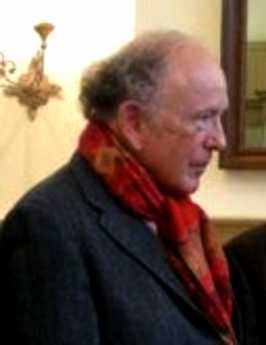
|
| Theodore Friend Sr. |
*To the rumor that Baltzell became a Roman Catholic before he died, a close living relative says no: he very much respected the Catholic Church, was interested in healing the breach with Episcopalians and may have attended some Catholic services. But nothing more.
**A Jewish friend, responding to my inquiries, tells me that he was admitted to The Union League in 1967, and about twenty years later became chair of the Admissions Committee. What percentage of members now are Jewish? He estimates five percent.
Sources:
Baltzell, THE PROTESTANT ESTABLISHMENT: ARISTOCRACY AND CASTE IN AMERICA , (1964)
PURITAN BOSTON AND QUAKER PHILADELPHIA, (1979)
THE PROTESTANT ESTABLISHMENT REVISITED, (1991)
Brief conversations with members of the Franklin Inn:
Daniel Hoffman, Nathan Sivin, and Arthur Solmssen.
Puritan Boston & Quaker Philadelphia
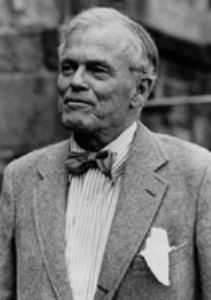
|
| Professor Digby Baltzell |
Digby Baltzell had something of the defiant rebel in him. He surely didn't imagine his employer, the University of Pennsylvania, was pleased to have him a document that Harvard is a better college than Penn. Nor were fellow members of the Philadelphia Club pleased to confront scholarship that his city's gentry was too devoted to money-making to accept the ardors of public leadership. Nor would his relatives in the Society of Friends enjoy accusations their religion impaired the pursuit of excellence in all fields of the city's endeavor. Later articles will here take up some unfair assaults, and defend Quaker simplicity and Peace Testimony. Some blame must, of course, be shared, some mitigating circumstances acknowledged. And let it be said in Baltzell's support that it truly is remarkable how many cultural features do get passed down for ten or more generations. Or even longer; look at the persistence of ancient Chinese, Indian, Esquimo, Viking, Roman, Christian and other cultural heritage. The Quakers got to Pennsylvania early, they are now vastly outnumbered. Many Quaker ideas continue to influence present inhabitants, some ideas probably hold us back. Substitute "Puritans of Boston" for "Quakers" in the foregoing sentence, and conclude by saying "some of those ideas probably give Bostonians an edge". Those two rather unexceptional declarations summarize a controversial book, although they do not completely capture its overall censorious flavoring.
To a certain extent, Digby is his own worst enemy. While alive, he was one of the world's most charming raconteurs, a walking encyclopedia of local lore. Like a good docent in a museum, he could walk into a room hung with portraits, and charm any audience for an hour; presumably, his sociology lectures at Penn held the same magnetism for his classes. In a book for popular readers, however, it is overdone to go on about the same point for six hundred pages. He needed a better editor, or perhaps he needed to permit a better editor to make him restrain his tendency to multiply illustrations beyond the point where the reader loses the thread of the argument. Not all readers will agree with his argument; they can only be legitimately defeated by focused argument. That's perhaps unrequired of college professors holding the power of grade-point averages over nineteen-year-olds, but it is expected of conversation with other adults. If an editor wants to sell books to a general bookstore audience, he should induce authors to overcome the take-it-or-leave-it habit.
As a general reaction to this book, Baltzell seems to think Quakers do not want to be rich and that consequently, latecomers into the region tend to share this feeling. My own view is that Quakers see they can have almost all of the value of being moderately rich -- by disdaining the trivial luxuries of the middle classes. They do not exactly renounce fame and power but are unwilling to gamble much or sacrifice much, in order to enjoy the comparatively small exhilaration of being very rich. They are now no longer surrounded by junior versions of themselves, but by bank-robbing Willie Suttons who readily attack Quakers for being where the money is, and appear to be pushovers at that. When Quakers then promptly demonstrate they are not pushovers at all, they are treated like outsiders in their own town. In many ways and at most times, the populist crowd gives up trying to understand Quakers and decides they must somehow always behave in ways that others would not. It's hard to achieve much deference in such an environment.
Many of Baltzell's important insights grew out of his position as a Philadelphia and academic insider; he personally knew many of the people he described. However, such an infiltrator runs the constant risk of being viewed as a tattle-tale, so a cover is required. Batzell's technique involved frequent use of quotations from others, not so much to prove a point as to rephrase it. This is another feature of the book which might have benefited from a hard-nosed editor. However this is how he wanted it, and in a post-publication revision, here is a condensation of how he summarizes his argument:
When studied with any degree of thoroughness, the economic problem will be found to run into the political problem, the political problem, in turn, run into the philosophical problem, and the philosophical problem itself to be almost indissolubly bound up at last with the religious problem.
--Irving Babbitt
In the South, ....left-wing Quakers came to the fore in the pine barrens of North Carolina-- to this day, North Carolinians speak of their state as "a valley of humilities between two mountains of conceit."
--E. Digby Baltzell
The world is only beginning to see that the wealth of a nation consists more than anything else in the number of superior men it harbors.
-- William James
I believe that ambitious men in democracies are less engrossed than any other with the interests and judgments of posterity; the present moment alone engages and absorbs them...and they are much more for success than for fame. What appears to me most to be dreaded, that in the midst of the small, incessant demands of private life, ambition should lose its vigor and its greatness.
-- Alexis de Tocqueville
Our rulers today consist of a random collection of successful men and their wives. ....They have been educated to achieve success, but few of them have been educated to exercise power. Nor do they count with any confidence upon retaining their power, nor of handing it on to their sons. They live therefore from day to day, they govern by ear. Their impromptu statements of policy may be obeyed, but nobody seriously regards them as having authority.
--Walter Lippmann
Equalitarians holding...extreme views have tended to believe that men of great leadership capacities, great energies or greatly superior aptitudes are more trouble than they are worth.
--John W. Gardiner
In the Jacksonian era in this country, equalitarianism reached such heights that trained personnel in the public service were considered unnecessary...Thus, in the West, even licensing of physicians was lax, because not to be lax was apt to be thought undemocratic.
--Merle Curti
In the late eighteenth century we produced out of a small population a truly extraordinary group of leaders-- Washington, Adams, Jefferson, Franklin, Madison, Monroe, and others. Why is it so difficult today, out of a vastly greater population, to produce men of that character?
--John W. Gardiner
It is nevertheless certain that the high quality of Virginia's political leadership in the years when the United States was being established was due in large measure to those very things which are now detested. Washington and Jefferson, Madison and Monroe, Mason, Marshall, and Peyton Randolph, were products of the system which sought out and raised to high office men of superior family and social status, of good education, or personal force, of experience in management: they were placed in power by a semi-aristocratic political system.
--Charles S. Syndor
Another clue to the relationship between hierarchy and leadership is suggested by Gardner's list of the Founding Fathers. All of these men were reared in Massachusetts or Virginia; none was reared in the colony of Pennsylvania, though Philadelphia was the largest city in the new nation and contained perhaps the wealthiest, most successful, gayest, and most brilliant elite in the land. Not only had Pennsylvanians little to do with taking the lead in our nation's founding, but the state has produced very few distinguished Americans throughout our history...I shall concentrate here on the commercial cities of Boston and Philadelphia, whose great differences in leadership and authority were far more likely to reflect differences in ideas and values.
--E. Digby Baltzell
Whatever else ...America came to be, it was also an experiment in constructive Protestantism.
--H. Richard Niehbur
All this is only to say that man is a product of his history, where nothing is entirely lost and little is entirely new.
--E. Digby Baltzell
For the wine of New England is ...more like the mother-wine in those great casks of port and sherry that one sees in the bodegas of Portugal and Spain, from which a certain amount is drawn off each year, and replaced by an equal volume of the new. Thus the change is gradual, and the mother wine of 1656 still gives bouquet and flavor to what is drawn in 1956.
--S.E. Morison
New Englanders, ambitious beyond reason to excell.
--Henry Adams
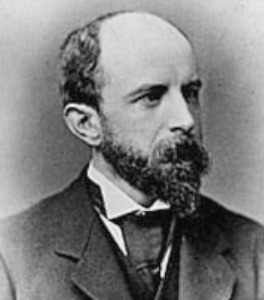
Henry Adams Pennsylvania became the ideal state, easy, tolerant and contented. If its soil bred little genius, it bred less treason. ... To politics, the Pennsylvanians did not take kindly. Perhaps their democracy was so deep an instinct that they knew not what do to with political power when they gained it; as though political power was aristocratic in its nature, and democratic power a contradiction in terms.
--Henry Adams
The reproach I address to the principles of equality is that it leads men to a kind of virtuous materialism, which would not corrupt, but would enervate the soul, and noiselessly unbend its springs of action.
--Alexis de Tocqueville
In our egalitarian age of mistrust, trustworthy men of great ability are increasingly refusing to run for public office or to serve in positions of authority and leadership in our society...In the rest of this book, I shall try to show how and why the Quaker city of Philadelphia, in contrast to Puritan Boston, has suffered from that virus of virtuous materialism for almost three centuries and how its best men, on the whole, have seldom sought public office or positions of societal authority and leadership outside business.
--E. Digby Baltzell
REFERENCES
| Puritan Boston and Quaker Philadelphia: E. Digby Baltzell. ISBN-13: 978-1560008309 | Amazon |
Swarthmore College
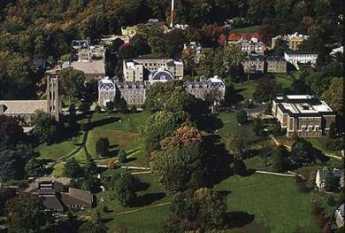
|
| Swarthmore College |
The Friends Association for Higher Education lists 17 American institutions as Quaker Colleges, Universities, or Study Centers. Four of these, Swarthmore, Haverford, Bryn Mawr and Pendle Hill, are located in the Philadelphia region. Until Haverford College recently adopted co-education, it was once possible to say Haverford was all-male, Bryn Mawr was all-female, and Swarthmore co-ed; Pendle Hill has no undergraduates. That greatly oversimplifies a very distinctive set of complexities, however. Since there is no official connection between the colleges and the church, it is a little hard even to explain the sense in which they are truly Quaker, which is by operating under a strong striving for consensus.
Swarthmore is commonly said to be the most Quaker of the three undergraduate colleges, but only 7% of its students are Quaker and only a quarter of its trustees. The most distinctive feature of the college is the so-called Honors Program, patterned after the tutorial system of Oxford and Cambridge, which was brought there in 1921 by a non-Quaker president who had experienced the system as a Rhodes Scholar. The establishment of this program was heavily supported by the General Education Board, which is to say the Rockefellers. As a reflection of the pressures of graduate schools, and possibly student preference for a greater variety of subject material, only about a third of the students elect to take the Honors Program. It is, however, the central core of the college.
The name of the college derives from Swarthmore, which was the English home of George Fox, the founder of Quakerism. Early Quakers were uncomfortable with the colleges and universities of their day, which had been founded to educate priests and ministers of various other religions, gradually enlarging their mission to include the children of upper-class families. The motto of Eton College embodies much that made Quakers wince: "Eton exists to exert a civilizing influence upon those who are destined to rule." Even the American variation of that there is scarcely an improvement since it would probably say something along the line of offering the opportunity to increase the student's future life income by 70%. It is easy to understand why Quakers wanted to have their own school system, protecting their children from attitudes and influences they disapproved of. Although the Civil War somewhat disorganized the early directions of Swarthmore, for fifty years it was a simple rural college, aimed at avoiding modern influences more than seeking a defined unique role. And then along came Frank Aydelotte.
Very likely, a major appeal underlying the Oxbridge seminar system to Aydelotte and the Quaker trustees was its modern evolution into a model for producing those unusually talented and incorruptible civil servants, who really run the British government under the nominal control of elected officials. Such ambitions necessarily imply a need to attract unusually bright students, and Aydelotte's method was to keep the student enrollment smaller than a well-financed faculty could attract. Unfortunately, as brighter non-Quaker applicants were attracted, more and more Quaker applicants had to be rejected. By 1953, the incoming new president, Courtney Smith, was prompted to make the rueful observation, "Franklin Roosevelt's record at Harvard, and Adlai Stevenson's at Princeton, and Dwight Eisenhower's at West Point, were scarcely, I am told, pace-setting." Almost every American college now faces something like the same conflicted feeling, since globalization implies that all Americans, not merely Quakers, might someday be excluded from their own colleges in order to make room for, say Orientals, who are brighter. Remaining small, however, Swarthmore does have the latitude to seek its own solutions, one of which has been to create the pre-eminent scholarly center for the study of Quakerism.
There are other quiet paradoxes atSwarthmore. From rural simplicity to suburban elegance, the physical transformation of the campus made possible by generous funding might distress only a Quaker. Indeed, Arthur Hoyt Scott of the class of 1895 donated 330 acres of ornamental garden in 1929, composed of beautiful ornamental plants, that no matter what their origin would thrive in the Delaware Valley. Not only is this garden a premier place to visit, but it is also one of the inspirations along with Longwood and Bartram's Gardens for landscaping of the entire Mid-Atlantic region.
And then there is the subsequent history of Frank Aydelotte. True, after he left Swarthmore he became a Quaker, himself. But he left to implement the educational ideas of Mr.Bamburger the department store magnate at the new Institute for Advanced Study in Princeton. That is, at that unquestionably pre-eminent intellectual center whose main achievement so far has been the development of, the atom bomb.
REFERENCES
| Swarthmore College: An Informal History: Richard J. WaltonASIN: B0006ELCO8 | Amazon |
Lithuanian Law
The Right Angle Club was recently entertained by its rugby-playing, Kilimajaro-climbing member, John Wetzel, about his two-week stint teaching law students at the University of Vilnius. This ancient Lithuanian institution was founded in the 15th Century by Jesuits, and after a bumpy history of invasions and occupations has now re-established itself. It participates in Erasmus mobility, meaning it is one of 47 European universities which exchange credentials and permit students from any one of them to take courses in any other member of the association; evidently, similar mobility of faculty is also part of the concept. It sounds like a great idea, which American universities might well consider.
For reasons not entirely clear, 75% of the law students at Vilnius are female, and the whole local legal profession is similarly woman-dominated. John made several allusions to the general pulchritude of his students, which a class picture with him confirms. One striking feature of such a picture is how slim the ladies are; this is another European feature our own representatives might consider imitating. Since there are 2500 law students in a country of 3 million inhabitants, whose main industries are agricultural, balance is restored by only admitting 15% of the graduates to a passing grade on the bar examinations. It seems remarkable that studying law remains so popular under the circumstances, but it was explained that most of the graduates end up working for banks or government. Governments including our own frequently feel their laws don't apply to themselves.

|
| University of Vilnius |
If you think about it, a country which is attempting to convert from a Soviet colony to a member state of the European Community has a lot of loose ends to tie up. The title to a property is regularly clouded by the experience of confiscation by the government and then subsequently return to a free economy; if banks accept such collateral, there may well be a lot of legal work to be done to assure its security. Since the thirty-odd members of the European Community all have different legal systems in different languages, all banks and businesses which attempt to operate across borders require partners or consultants in law firms in many countries. While there is a continuous effort being made to establish some uniformity of laws in the various nations of the Community, it takes a fair amount of study just to know what the laws are and how they differ. Therefore, while a handful of lawyers are sufficient to appear in court in disputes and litigation, a great deal more legal background is required, just for businesses to know how they are expected to behave.
Since, as Justice Holmes remarked, the life of the law has not been logic, it has been experienced, it emerges that a great deal of effort must be expended to create the logic when there has been no preceding useful experience. The example is offered of American bankruptcy law, which did not exist until Robert Morris forced its creation. Morris had become an enormously wealthy man, and thus created an enormous tower of debts when his speculations failed, amounting to the then-staggering sum of $12 million of debt. They put him in debtors prison on Walnut Street, but that scarcely addressed the real problems of all those creditors tangled up in the mess. Lithuania is in a similar position, and although it has created a bankruptcy law for corporations, there is as yet no bankruptcy law covering individuals, and hence credit cards, etc. are difficult to establish.
There is a notable difference in attitudes between the eastern nations which were former members of the Soviet Union, and are intensely eager to learn more about the evolution of American law, and the more western parts of Europe, where disdain and hostility for American exceptionalism is presently dominant. A moment of reflection about this difference in a situation should make Americans more tolerant of western European problems. If the logic of law evolves out of the contemplation of experience, it may well be easier to begin without any usable experience, than to begin with centuries of experience which has to be re-examined. It must in fact be a wrenching experience, but one which has the potential to teach Americans a great many things we never had to cope with. The eventual outcome should be a healthy one, providing of course that we can keep our tempers, and acquire a little humility along the path.
Home of the U.S. Naval Academy
Gray's Ferry, the first non-swamp ground as you come up the Schuylkill, is the oldest part of Philadelphia, and one of the saddest. This was the place where Washington and the other Southern delegates came to the Continental Congress along the main North-South route of the Colonies. John Bartram's gardens are nearby, and Andrew Hamilton's mansion. But things are in a sorry state nowadays, and neighborhood residents believe it is unsafe even to drive through there. Of all the areas in the city, this one cries out most for rehabilitation.
Well, Toll Brothers, the mass builders, are doing something there. Almost any construction, or any demolition, would seem like an improvement. But you have to hold your breath when you see bulldozers in the old Naval Home, a large and stately building along the river, hidden behind a long wall. Some pretty old and historic buildings are in danger of being torn down.
This was, for example, the original home for six years, of the United States Naval Academy. You know, the one that is now at Annapolis. Doesn't anyone care?
The Scotch-Irish In the Revolution
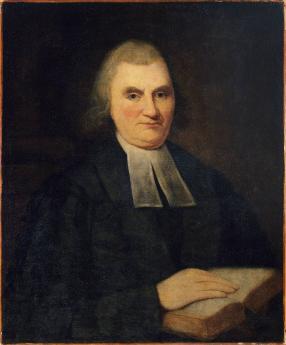
|
| Dr. Witherspoon |
The most eminent Scotsman in Colonial America was the Reverend Dr. Witherspoon, an eminent Presbyterian minister and President of the College of New Jersey, later Princeton University. Already at the top of the academic heap in Scotland, he was recruited for Princeton on the advice of Benjamin Franklin, who knew his political sentiments well. From England, Witherspoon made the following exhortation to his future compatriots at the critical moment of the Declaration of Independence:

|
| Scottish Pipers |
"To hesitate at this moment is to consent to our own slavery. The noble instrument on your table, which insures immortality to its author, should be subscribed this very morning by every pen in this house. He who will not respond to its accents and strain every nerve to carry into effect its provisions is unworthy the name of freeman. Whatever I may have of property or reputation is staked on the issue of this contest; and although these gray hairs must descend into the sepulcher, I would infinitely rather that they descend hither by the hand of the executioner than desert at this crisis the sacred cause of my country."
On the humbler level of popular doggerel, was the following:
"And when the days of trial came,
Of which we know the story,
No Erin son of Scotia's blood
Was ever found a Tory. "
It may not be quite true that the Scotch-Irish immigrants started the Revolution, or led it, or did most of the serious fighting. But in Pennsylvania their role was decisive. New England started most of the trouble, the aristocrats of Virginia quickly rose to the challenges of chivalry, but Pennsylvania was not so darned sure about this business. The back-country Germans were perfectly content to farm the richest topsoil they ever heard of, the Quakers were peaceful and prosperous just as they were. It was the Scotch-Irish of the frontier, needing no pretext of Tea Taxes or Stamp Acts to hate the English King, who were ready to take the musket off the wall at the slightest provocation.
It is indeed puzzling in retrospect to wonder what the English Kings were trying to achieve. Having driven the Scots out of their Scottish homeland into Ireland where they would be less bother, they subsequently drove them out of Ireland as well. The short explanation has been offered that James II who was to be driven off the throne for his Catholic leanings, had seen Ireland as a fall-back refuge in case of trouble and wanted it safely Catholic. So in anticipation of what did indeed happen under William and Mary, he wanted the Presbyterians out of there.
There is perhaps some logic to this, but try telling it to a Scot.
The Schools of School House Lane

|
| Union School founded in 1759 |
The region of Philadelphia defined as Germantown is recorded by the last census as having about 50,000 inhabitants today, 40,000 of whom are of the black race. Germantown has always had an unusual concentration of schools of the highest quality, and here on one street alone there are four. School House Lane runs off to the West of Germantown Avenue, and was originally right at the center of town, the center of the action during the Revolutionary War. The most historic of the schools, the Union School founded in 1759, changed its name to Germantown Academy, and more recently picked up and moved to new quarters in Fort Washington. George Washington sent his nephew there, and its building served as a hospital for the wounded in the Battle of Germantown. When Germantown Academy moved out of Germantown, the Pennsylvania School for the Deaf moved into the vacated quarters. This school had been originally founded in 1820, and is one of nearly a hundred special schools for the deaf in the United States, operating as a quasi-public institution for about 170 students. A remarkable thing about all schools for the deaf is the high IQ of their students. Perhaps deaf underachievers are somehow filtered out by the struggle to adapt before they apply for admission, or perhaps there is something about being deaf that makes you smart. In any event, the average SAT scores of students from PSD, like all schools for the deaf, are always in the very highest ranks among secondary schools.
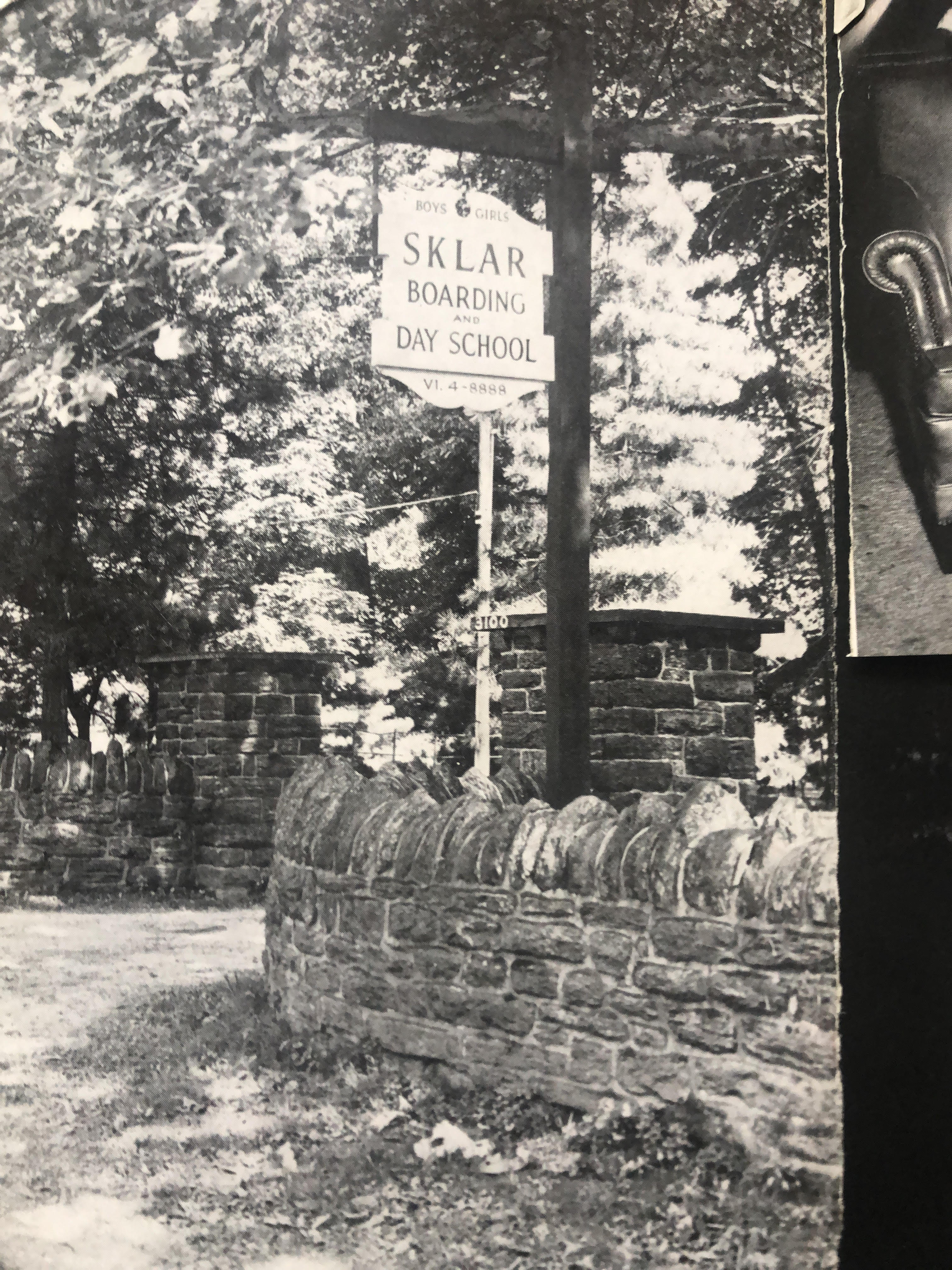
|
| Sklar School Entrance |
More or less next door to it, fronting on Coulter Street, is the Germantown Friends School(GFS), which enjoys and deserves the reputation of the most intellectually rigorous school in the Philadelphia region. There is little question about the Quakers of this school, founded in 1845, but relatively few of the students are now Quaker children. It's pretty expensive and quite uncompromising about its academic standards, but if you want to be accepted by a famous University, this is the place that can boast the most achievement of that variety. By no means all of its graduates become teachers, but alumni of this school do tend to gravitate to the top of academia. That could eventually put them on college admission committees, of course, and perhaps the admission process promotes itself. There can be little doubt that if most of a given college's admission committee happened to play the tuba, that university would soon fill up with tuba players.
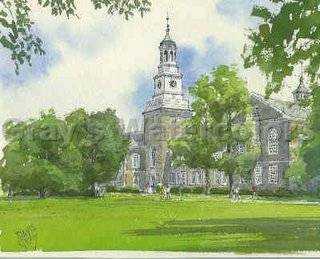
|
| William Penn Charter School |
Further West on School House Lane, is the William Penn Charter School. It's also Quaker, and while it doesn't work quite so hard at it as GFS does, it has plenty of social mission, a great deal more discipline, and plenty of competitive athletics. A minority of its students, also, are Quakers; but as a guess, most of its graduates are headed for disproportionate affluence anyway. The middle school is named for, and was donated by, the former chairman of Morgan Stanley back before Morgan Stanley sold itself to Dean Witter. This school was founded in 1689, and for a long time was located at 12th and Market Streets in Philadelphia, right where the famous PSFS building was built, the one that later converted to Lowe's Hotel .
Finally, near the crossing of Henry Avenue with Schoolhouse Lane, is the Philadelphia University. Since it was founded in 1999 it is the youngest of the schools on School House Lane, specializing in architecture and design, and seems headed for even broader curriculum. The University was formed by the merger of Ravenhill Academy for Girls, and the Philadelphia Textile School. The Textile School was itself formed during the 1876 Philadelphia Centennial, when local industrialists became concerned with how backward America seemed in its quality and design of textiles, compared with other nations which exhibited at that World's Fair. Next door, was once the home of William Weightman, a chemical manufacturer who was reputed to be the richest man in Pennsylvania. After his death, the rather grand estate became the site of the Ravenhill School for Girls, which was the school which could boast Grace Kelly for an alumna. That was natural enough since she lived just around the corner on Henry Avenue and could walk to school. The contrast between the two ends of School House Lane, Henry Avenue on one end, and Germantown Avenue on the other, is just astounding.
So there you have School House Lane. A few short blocks with three distinguished preparatory schools and a university. Plus, the site of three other famous schools which have either moved or merged. You might think Germantown was the home of myriads of school teachers, but that isn't exactly so. It's hard to say just what this complex anomalous situation proves, except to voice the opinion that it is somehow at the heart of what Philadelphia really is.
Note, kind readers have also sent me the names of six more schools on Schoolhouse Lane. Some of them may only be name changes, but the list includes Parkway Day School, Sklar School, Philadelphia Textile and Science, Germantown Stevens Academy, Germantown Lutheran Academy, Greene Street Friends School. (See Comments.)
Military School
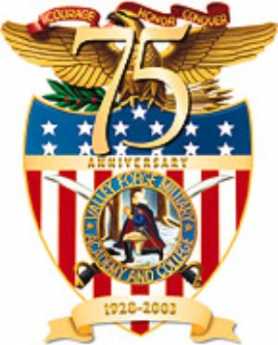
|
| VFMS Crest |
In the middle of the pacifist Quaker farm region, in fact in the middle of William Penn's Quaker Welsh Barony, sits Valley Forge Military Academy. Its location seems even stranger when you consider the nearest town, within easy walking distance, is Wayne, PA described by David Brooks in Bobos in Paradise as the East-Coast epicenter for yuppie education-based elitism, with all its air of entitlement. In fact, Brooks does not mention the Academy once in his three hundred page book about the town. What is VFMA and why is it located where it is? Three names, Baker, Mellon, and Annenberg pretty much explain it. Lieutenant General Milton Baker, a great friend of the Eisenhower family, was passionate about Valley Forge, its history, its parks, its military hospital, its renovation, and its preservation. If Baker founded a school (in 1928), it was going to be here. The money was Mellon and Annenberg money, but Baker was their man.
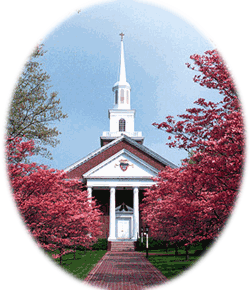
|
| Military school |
Military schools are now in a period of decline. A flurry of a building after the Civil War created about 600 of them, in recognition that the North nearly lost the Civil War to the Confederate States who had a much stronger military tradition, especially in Virginia. It's therefore not surprising that Valley Forge wanders from Southern traditions, and is consciously modeled after Sandhurst, the British Royal Military College. Valley Forge competes with Canada, Australia and Great Britain for foreign students, while the Southern schools are more provincial. There seem to be two main reasons to send your son to a military boarding school.
The first is the tradition of military aristocracy, traceable in a sense to feudalism and the Knights of the Round Table. There's little patience with a politically correct speech in the military, who readily tell you that many rich families encourage their daughters to marry career military officers, as a way of strengthening loyalties between these two power groups. During the formative years of the American republic, the resounding emphasis was placed on having no standing army. That was a cloaked way of restraining a military aristocracy and seems to have provided the main reasoning behind the constitutional Second Amendment, which projects a general right of all citizens to bear arms. It follows the model of Switzerland where military service is universal, as contrasted with limiting firearms to specialists, whether police or military. If that was the goal, it seems to have been effective; military elites now seem most appealing to foreign cultures, like Latin America, Korea, Saudi Arabia. Tony DeGeorge, the current president of Valley Forge, tells of an astounding phone call from one Saudi prince, who responded to an alumni fund-raising appeal by offering to buy the whole school. The Saudi noticed one supposes, that "Storming' Norman" Schwarzkopf, the hero of the First Gulf War, was an alumnus of Valley Forge.
The other main reason to send your son to military boarding school, is because he's too unruly to handle at home. Here is another seemingly delicate matter the school makes no bones about. All new entrants must spend six weeks as "plebes", enduring a ferocious hazing discipline that weeds 'em out. The solution to cell phones and Internet games is to forbid them. Valley Forge confronts the matter of recreational drugs head-on. All students are subject to random drug testing, and a positive test means get off the school grounds -- permanently -- within four hours. The exercises program is not only mandatory, but it is also rigorous beyond description. The result is that fifteen alumni are currently playing professional football in the NFL, the polo team is regularly the national champion. Somewhere General Baker got the idea that playing music helps your mathematical ability, so every single 9th grader plays the violin. The marching band is internationally famous, and by gad, it better stay that way. Only about a third of the graduates go on to a lifetime military career, but another third of the alumni are CEOs of companies. Even what happens to the remaining third bears some thought.
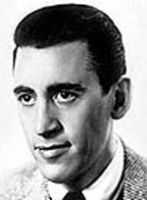
|
| J.D. Salinger |
J.D. Salinger and Edward Albee were both alumni of Valley Forge Military Academy. True, General Baker told Salinger that The Catcher in The Rye was rubbish, and one need not speculate much on how he would have reviewed Who's Afraid of Virginia Woolf? Nevertheless, it cannot be denied that the collision between these two social misfits and the plebe hazing experience contributed significantly to the depth and power of the serious literature they produced. It is not easy to name two alumni of Andover, Exeter or Lawrenceville who have contributed as much to 20th Century American fiction. Salinger and Albee hated the place, but it made them what they became. "Whatever that was," you can almost hear the other two-thirds of the alumni mutter.
In a day that echoes No Child Left Behind, it is a little hard and it is certainly politically incorrect, to give this devil its due. But all Armies live by the slogan, that if you must take an objective, you must take some casualties.
Germantown Before 1730
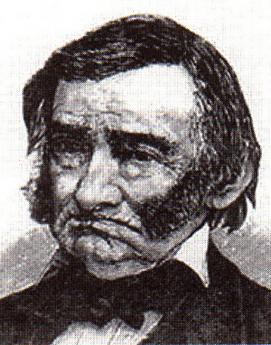
|
| Rev. Wilhelm Rittenhausen |
The flood of German immigrants into Philadelphia after 1730 soon made Germantown, into a German town, indeed. From 1683 to 1730, however, Germantown had been settled by Dutch and Swiss Mennonites, attracted by the many similarities between themselves and the Quakers of England. They spoke German dialects to preserve their separateness from the English-speaking majority but belonged to distinctive cultures which were in fact more than a little anti-German. This curiosity becomes easier to understand in the context of the mountainous Swiss burned at the stake by their Bavarian neighbors, Rhinelanders who sheltered them from various warring neighbors, and Dutchmen at the mouth of the Rhine, all adherents of Menno Simon the Dutch Anabaptist, but harboring many differences of viewpoint about the tribes which surrounded them.
Anabaptism is the doctrine that a child is too young to understand religion, and must be re-baptized later when his testimony will be more binding. In retrospect, it seems strange that such a view could provoke such antagonism. These earlier refugees were often townspeople of the artisan and business class, rapidly establishing Germantown as the intellectual capital of Germans throughout America. This eminence was promoted further through the establishment by the Rittenhouse family (Rittinghuysen, Rittenhausen) of the first paper mill in America. Rittenhousetown is a little collection of houses still readily seen on the north side of the Wissahickon Creek, with Wissahickon Avenue nestled behind it. The road which now runs along the Wissahickon is so narrow and windy, and the traffic goes at such dangerous pace, that many people who travel it daily have never paid adequate attention to the Rittenhousetown museum area. It's well worth a visit, although the entrance is hard to find (try going west on Wissahickon Avenue then turning around, a little beyond the entrance).
Even today, printing businesses usually locate near their source of paper to reduce transportation costs. North Carolina is the present pulp paper source, several decades ago it was Michigan. In the Seventeenth and Eighteenth centuries, paper came from Germantown, so the printing and publishing industry centered here, too. When Pastorius was describing the new German settlement to prospective immigrants, he said, "Es ist nur Wald" -- it's just a forest. A forest near a source of abundant water. Some of the surly remarks of Benjamin Franklin about German immigrants may have grown out of his competition with Christoper Sower (Saur), the largest printer in America, and located of course in Germantown.
Francis Daniel Pastorius was sort of a local European flack for William Penn. He assembled in the Rhineland town of Krefeld a group of Dutch Quaker investors called the Frankford Company. When the time came for the group to emigrate, however, Pastorius alone actually crossed the ocean; so he was obliged to return the 16,000 acres of Germantown, Roxborough and Chestnut Hill he had been ceded. Another group, half Dutch and half Swiss, came from Krisheim (Cresheim) to a 6000-acre land grant in the high ground between the Schuylkill and the Delaware. The time was 1683. The heavily Swiss origins of these original settlers give an additional flavor to the term "Pennsylvania Dutch".
Where the Wissahickon crosses Germantown Avenue, a group of Rosicrucian hermits created a settlement, one of considerable musical and literary attainment. The leader was John Kelpius, and upon his death the group broke up, many going further west to the cloister at Ephrata. From 1683 to 1730 Germantown was small wooden houses and muddy roads, but there was nevertheless to be found the center of Germanic intellectual and religious ferment. Several protestant denominations have their founding mother church on Germantown Avenue, Sower spread bibles and prayer books up and down the Appalachians, and even the hermits put a defining Germantown stamp on the sects which were to arrive after 1730. The hermits apparently invented the hex signs, which were carried westward by a later, more agrarian, German peasant immigration, passing through on the way to the deep topsoil of Lancaster County.
Settlement Music School
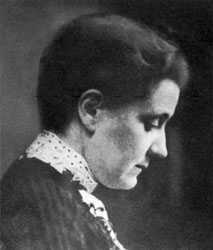
|
| Jane Adams |
The Settlement Music School has six branches, fifteen thousand current students, an $8 million budget, and three hundred thousand alumni. It tells you something about Philadelphia that an organization this large can exist for 98 years, and yet remain almost invisible. So let's tell a few things about it.
The settlement movement began in England around 1880, and was brought to America by a Quaker lady named Jane Addams. Her most famous settlement was called Hull House, in Chicago. Jane Addams seconded the nomination of Theodore Roosevelt at the Progressive Party convention, and was active in the formation of National Association for the Advancement of Colored People, as well as the American Civil Liberties Union. She was a prominent suffragette, and as a Quaker, it might be expected that she was an outspoken pacifist. Remember, what we are talking about here is music.

|
| tenement districts |
Settlements were what nice upper-class ladies called the tenement districts, and a settlement House was a center for activist women to go help the immigrant groups typically found there. Since there is obviously a lot of difference in what needs to be done to help recent ex-slaves, Italian and Jewish immigrants, and all the different ethnic clusters, the Settlement movement is an archipelago of very different forms of social work. One of the ways to appeal to different groups is through the teaching of music, and the teaching on expensive bulky instruments like pianos is quite naturally shared in a school building. While it is true that a couple of Settlement students are admitted to the musical big time at Curtis Institute every year, only a small proportion of Settlement students go on to musical careers. The three most famous musical alumni of the Philadelphia Settlement Music School were Chubby Checker, who invented a dance called the Twist, Albert Einstein. who played the violin in various chamber groups, and former Mayor Frank Rizzo, who learned to play the clarinet.
The mission of the Settlement School has gradually become the spreading of musical appreciation, especially among "the masses", and it measures its success in the size of its audiences rather than by occupying the center of the stage. This function is readily thrust off on them by the eagerness of public school boards to cut expenses, although the School is scarcely in a financial position to go all the way and assume the role of teaching music classes to 250 public schools. Nevertheless, when financial stringency forces the school board to cut expenses, their choice between a music teacher and a football coach is no choice at all. At that moment, a free-standing music appreciation school ceases to be a competitor and becomes a safety valve. When you hear the Settlement School is in need of money, you are likely being told about stringency in the public school budget.
Although the tuition is quite inexpensive for a music school, the students collectively contribute about half of the annual budget. The rest comes mostly from private charity. You really can't expect cutting edge innovation from school children or endowed charities. But somehow this school leaves you with an impression of big missed opportunity in the truly American forms of music like jazz and folk singing. Symphony orchestra was invented in Vienna and flourishes there, so it has a faintly foreign air to it. It's not completely surprising that both the sponsors and the subjects of Americanization for the Slums are hesitant to promote symphonic role models, while the sponsors at least are a little lost in the world of Rock. Not surprising, but something of a pity.
Tree Huggers: Delaware Valley College
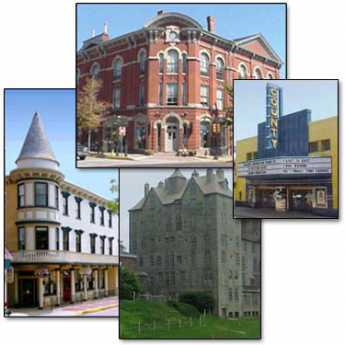
|
| Doylestown, PA |
At the time when Philadelphia and New York were both occupied by the British during the Revolutionary War, a backwoods highway connected the thirteen colonies. Doylestown is 35 miles due north of Philadelphia City Hall, at the point of intersection of this variant of the Ho Chi Minh Trail with the path which Philadelphia Tories took in their flight to Kingston, Ontario. No doubt there were some interesting conversations in Mr. Doyle's tavern at the crossroads.
Doylestown is also on the invisible border between the hegemonies of Philadelphia and New York, where descendants of German and Quaker farmers make a cautious contact with the distinctly non-Quaker artists and writers fleeing south from New York. James Michener and Pearl Buck once represented Philadelphia in the cultural stew with New Yorker ex-patriots, Somehow in this interface, a place is found for the Delaware Valley College, which started life in 1896 with Jewish founders of the National Farm School. The original board of trustees included such names as Gimbel, Lit, Snellenburg, and Erlanger, but the three-year curriculum was entirely agricultural. The founder himself was Joseph Krauskopf, who got the idea after an inspiring interview with Count Leo Tolstoy.
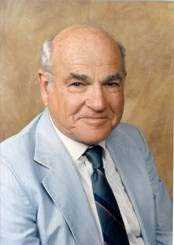
|
| Baruch Blumberg |
From a single building which served as classroom and dormitory, the college has grown into a four-year institution in numerous buildings scattered over a 570-acre plot with a second 120-acre farm in Montgomery County. The school is determinedly non-sectarian, and for forty years has been coeducational. It has had several changes of name, from the National Farm School, eventually to its present name. The curriculum has expanded as well, with masters degree programs in business and education. Baruch Blumberg, the Nobel Prize winner in Medicine, maintains an office there, and it is clear the college means to shift its emphasis toward the scientific basis of agriculture and the environment. It's also pretty clear that rising agricultural prices will soon re-establish agriculture as a dominant feature of our economy, although agriculture in the modern sense is quite a distance from farming in the old sense, and requires a different sort of educational preparation.
The Right Angle Club of Philadelphia recently heard from Joshua Feldstein the chairman of the board of trustees, and the brand-new president, just moving in from Columbia University. Sixty-eight years of driving ambition is personified in one, and the bright shining future in the other. We wish them well.
By the way, the tree hugger nickname comes from a campus tradition of this college, very much an active ceremony, of hugging the 400-year-old oak standing beside the president's house on the campus. The College, of course, is 250 years younger than the tree.
WWW.Philadelphia-Reflections.com/blog/1295.htm
Rise and Fall of Books
| ||
| The Library Company of Philadelphia |
John C. Van Horne, the current director of the Library Company of Philadelphia recently told the Right Angle Club of the history of his institution. It was an interesting description of an important evolution from Ben Franklin's original idea to what it is today: a non-circulating research library, with a focus on 18th and 19th Century books, particularly those dealing with the founding of the nation, and, African American studies. Some of Mr. Van Horne's most interesting remarks were incidental to a rather offhand analysis of the rise and decline of books. One suspects he has been thinking about this topic so long it creeps into almost anything else he says.
 |
| Join or Die snake |
Franklin devised the idea of having fifty of his friends subscribe a pool of money to purchase, originally, 375 books which they shared. The members were mainly artisans and the books were heavily concentrated in practical matters of use in their trades. In time, annual contributions were solicited for new acquisitions, and the public was invited to share the library. At present, a membership costs $200, and annual dues are $50. Somewhere along the line, someone took the famous cartoon of the snake cut into 13 pieces, and applied its motto to membership solicitations: "Join or die." For sixteen years, the Library Company was the Library of Congress, but it was also a museum of odd artifacts donated by the townsfolk, as well as the workplace where Franklin conducted his famous experiments on electricity. Moving between the second floor of Carpenters Hall to its own building on 5th Street, it next made an unfortunate move to South Broad Street after James and Phoebe Rush donated the Ridgeway Library. That building was particularly handsome, but bad guesses as to the future demographics of South Philadelphia left it stranded until modified operations finally moved to the present location on Locust Street west of 13th. More recently, it also acquired the old Cassatt mansion next door, using it to house visiting scholars in residence, and sharing some activities with the Historical Society of Pennsylvania on its eastern side.
 |
| Old Pictures of the Library Company of Philadelphia |
The notion of the Library Company as the oldest library in the country tends to generate reflections about the rise of libraries, of books, and publications in general. Prior to 1800, only a scattering of pamphlets and books were printed in America or in the world for that matter, compared with the huge flowering of books, libraries, and authorship which were to characterize the 19th Century. Education and literacy spread, encouraged by the Industrial Revolution applying its transformative power to the industry of publishing. All of this lasted about a hundred fifty years, and we now can see publishing in severe decline with an uncertain future. It's true that millions of books are still printed, and hundreds of thousands of authors are making some sort of living. But profitability is sharply declining, and competitive media are flourishing. Books will persist for quite a while, but it is obvious that unknowable upheavals are going to come. The future role of libraries is particularly questionable.
Rather than speculate about the internet and electronic media, it may be helpful to regard industries as having a normal life span which cannot be indefinitely extended by rescue efforts. No purpose would be served by hastening the decline of publishing, but things may work out better if we ask ourselves how we should best predict and accommodate its impending creative transformation.
www.Philadelphia-Reflections.com/blog/1470.htm
Gallatin Part II
Act 1 Gallatin Triumphantly Returns to Congress.
When Washington pardoned the Whiskey Rebels, Gallatin was immediately elected to Congress. It was his payback time for Hamilton and all his works. The desperate Federalists tried to oust him a second time with a Constitutional Amendment, which failed before the force of Gallatin's oratory. Gallatin then threw his influence behind Jefferson's deadlocked congressional contest with Aaron Burr, electing Jefferson and earning his own reward as Secretary of the Treasury. Although elected Vice President, Burr's fury is turned against Hamilton, foreshadowing the coming duel.
Act 2 The Virtuoso Financier.
Jefferson proves hopeless in domestic affairs, so Gallatin essentially takes over that role, just as Hamilton had taken over from Washington, who was another Virginia cavalier adrift in these matters. Gallatin promptly repealed the whiskey tax, cut government expenses, in particular, the million dollars annual tribute to the Barbary pirates, and almost performed magic in financing the Louisiana Purchase together with Stephen Girard and William Bingham.
Act 3 Burr Kills Hamilton
After his Vice President kills the leader of the opposition party, Jefferson's party was on the political defensive. But not Gallatin, who spits out his famous remark, "A majority of both parties seem disposed to deify Hamilton and treat Burr as a murderer. The duel, for a duel, was certainly fair." It is an all-time low moment in the politics of the young nation.
Act 4 Diplomacy or War?
As the Napoleonic wars engulf the whole world, both England and France harass our merchant ships, and cries go up for war. Partly out of a desire to annex Canada in the process, Gallatin sneers at proposals to restrain the fighting Europeans with mere sanctions. His prediction proves dismayingly correct that nothing would come of it except to make our own citizens into smugglers.
Act 5 War It Is.
The First Bank's charter was to expire in 1811, and the bank closed, creating an opportunity for Girard to buy it out and finance the coming war himself. Gallatin was desperate to end the war as quickly as possible, especially after the British burned Washington. To speed matters up, Gallatin took a leave of absence and went off to the peace conference in St. Petersburg himself.
Epilogue in front of the curtain.
Gallatin finally announces his resignation from the longest term of Treasury Secretary in our history. He is seventy years old, three scores and ten. Rather than play golf, he was to spend the last eighteen years of his life in three more careers. As a diplomat, he negotiated both our permanent northern and southern borders. As an academic, he founded the discipline of ethnology with the study of native Indian languages, meanwhile founding New York University. And as a banker, he founded a bank which has since evolved into JPMorgan Chase. After all, a man has to find something to keep himself busy.
On the Subject of Rights

|
| Scotch-Irish Presbyterians of Appalachia |
MOST Americans of the 18th century regarded themselves as members of some minority group. The constitutional Founding Fathers, mindful of Cromwell and the English Civil War, were concerned that majority rule might evolve into tyranny. They searched to protect minorities. Because everyone could imagine being outvoted on some dispute, minority status was a universal American concern about democracy. There was a particularly hot political center of Bill of Rights agitation among Scotch-Irish Presbyterians of Appalachia which persists after two centuries, consequently among Southerners and western Pennsylvanians. In those strongly religious days, it seemed self-evident minorities had "divine" rights, conferred by God, which legislatures must not violate, and legislatures repeatedly seemed to agree. As dissenting minorities later became increasingly secular, the language of rights shifted to "natural" rights, without changing much else. Created by the purely logical analysis of the Enlightenment: a right was something anyone would willingly confer to others in order to preserve it for himself. In more contemporary language, the evolving demand is now for "human" rights, whose mystical authority grows from the intensity with which it is demanded. Although "Vox populi" sounds Roman, the concept of infallibility ("Vox Dei"), is an outgrowth of victory in the American Revolution. Underneath semantic wrestling, one essential is demanded: no government, whether by the king or elected majority, may overrule it. The unthreatened majority easily wearies of such agitation and remains more pragmatically concerned with efficiency, peace, and prosperity. Our two political parties began with Bill of Rights outcry, one party appalled by the French Revolution, the other applauding its feisty spirit.
 A little rebellion now and then is a good thing . . . .It is a medicine necessary for the sound health of government... God forbid we should ever be twenty years without such a rebellion. The people cannot be all, and always, well informed. The part which is wrong will be discontented, in proportion to the importance of the facts they misconceive. If they remain quiet under such misconceptions, it is lethargy, the forerunner of death to the public liberty . . . . and what country can preserve its liberties, if its rulers are not warned, from time to time, that these people preserve the spirit of resistance? Let them take arms. The remedy is to set them right as to the facts, pardon and pacify them. What signify a few lives lost in a century or two? The tree of liberty must be refreshed, from time to time, with the blood of patriots and tyrants. It is its natural manure. 
|
| Thomas Jefferson, 1787 |
The founders of the American republic arrived at a compromise formula: strengthen majority-rule government to a point where it can be effective, but keep government too weak to tyrannize a minority. This Constitutional effort first grew out of a general perception that the Articles of Confederation were too weak to be effective, so the new federal government must be able to control the states in a small number of specified areas. But having achieved that, a reverse concern immediately arose. Since slaves and poor people would probably always outnumber rich ones, how can a democracy be prevented from freeing slaves, or poor people from voting themselves the property of rich ones? This concern was surely heightened by earlier maneuvering by two Virginians. Madison and Washington pressed to have Convention delegates be made up of prominent people, preferably former officers of the Continental Army. Their plan to ensure ratification was for legislatures to make way before a Convention of celebrities. It probably did not occur to the two Virginia plantation owners that this selection process might seem to be purely motivated to ensure the best interests of rich people. Rich people usually have power, regardless of not having a majority. Except for perhaps Gouverneur Morris, Convention delegates, however, were not aristocrats but self-made men, and with few exceptions successful ones. It remains hard to argue with their instinctive reaction that if laws make it impossible for those who have been successful in the past to become a self-made success, then it is impossible to see anyone achieving success. Eighty years subsequently the slave component of this issue was finally settled, but sectional bitterness took its place.
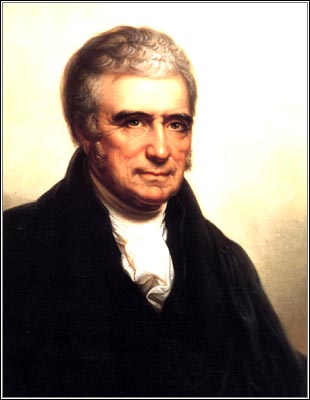
|
| Chief Justice, John Marshall |
The Constitutional Convention weakened the new government to avoid its misuse by a popular majority. They designed separation of its powers, perhaps hoping a balance of power would develop among the Legislative, Executive and Judicial branches, each selected in different ways. As the matter was finally ratified, it seemed a little inadequate. James Madison, in particular, rebelled against the final step of giving the Supreme Court the power to review for constitutionality the laws passed by Congress and signed by the President. It remained for the fourth Chief Justice, John Marshall, to assert judicial review in 1803, sixteen years after the Constitutional Convention. Perhaps with an eye toward symbolism, he did so in a case called Marbury v. Madison.
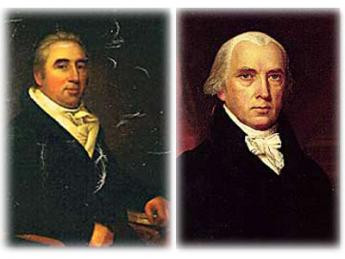
|
| Marbury v. Madison |
This case, strengthened and amplified by later cases with the same outcome, was to enshrine the Constitution as the capstone of the enforcement system of the United States, with all lesser laws consistent with constitutional powers enumerated -- powers implied, and powers are forbidden. This capstone structure, rather than American provincialism so noticed by Europeans, explains why American law has drifted from common law to statutory law, while references in Supreme Court opinions to viewpoints in foreign law are greeted with derision. Foreigners are not given a vote in our system, and our system is grimly determined to recirculate the opinions of its own citizens through the system, especially through the choke-point of the Constitution. In biochemical terms, the Constitution is the rate-limiting factor. It is far too late to try to make it easier to amend the Constitution, just as it is surely too late to eliminate the Electoral College for selecting the President. Too many balance-wheels have been hooked to these fundamentals. Blame it on interest groups if you please, but seriously disturbing these fundamentals will prove unsettling enough to undermine any interest groups that assail them.
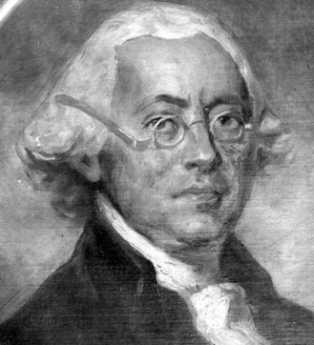
|
| James Wilson of Pennsylvania |
With the blocking of other avenues to constrain majority rule, the system has possibly provided a new one, which may someday be named after James Wilson of Pennsylvania. Wilson lived at the corner of 3rd and Walnut, making it convenient to sign both the Declaration of Independence and the Constitution. Although he spoke 168 times at the Constitutional Convention, his name is most often associated with the idea that basic legal principles should be part of the general background of all educated citizens. Sometimes referred to as the founding professor of the first law school, the University of Pennsylvania, Wilson recognized that the actual practice of the law soon drifts from legal principles to settling on legal mechanics. Law students eventually come to learn that what matters most is what a judge recently handed down as an important opinion setting a new precedent. Step by step the law moves from principles to precedents, and from early precedents to recent precedents. The system is said to be a higher variant on the scientific method -- hypothesis, tests of the hypothesis, modified hypothesis and then tests of the modified version -- first created by Sir Francis Bacon. The law, in short, drifts away from Original Intent but does so proudly, denying a subversion of original principles but asserting a reasoned response to actual experience. Perhaps, in this enlightening process, new human rights can be discovered. Such as a right to abortion based on a right to privacy, based on something else you will have to read the original opinion to recall. It is not necessary to be a fundamentalist Christian to be alarmed by this process when it travels so far from the choke point of the Constitution, overturning dozens of state laws as it goes. Perhaps the most serious criticism of Roe v. Wade is that only two alternatives exist for those who wish to modify it: either undermine the Supreme Court by packing it with supporters of change or else amend the Constitution, which would be nearly impossible to do. Entirely too many plain non-lawyers who have no objection to abortion have read the Constitution and are now mistrustful. Mistrustful of the reasonings of Justice Blackmun, of the profession which acquiesced to his action, and of the intellectual migration process being defended. Whether they know it or not, they are followers of James Wilson, of 3rd and Walnut, Philadelphia.

|
| Jennifer Nedelsky |
Jennifer Nedelsky is a Canadian lawyer who has been active in promoting an alternative to our system of using a constitutional right as a legal "trump card for displeasing laws.", as well as the failed European attempt to invent dozens of new human rights as a way of limiting government power. In Canadian law, a feature is called the "time-limited notwithstanding clause." The legislative branch in Canada is permitted to pass laws which violate a constitutional right, "notwithstanding that right for five years". It is possible to understand the appeal of this legal safety valve, to wait out the popular appeal of a mere fad, or to provide emergency relief in the face of unexpected circumstances. Some of the enduring problems with the legislation passed during the Roosevelt court-packing era might have been more generally acceptable with this clause attached. And it might even address the temptation recently embraced by Rahn Emanuel, that no crisis should ever be wasted. It is true that some appalling legislation does occasionally turn out to be useful. More often, however, it is a well-intended and highly acclaimed law which turns out to create a muddle.
Ultimately, however, we are likely to fall back on the comfort that our Constitution more or less as originally created, has lasted over two hundred years while no other constitution can match that claim. Others have their proposed systems but we have our proven one.
Commercial Academic Think Tank
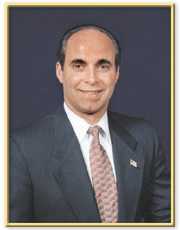
|
| Stephen P. Mullin |
Stephen P. Mullin recently addressed the Right Angle Club of Philadelphia about assorted economic subjects; he is certainly qualified. He was once the only Republican in Mayor Rendell's cabinet, acting first as Finance Director and then as Commerce Director. At first, he doesn't appear extroverted enough to be a politician but quickly demonstrated that he knew the first names of more of the members of the club than the president did, so maybe he does have the innate talents of a politician. Urban political machines don't usually respond cordially to graduates of Exeter and the Wharton School of the University of Pennsylvania. A number of University professors are consultants to the firm, which offers statistical economic advice to the many law firms in town, to philanthropic organizations considering public-interest projects in the region, to government agencies faced with regulating unfamiliar activities, and very likely to anyone else willing to pay for the service of academics, statisticians and analysts. It certainly sounds like a service that governments and philanthropies need, and which the region needs to avail itself of. In a way, it is probably something the University needs, as well. A friend of mine is now retired, but at one time I commuted on the train with an academic administrator of the Wharton School, who was quite obviously disturbed by handing diplomas to students who promptly took jobs which paid those graduates more than he was paid himself. Obviously, such a system cannot persist very long without creating a brain drain, so income supplementation by commercial consulting is a necessary and valuable support for academics. There are, of course, probably some negative features as well.
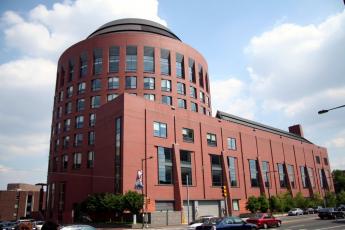
|
| The Wharton School |
It is interesting to hear from Steve how Philadelphia can be variously described. We have, for example, significantly less foreign immigration than other cities. New York, by contrast, has net immigration of about 700,000 persons a year; such forces can quickly transform a city in a variety of ways. The bombing of West Philadelphia during the Goode Administration was news for a while, then vanished from the papers. But it had a shattering effect on Philadelphia commerce, leading to a period of 8 or 9 years when there was essentially no private investment in the city. Philadelphia indeed now needs to have its municipal bonds issued by the state bonding authority, because our own bond rating is so low the extra cost of municipal debt is a significant one. And there is the cost of invisible shifting of power to Harrisburg. An unexpected result is that sales and real estate transfer taxes escalated to make up for property taxes which they could not possibly be raised as much as inflation. Real estate was in big trouble; whether ingenious strategies like the 10-year tax abatement for a new property will be successful in rescuing the real estate industry, remains to be seen. New office towers have been built, but they drain off tenants from older office buildings. We're seeing a massive conversion of older office space into residential apartments, an apparently successful maneuver. But that drains the older residential areas, which leads to -- well, who knows what it will lead to, but it could be slums.
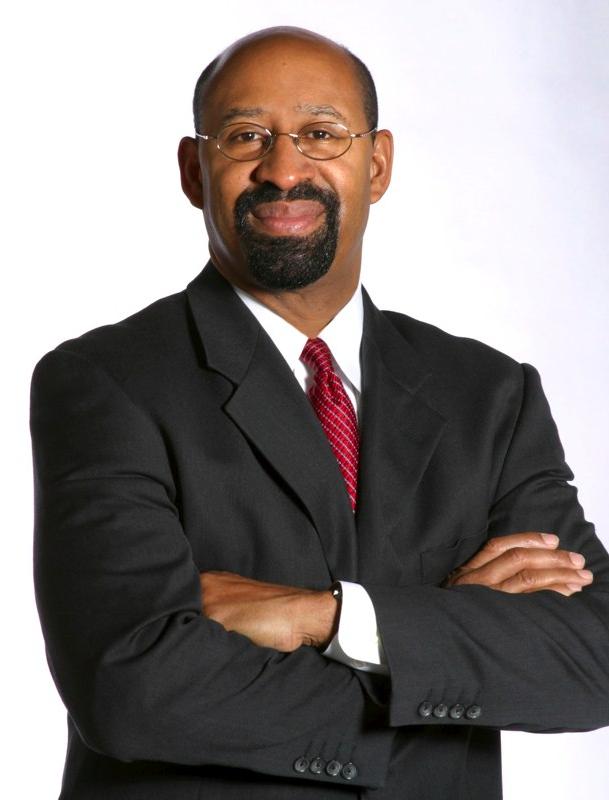
|
| Mayor Michael Nutter |
The traditional hostilities between Philadelphia and its neighbors can be defined in a new way, too. For a century, Philadelphia contributed more tax money to the rest of the state than it received in state services. But in the past 20 years, Philadelphia city has become a net importer of an annual billion dollars -- from the rest of the state. Two or three billion go to the schools, which the rest of the state regards as a deplorable waste in view of the quality of the product. And yet, the most hopeful feature of the situation is the vigor and ingenuity of the attempts being made to rescue the situation. In a certain sense, Mayor Nutter is the candidate of the Wharton School. He may well have some innovative ideas, and academic places like the Wharton School will surely suggest others. It remains to be seen whether Nutter can combine idealism with sufficient ruthlessness to make the city function. Cynical oldtimers will grumble that a mayor has to employ a moderate amount of deception and corruption in order to accomplish his mission. Maybe that overstates things, but it is very certain he must be tough. He's dealing with construction unions who will certainly be tough, and whose interest in sacrificing their own agendas in order to help the schools or street crime -- always fairly small -- is even further impaired by the econometrics that 70% of them live in the suburbs. We wish our new mayor all the best, since he seems smart enough to know what needs to be done, and is definitely smart enough not to drop any bombs on houses. He's smart enough to see that extra city revenue derived from gambling might permit the lowering of wage taxes, and hence an urban business recovery. But is he tenacious enough to stay in office long enough to achieve the balanced result; or will the forces of evil simply kick him out of office before wage taxes can be lowered and gambling discontinued? He won't break his promises, but will they break them for him? Beyond being competent, a city mayor needs to be tougher than the convivial but very mean friends he needs to associate with. He must, for example, decline to run for national office, the traditional way that city machines rid themselves of pointy-headed reformers.
Rara Avis
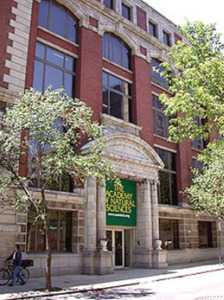
|
| The Academy of Natural Sciences |
School children grow up in Philadelphia with an image of the Academy of Natural Sciences as a place to visit dinosaurs. Indeed, it does have on display the first dinosaur skeleton ever to be discovered, as well as a number of others. However, only about a third of the building complex on Logan Circle is devoted to public museum displays. The rest is devoted to specimen storage, library and scientific work of the highest scientific eminence and value. In the scientific area, the most striking thing to a visitor is to notice how few windows there are. Scientists often spend their time looking through microscopes, so they don't care about windows. In a skyscraper business office that wouldn't be acceptable at all and the staff would all get the heeby-jeebies and quit. In the business world, the number of windows your office has is important, especially if they are corner offices, the best kind.
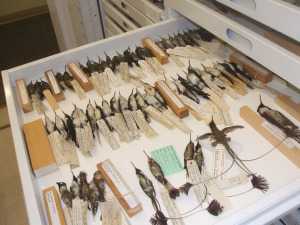
|
| Humming Birds |
In one small area of the museum is a set of ingenious metal cabinetry containing 200,000 bird specimens, including every one of the 10,000 known species of birds on earth. In fact, about a quarter of all the "type" specimens are found there with red tags on their feet. A type specimen is the first known and described specimen of that particular bird, ever. That's a round-about way of relating that this is where Ornithology, the study of birds, began. It also tells you that when bird skins are treated with arsenic salts, they last a very long time; a considerable number of the specimens in the cabinets were contributed by Audubon, himself. New bird skins are acquired at the rate of a thousand a year, related to the scientific studies which go on, studying bird diseases, genetic changes due to environmental changes, and pollution effects. The recent uproar about Avian influenza revolves around the tendency for bird diseases to undergo genetic changes themselves and become human diseases. A great many such bird diseases are maintained at the laboratory in case they are needed for a crash program of vaccine development. Environmentalists will be surprised to learn that the mercury content of bird feathers has actually declined in the past century.
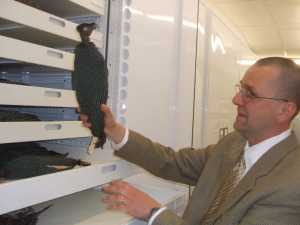
|
| Guinea fowl |
With a good guide you quickly grasp the attraction of this topic of birds and birding. There are huge condors, with six-foot wingspreads; and one-inch hummingbirds. Birds of every shape and coloring, reaching some sort of extreme with the Bird of Paradise from New Guinea. Owls and eagles, ducks and chickadees. Hummingbirds defy the usual sort of nets; every single little hummingbird specimen was obtained by shooting it with a special little gun. If you see a hummingbird in your garden, just imagine what skill it takes to shoot one.
The ornithology department maintains an active program of loaning bird specimens to scientists all over the world, although this activity has recently been affected by computerization of the catalog of specimens, resulting in a massive global internet conversation among ornithologists, sort of like a Facebook of a very special sort. For all this activity going on, the collection area is an eerily silent place.
And that's just birds, crammed into an organized space of, well, maybe fifty by two hundred feet, eight feet tall, fifty shelves per typical cabinet. Right next to it is the insect collection, perhaps taking twice the cabinet space. Insects are a lot smaller than birds, so each shelf has more specimens. That sounds like an awful lot of Latin names to try to remember. And a certain amount of danger, too. Several scientists died of arsenic poisoning before the full hazard was appreciated and contained.
Religion at Girard College:Spiritual But Irreligious
According to Cheesman A. Herrick, "After Girard had dictated that famous section of his will excluding clergymen and William J. Duane had written it down, Girard asked Duane what he thought of it. Duane, being quite unprepared for the question, and somewhat at a loss to interpret the section, answered, ' I can only say now, Mr. Girard, that it will make a great sensation.' To this Girard replied, ' I can tell you something else it will do -- it will please the Quakers.'"
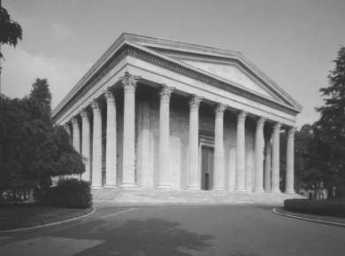 |
| Stephen Girard College Founders Hall |
In the Western part of America, Quaker meetings sometimes do have paid ministers, but the Philadelphia Yearly Meeting and it is component monthly meetings have held steadfastly to the tradition of "unprogrammed meetings"-- without ministers. Girard was not a Quaker, but he greatly admired them, and three of the five executors of his will were Quakers. It, therefore, seems likely, at a minimum, he hoped that Quaker sentiment would fortify his intended banishment of clergymen from his school for orphans, and he might well have got the basic idea from them. Quakers have long noted with disapproval that paid ministers have often publicly supported wars, and Quakers notice that governments waging wars have typically sought to stir up warlike feeling by persuading ministers to help them do so. Another behavior which is almost inherent in the clergy is for ministers to feel that they are measured by the size of the congregation they attract, and hence almost invariably proselytize for new membership. Girard had firm ideas about influencing impressionable orphans, and he did not wish to have outside ideologies capture the administration of the school. 1830 was an evangelical time, and Girard could easily imagine some highly charismatic minister captivating the school.
Other motives may, of course, be imagined. This is what is actually in the will:
Prohibiting any ecclesiastic, missionary or minister of any sect from holding or exercising any station, no such person should ever "be admitted for any purpose or as a visitor, within the premises occupied by the College...I do not mean to cast any reflection upon any sect or person whatsoever, but inasmuch as there are such a multitude of sects, and such a diversity of opinion amongst them, I desire to keep the tender minds of the orphans free from the excitements which clashing doctrines and sectarian controversy are so apt to produce." As matters were to turn out, religious meetings have been conducted by laymen almost every day at the College, and the custom grew up that the boys themselves were often called upon to conduct religious meetings. A great many graduates of Girard College eventually went on to careers in religious ministry, so it even seems likely that their experience at the school had the effect of interesting them in the ministry by giving them a taste of it.
In 1844, the numerous relatives of Stephen Girard tried to break the will. No one has seriously proposed their grievance was anything but financial. However, they sought the services of the most noted lawyer, orator, and statesman of his day, Daniel Webster. Webster would have been wise to refuse to take the case since he could think of no better argument to use than that -- the exclusion of ministers demonstrated the school for orphans was not a true charity, and only a true charity would be allowed to exclude ministers. Several days of oratory enveloped this preposterous argument, which today reads like pure bombast and humbug. The U.S. Supreme Court in time unanimously rejected his brief, with the generous comment that the law was not on his side. Other lawyers have privately remarked that such oratory was never intended to persuade a court, but to impress a rich client.
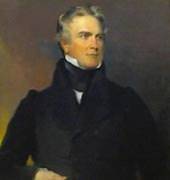 |
| Horace Binney |
Horace Binney, the lawyer son of another Horace Binney who established an enduring reputation for calmness in midst of a religious storm during the Hogan Schism, was the successful defender of Girard College. In contrast with the flowery reverberations of Webster's voice, Binney confined himself to short words in short sentences, sticking strictly to the point without appeal to emotion. In fact, one wonders why Webster stooped to it. Historians credit him for the arguments that later inspired the defenders of the Union with enough conviction to win the Civil War. Essentially, he convinced Unionists that the Constitution had not created a confederacy, but a Union, which implicitly must have all the powers needed to preserve itself. Half the nation would not accept his reasoning, however, and his willingness to proclaim nonsense in the Girard case confirmed many Southern suspicions that the Union argument was also specious. Fifteen years later, Philadelphia was quite slow in coming to the Union side, for a variety of reasons. His attacking a cherished Quaker belief in a Quaker city was certainly not useful. In time, it would be possible to hear a quiet parody of the Union's marching song, that "He died to make men holy -- we will kill to make men free."
 |
| Advice to Young Men and Boys |
It is unfortunate that the one thing most people think they know about Girard College is that religion is excluded. Far from it, there is more attention to morals and ethics than in public schools. Indeed, Girard College compares well with Phillips Exeter Academy, Webster's prep school and perhaps his model. One of the great concerns about orphans is that they may be easily led into a life of crime; there is no doubt that Girard College makes unusual efforts to keep that from happening. In fact, the school may be said to have written its own prayer book during the late 19th Century. Books of devotion were written and then organized by committees of laymen, eventually published by the Chairman, Benjamin B. Comegys. Entitled Advice to Young Men and Boys", Comegys notes that the book was published "in the hope that it may be the means of helping some boys and young men other than those to whom the Addresses were made." It would have to be observed that Girard College inspired an unusual interest in the ministry among the boys, by encouraging them to lead in the ceremonies themselves. And by having the Board of Trustees participate in the construction of books of moral principles, they no doubt similarly evoke a high sense of fidelity within the businessmen trustees. Since those entrusted with huge amounts of money are faced with huge temptations, the Trustees quite possibly need the stimulus as much as the students do.
REFERENCES
| Girard College It's Semi Centennial of Girard College: George P. Rupp ASIN: B000TNER1G | Amazon |
The Supreme Court Revisits Girard's Will
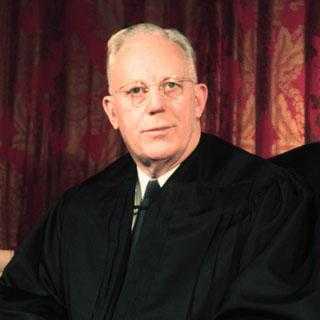
|
| Chief Justice Warren |
In the 1954 case of Brown v. Board of Public Education, Chief Justice Warren wrote an opinion for the U.S. Supreme Court (347 U.S. 483), overturning the 1896 doctrine of "separate but equal" in public school systems which the Supreme Court had laid down in Plessy v. Ferguson, 163 U.S. 537. Warren famously declared that separate was inherently not equal. The Brown decision did not extend to all public accommodations, or even to all schools. It was limited to public schools. Furthermore, in explaining why it took half a century for the Court to discover this principle, Warren pointed out the schools in the South were largely private schools at the time of the Plessy opinion, since the movement toward free common schools, supported by general taxation, had not yet taken hold. The central point in all this was that Brown desegregated public schools and nothing else. Therefore, when the case of Stephen Girard's will ("poor, white, orphan boys") came back before the Court, the issue was whether Girard College was a public school because Girard's will designate the City and State to appoint the trustees.
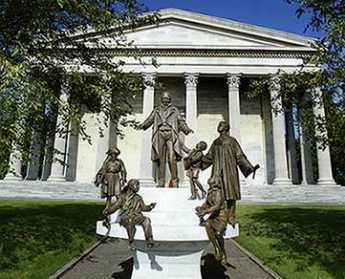
|
| Girard College |
The first black plaintiffs to seek admission to Girard College, at least in response to the Brown v. Board decision, were represented by Raymond Pace Alexander, a black member of Philadelphia City Council. Alexander maintained that the College's racial discrimination, employing the supervision of City and State governments, was unconstitutional. Since Alexander was plainly interested in the education of black students generally, it was important to stress the public school issue. Otherwise, invalidating many wills, and the policies of many private schools, would have been harmful to black students. For example, the Annenberg Foundation has donated $52 million to the United Negro College Fund, the W.K. Kellogg Foundation: $58 million for higher education for Hispanic and Native Americans, the Lilly Endowment: $92 million for the Hispanic Scholarship Fund and United Negro College Fund. The largest such private racially segregated donation is from Bill and Melinda Gates: $1 billion annually for 20 years for full scholarships for black, Hispanic, Native American and Asian students, seeking degrees in engineering, mathematics, science, and education. In the course of protracted litigation, it became clear that the Supreme Court's Brown decision could not be completely reconciled with its 1844 decision (Vidal v Girard Executors, 43 U.S. 127, upsetting the arguments of Daniel Webster) reaffirming all the language of the Girard Will. Girard made Girard College an essentially private school financed by private money. But the choice of the City and State to appoint trustees did create a degree of public involvement. Faced with challenging litigation, the courts would have to invalidate some feature or other of the will to maintain strict conformity with Brown v. Board of Public Education. Which choice -- admit black boys and girls, or find a different way to appoint trustees? Since the trustees selected by other means would very likely be exactly the same people, the choice seemed an easy legal one. The political choice was more difficult.
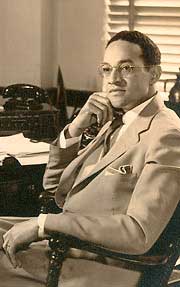
|
| Raymond Pace Alexander |
At first, the Supreme Court seemed to be taking the approach of changing the method of selection of trustees. They deflected (remanded) the matter to the Pennsylvania Supreme Court, which in turn remanded it to the Orphans Court in parallel with a newly-legislated power of the Orphans Court to appoint substitute trustees. The Girard case was headed for the conclusion that Orphans Court should either appoint new trustees or define a way to appoint them. Without the political appointment of trustees, Girard College was a fully private institution, unconcerned with the constitutionality of the Plessy decision, or with the Brown repeal of it.
However, further litigation ensued, with a new focus for the U. S. Supreme Court to ponder. The contention was made that Girard had two purposes in mind when he wrote the will. He wished to help the poor, white, orphan boys. But he also stated that he truly had the welfare of Philadelphia at heart, wishing to foster the prosperity of the City and the health and comfort of its inhabitants. Were these two distinct goals, or was the education of certain orphans a mechanism to enhance the welfare of the City? Involving the leading men of the city in the governance of the College, and acquiring the power and influence of its leading politicians might strengthen Girard College in many important ways. Could it be that the words about the general welfare were more than merely lawyer's boiler-plate? While the general public at that time and subsequently may well have regarded these pleadings as pretty specious, the critical audience for this case was made up of lawyers and judges, politicians and officials. The sitting judge had once volunteered to defend officers of the Communist Party against the charge that they advocated the overthrow of the government by force, so he was not afraid to adopt unpopular opinions. There has been no claim he was himself a Communist. But the viewpoints of immensely rich merchants were likely of secondary importance to him, especially by comparison with City Councilmen.
Judge Joseph S. Lord, in what turned out to be the final judicial opinion, seemed to emphasize a slightly different slant. If Girard had to make the choice now facing the court, between poor, white, orphan boys, and retaining the City as his surrogate trustee, Girard would have made the choice to retain the politician trustees. If that seems unlikely to a great many people, let's help him out a little. Let's suppose Girard the financial wizard could have the benefit of reviewing the first century of actual experience with his will. Is it not defensible to contend that the remarkable investment administration of the Board of City Trusts -- arguably just as effective as his own would have been -- would hold great appeal for this star of American investing? Would it not have been persuasive to this notorious micro-manager, that the quality of schools eventually depends more on who runs them, than on who is in attendance?
In any event, by 1968 after a long and complicated legal battle, the first black students were admitted. The case had reached the US Supreme Court, which declared the provisions of Girard's will were superseded by the Brown decision, and therefore the Trustees were permanently enjoined from denying admission of poor black orphans on the sole ground that they were not white, provided they are otherwise qualified for admission". In a second decision, the Court later added a second prohibition against the trustees denying admission to females.
The U.S. Supreme Court carefully specified that the trustees were the objects of its ruling since they were appointees of the State and Municipal government. In part, this precision had the effect of preserving the 1844 decision of the Supreme Court, upholding the provisions of the Girard will against Daniel Webster's assault, on behalf of Girard's other relatives and potential heirs. By taking a strict focus on the governmental appointment of the trustees, the Supreme Court was able to skirt the awkwardness of continuing the unhampered existence of a considerable number of estates and foundations devoted exclusively to the benefit of minorities.
Wagner Free Institute of Science
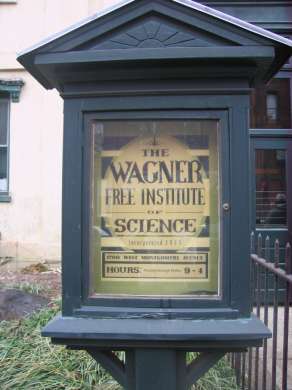
|
| Wagner Institute Logo |
William Wagner emigrated to Philadelphia as a prosperous merchant shortly after the nation was formed, becoming a friend affiliated in business with Stephen Girard, although never a partner. Business took him around the world, where he pursued his hobby of collecting scientific specimens. The collection grew until it needed a museum to house it, accordingly built on the family farm somewhat north of the city limits, now 1700 Montgomery Street. A woodprint shows a game of baseball in play in the fields, with the museum recognizably looming in the background. Those fields are now filled with Nineteenth century red brick Philadelphia rowhouses, built later to support the activities of the Museum. Unfortunately, a need for a parking lot was not anticipated in 1848, but the place is quite safe to visit because land directly across 17th Street, also part of the original Wagner farm, was given over to the 22nd District police station. It's even possible the parking issue has since been considered since nearby land was deeded to a Unitarian Church on condition of reverting to the museum if it stops being a church.
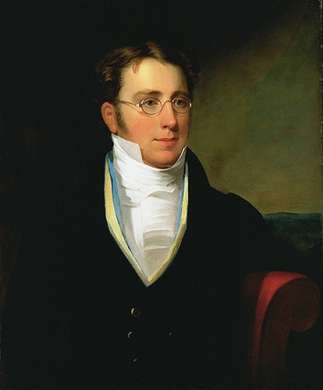
|
| William Wagner |
William Wagner became the first director of his museum, following the ideas of his friend Girard a few blocks to the south. Stephen Girard had left his estate to the education of poor white orphan boys; Wagner extended the idea of offering free scientific education to the working public. The example ofBenjamin Franklin's discovery of the nature of electricity with only a second-grade education is a locally dramatic example of the important truth that science can be enjoyed and even skillfully performed without academic preparation or advanced degrees. Science in the early Nineteenth century evolved from Natural Philosophy to what we now call Natural Science, heavily weighted toward geology, botany and zoology with a strong dose of Charles Darwin. Today, those ideas are having a reawakening in the Green (Environmental) Movement, so perhaps a resurgence of interest really is about to appear. The museum might be called a historical record of Nineteenth-century science, although its lecture series are wider ranging and, of course, up to date. Reflecting the intended science education of the working public, many of the lectures are given in the evening and on weekends. Many are given in other locations, like the Free Library branches. The Wagner resembles the Barnes Museum in the sense that two museums once intended to illustrate educational innovations have come to overshadow the public's perception of the educational programs, whereas the cost of maintaining museums grew far faster than the income from endowments. It all resembles academia in general in getting progressively more expensive to provide for.
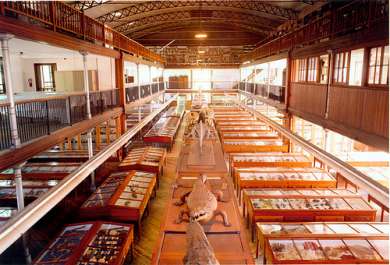
|
| The Wagner Museum |
The Wagner museum was formally opened in 1854, about the time of the City-County consolidation which relieved the population pressure needing to fill up surrounding fields with redbrick rowhouses, and eventually with Temple University. The formal Institute directorship was transferred to the professional management of Joseph P. Leidy, a dynamo of a man who received the informal title of The Last Man Who Knew Everything. When Leidy retired at the end of the Nineteenth century, the museum was closed to further acquisitions. For those who can remember natural science museums around 1930, the Wagner is strongly reminiscent, but over time it has become one of the few, perhaps the only, surviving example of the type. The building next door is a scientific library, available to scholars by appointment. The Athenaeum and the Mutter Museum are also surviving museum monuments, but even those two have been elaborately modernized. The Wagner resolutely adheres to looking as much like the original as maintenance will permit. The structure is as interesting as the contents; only the lecture topics move forward with the times.
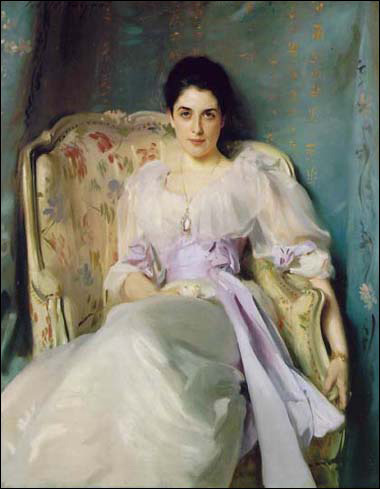
|
| Anna Karenina |
The Institute drifted away from the Wagner family, but a few Wagners of the present generation became attracted by the connection to their name, and have struggled to keep it alive. The board has a few Wagner family members, who do their best to spark the enthusiasm of others who value the lectures, the scientific educational movement, and historical quality of an expensive but unique museum in a difficult neighborhood. Quite a few loyalists throng around the evening lectures with a happy air of joint participation and tradition. It would be hard to overlook the sincerity and courtesy that hovers around the edges of a shared cultural belief. It's a family activity, all right, but it is no longer a Wagner family but a Wagner Museum family. Participants are unmistakeably really happy that visitors have come to see it. The opening lines of Tolstoy's Anna Karenina declare that all happy families are happy in the same way, but that's wrong. The Wagner Museum family are obviously happy but in a unique way. In a nation which so universally prizes the future, here's one group who have seen the merit of having some institutions grow in value by seeming to stay just the way they began.
Two Pacifists: Einstein and Eddington
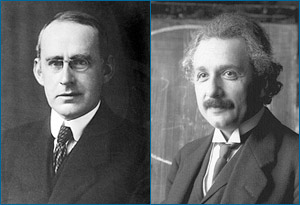
|
| Einstein and Eddington |
Very few claimed to understand what Einstein's Theory of Relativity was all about, but everyone could understand that giving a wartime Nobel Prize to a conscientious objector on the enemy side was political dynamite. It was not entirely a clear case; Einstein had indeed been a C.O. and was indeed the only member of the 94-person Prussian Academy to refuse to endorse the War. However, he had such a long history of taking the unpopular side of every argument that it was not certain whether he opposed the war or was merely sticking his thumb in the Kaiser's eye. At the same time, the most promising English astrophysicist, Arthur Eddington, was petitioning as a Quaker to be granted alternative service rather than be compelled to fight. Since Eddington was just about the only person claiming to understand and endorse Einstein's incomprehensible idea, it did not seem convenient to the British government to seem to endorse a German claim to enormous scientific achievement. It was decided to agree to Eddington's draft exemption on condition he conducts his own proposal for a definitive test of the theory. According to this idea, the light coming from a distant star should bend as it went past the sun. This proposal had the hidden advantage that a test could not take place until the 1919 eclipse of the sun, visible only from Africa or Brazil.
The experiment was hailed as a success, and a Nobel Prize followed shortly afterward, even though there were storm clouds over Brazil, and technical difficulties in Africa resulted in a rather blurred obscurity which would have baffled the public except for the enthusiastic acclaim of the only distinguished English scientist likely to understand the experiment. As telescopes have improved over the intervening century, it is now possible to observe the gravitational pull of much larger celestial bodies than the sun on a light which is coming to the earth from much more distant stars. Therefore, even schoolchildren can today see photographs of pinpoint starlight twisting into arcs of light while passing distant galaxies. Einstein the German has triumphed over Isaac Newton the Englishman, although the heady triumph probably did somewhat go to the heads of both Einstein and Eddington. Eddington the birthright Quaker allowed himself to be knighted, Einstein endorsed the dubious pacifist uprisings in Palestine, Eddington made a career of explaining puzzling scientific theories to the appreciative public. The direction of all this became clearer as some of the new theories Eddington promoted were discredited, and Einstein's pacifism has certainly become clouded by later thermonuclear events which he had a large hand in promoting.
Of the two, Einstein has proved to be the greater scientist, but Eddington would have been a scientific luminary without any association with the German, perhaps even a greater one without inevitable comparison between the two. Einstein spent the last 23 years of his life on the fringes of Philadelphia, at Princeton, but Philadelphia had little consciousness of his presence.
There She Goes, Miss America
Atlantic City has long been a summer resort, crowded with people on the boardwalk by the sea. But families suddenly disappear at Labor Day, when the kids go back to school. So, in 1921 the merchant community hit on an idea to extend the busy season an extra week, by having a big beauty contest on the week following Labor Day. The early Miss America contest struggled for a year or two and then became an established annual national ritual. The hotels and boardwalk did indeed stay crowded for an extra week, during which a publicity campaign was conducted to build up anticipation for the big Saturday night event. The preliminaries included interviews and mini contests, for the bathing suit division, the evening gown division, arguments about official state representation, occasional scandalous behavior, parades in open convertible cars, and whatnot and whatnot. Behind the scenes, there were little local battles, including a grim determination not to have a negro girl represent a state from the old Confederacy. Since only one Jewish girl ever won the contest in eighty years, there were probably other issues in other states, hidden behind the curtains. Smoking and drinking were prohibited but scarcely non-existent, as was getting married or pregnant; much of the fuss about these lesser moral issues was probably intended to cloak the event with the high moral tone, counteracting some unfortunate early beginnings of the pageant, and the exciting laxity traditionally associated with summer resorts by the ocean. But they aimed at and succeeded in attracting, a certain kind of audience.
For months before the pageant by the sea, preliminary contests were held throughout various states to select the local Queen, Miss Arizona, Miss Mississippi, Miss Delaware and so on. The people involved in these local contests duly trooped to Atlantic City to see the big event and cheer their candidate. Over time, it became clear that some states worked really hard on this effort; Mississippi was a notorious big spender, and a consistent big winner, but others were almost as determined to win. The grassroots campaign was largely centered on small-town high schools, but the effort was conducted by a great many local women, mostly middle-aged and often quite homely, who somehow got control of local beauty politics and ran the local contests. Over the years, two of these groupies had been nurses who worked in hospitals where I was a consultant, and I got to watch their enthusiasm bubbling under the surface. One woman had worked for years as a night nurse. The sort of person who sleeps all day and works all night tends to be a little odd, often slightly hostile. But when I asked this ancient battle-ax every year about the contest, she immediately blossomed and went on for half an hour about the gossip surrounding this year's contestants and winner. There was something about all this which was like the fantasies of playing with dolls, fulfilling unfulfilled dreams. If you pause to think about it, that enormous convention hall in Atlantic City wasn't filled with school kids after Labor Day; the school kids were back at school. Although the publicity was all about kids and giggles, the real fans were dreaming of days long past, perhaps as former beauties, more often only wannabes, their dreaming only intensified by knowing for a certainty that this success would never be theirs.
It was this self-delusion quality which the promoters of the contest never seemed to get through their heads; after all, the pageant was created and promoted by local merchants who mostly aimed to sell salt-water taffy to the rubes. Radio, and then television, gave the Miss America contest a big publicity push, and then eventually used up its material. When the casino crowd moved into A.C., the non-gambling ladies playing with dolls quickly demonstrated they didn't gamble, in fact, would sass the serious gamblers for their idiotic behavior losing money as fast as they could. TV ratings, contest attendance, and publicity began to fall off rather seriously. The idea was tried that perhaps women now wanted careers, so "points" were awarded for talent shows, musical performances, and brief contests about current events. Foo. That's not what the audiences wanted. So the contest moved to Las Vegas, and the date was shifted to January, a slow time for casinos. The awards were shifted from national tours and opportunities for screen tests to the awarding of college scholarships. Unfortunately, most of the contestants were already in college or married, and the scholarships were in fact mostly used to pay off trailing debts from colleges already attended.
So Miss America, now regularly a black woman but seldom a Jewish one, continue to be fodder for the sponsors and promoters of the pageant. But wherever it goes and whatever its modifications, the Miss America contest is never going to return to former glory until it learns who its real audience is. The lonesome, middle aged lady who dreams of playing dolls with live dolls.
And then, Miss America went away. Some other city has her. Atlantic City lost her. And there she goes, Miss America.
Sugarloaf

|
| Germantown Map |
Germantown Avenue goes continuously uphill from its start at the Philadelphia waterfront until it reaches Sugarloaf in Chestnut Hill. It follows an old Indian Trail, and that's where the Indians apparently wanted to go. From Sugarloaf northward, it's all downhill.
The name derives from the shape of the hill at that point and is a fanciful description of the sudden shift from Wissahickon gorge to the Whitemarsh Valley, which occurs at that point. The underlying rock changes from hard "gneiss" to limestone. In early times, this was the location of the farm of William D.Stroud, whose son was Teddy Roosevelt's doctor and the first one to introduce the electrocardiogram to this country. Around 1928, James Page built an imposing mansion with a wrap-around porch at the top of the 40-acre estate, naming it Wycliffe. Around twenty years later, the real estate magnate Albert M. Greenfield acquired the property, which eventually was given to Temple University as a conference center, although a fire destroyed the wrap-around building. That's Sugarloaf, and you can visit it.
Two stories about Greenfield, himself, still circulate around town. The first concerns a banker who met Greenfield at the corner of 15th and Walnut Streets.
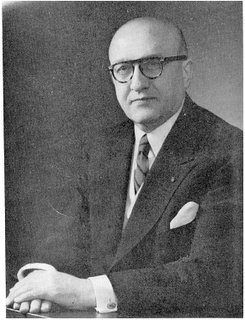
|
| Albert Greenfield |
The real estate man was looking up at the massive old Drexel building, where Anthony Drexel and J.P.Morgan were partners, and where Edward T. Stotesbury made lots of waves during the 1920s. Stotesbury acquired a personal wealth of about $100 million as "the richest Morgan partner" and was determined to spend every penny of it before he died in 1938. The stories of the extravagance of this birthright Quaker, and particularly his wife, are legendary. Anyway, Stotesbury held court at a big desk, just inside the door at 15th and Walnut. Greenfield was standing outside that door, chatting with his banker friend.
"Do you remember that big desk where Stotesbury used to sit?" Yes. "Well, I used to sell newspapers at the corner here and watched Stotesbury go in and out. I want you to know I just bought that building, myself, and I'm going to put my desk right where Stotesbury used to sit."
Unfortunately, he never did. Within two months, he was dead of pancreatic cancer.
The other story was told of Greenfield's integrity, the sort of thing that was central to the long-standing success of Philadelphia businessmen in commerce and banking. When bargains are stuck in a conversation, the deal is sealed with a handshake, and you better be as good as your word.
Hubert Horan, the Chairman of the Broad Street Trust, was interested in a piece of property, and over lunch agreed to pay Greenfield three million dollars for it. Before any papers were signed, another man came rushing into Greenfield's office and excitedly announced he wanted to buy the property. "I'm sorry," said Greenfield, "I just sold it to Hubert Horan". How much? "He agreed to pay three million for it." Did you sign anything? "No." Fine, I'm willing to pay you FOUR million for it."
"Well," said Greenfield, "I suggest you go see Hubert Horan. He owns it."
Preppies of the Future?
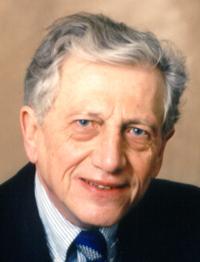
|
| Sir Peter Hall |
Modern western civilization had its origin, or revival if you prefer, in the Italian town of Florence six or seven hundred years ago. The rise and fall of Florence makes a case example for the two preeminent scholars of civilizations, Peter Hall and Arnold Toynbee. Both of them, for obvious reasons, are British. Toynbee intones the theme that civilizations destroy themselves by overextending their best features. Peter Hall makes that into less of a one-way street. Civilizations flourish in the first place because of competitive tension between two conflicting aspirations; eventual victory by either one starts success on a path of unrestrained decline. In slightly different ways, both of them predict that success leads to failure. Not that failure inevitably follows success, but those notable failures are usually caused by success.

|
| Florence |
Florentine civilization grew out of the interaction, conflict, and intermarriage, of pugnacious aristocrats with sly calculating merchants. For a time, an optimum balance was achieved, and Florence dominated the Western world. Centuries later, much the same thing happened to England as feudalism grappled, first with Elizabethan maritime buccaneering and subsequently with the Industrial Revolution. That's where Eton comes in.
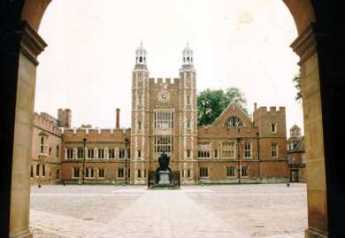
|
| Eton |
For American purposes, it is enough to focus on two Etonian mottos. Lumping both reckless aristocrats and scheming merchant princes, Eton exists "to exert a civilizing influence upon those who are destined to rule." Eton expresses no pretense about diversity or talent; Eton is not a trade school, a place to make useful contacts, or an elevator for upward social mobility. Labor governments, of course, do not share such attitudes, enduringly defended by Wellington's proclamation, that "The battle of Waterloo was won on the playing fields of Eton." That school aspires to teach more than Latin or trigonometry; it teaches duty and courage. And, as needed, it works. The graduate of a similar school Winston Churchill, reminding the nation that never have so many owed so much to so few, was delivering a subliminal illustration that leadership grows from education in many different ways.
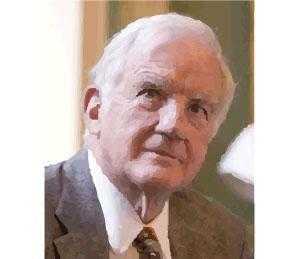
|
| Derek Bok |
So things had not changed much in several hundred years, from Florence to Eton. It became accepted that a nation needs leaders who are smart (no charges of Light Brigades, please), it also needs unflinching bravery, in various combinations at different moments. And then, a research institute very near Lawrenceville, New Jersey, and two Harvard presidents, Conant and Bok, added a new requirement just before the Second World War. By devising multiple choice tests whose results seemed to parallel later academic success in college,
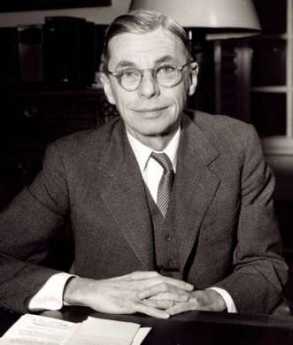
|
| Conant |
it became possible to identify myriads of ordinary American children who seemed to have equal or greater potential than the children of wealth and success. If the leadership pool needs to be enlarged, that's where new entrants should come from. Besides, examples have always abounded of the children of famous people who, even with an outstanding education, bitterly disappointed their expectations. Perhaps, by the application of scientific testing combined with judicious financial aid, it might be possible to civilize the unmentionable social Darwinism long visible in competitive concentrations of hormonally active youth. Without being too obvious about it, perhaps we could create a race of supermen by placing genetically superior candidates of both sexes together, train them well, and let propinquity do the rest. As this tacit system has evolved over nearly a century, the inbreeding has come to depend less on the hidden factors which encouraged success in the parents, and more on whatever genetic skills are linked to adolescent success in multiple-choice examinations. And the expansion of this idea into the unused talents of girls is genetically thwarted by the tendency of professional women to have fewer children by delaying the birth of the first child; a sort of reverse Darwinism induced by prizing professional talents over reproductive ones.
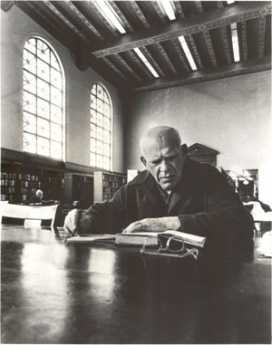
|
| Eric Hoffer |
The American pragmatic way, and the scientific method, both attempt to make decisions by seeing what works. Eric Hoffer, the San Francisco writer, once visited Lawrenceville and pointed out one thing that definitely works. Rich men, he said, marry beautiful women. And so, their children tend to be unusually handsome. It's a circular system that is undeniably at work. Without any conscious scheming by sociologists, an unnerving pragmatism is already at work getting more of whatever it is we need, into leadership positions. Unfortunately, this fiendishly clever system for influencing the genetic choices of promising candidates cannot unequivocally claim to produce long-term success. Like the British royal family, it seems to some the proportion of failed marriages is too high in our system, the incidence of recreational drugs and alcohol is too great, and the number of graceful drifters too numerous among the alumni. Perhaps that is only invidious opinion, based on contrasting unusual opportunities with the ultimate consequences for a fundamentally normal collection of people. Perhaps, if we were truly objective, we might discern a second-generation production of Nobel Prize winners, Senators, Presidents, Olympic champions that might well justify the opportunities bestowed on the bloodlines. What Lawrenceville may need, to defend itself, is a systematic longitudinal study of outcomes that would demonstrate, let us say to Princeton, that more of our graduates are entitled to admission there. Or, maybe, that's the wrong goal entirely. Perhaps graduates of Lawrenceville, Andover and Exeter don't need Yale, Harvard and Princeton . Perhaps they need a different sort of college. Maybe they should skip college entirely, and go on to graduate schools. Instead of being preparatory schools, perhaps they should be finishing schools. There was a time when rich men married beautiful women; the time is coming when beautiful women seek out nerds to marry. Society has not charged academia with a duty to promote such an outcome, once suggested by Bernard Shaw to the beautiful chorus girl. "What if we produced children with my looks and your intellect?"
Or, perhaps a longitudinal study would show something even more important, best perceived by ones who passed through the system before there was a SAT. Perhaps the basic premises of the SAT score need to be confronted, along with the cerebral ideals of Presidents Bok and Conant. Perhaps, beyond a certain point, higher SAT scores just lead to more schizophrenia and depression, or other counter-productive outcomes of inbreeding. Perhaps we should have another look at J. P. Morgan's system for identifying leaders. That old walrus-nose swept schoolishness away. "Brains don't make you rich," he snorted. "Character does."
REFERENCES
| A Study of History Arnold J. Toynbee ISBN-13: 978-0195050806 | Amazon |
| Cities in Civilization: Peter Hall: ISBN-13: 978-0394587325 | Amazon |
| Why the Private School?: Allan V. Heely: ASIN: B000GR1QS2 | Amazon |
David F. Bradford, 1939-2005
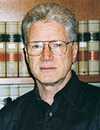
|
| David Bradford |
We should take the word of his friend and colleague, Daniel Schaviro, that the core of David Bradford's professional career as an economist was his conviction that a very deep wrong existed when two people could earn exactly the same income over their lifetimes but the one who spent every cent immediately would pay less in taxes than the other who carefully saved for his retirement and heirs. Bradford was offended by this message our society was broadcasting.
Working for a time in the U.S. Treasury Department and later as a member of the President's Council of Economic Advisor's, he was able to explore the mechanical workings of tax law well enough to translate moral conviction into a workable proposal for political reform. In 1977 he published "Blueprints for Tax Reform", introducing these practical ideas at the highest level of academic rigor. The impact of his ideas in this paper extended through three presidencies, particularly the present one.
Bradford saw the tax injustice which penalized the Protestant ethic could be corrected in two ways. Either the tax code could shelter individual savings from taxes until they are spent (the IRA), or else convert the income tax into a consumption tax (like VAT). In either case, taxation would take place at the same time as consumption, rather than at the time of earning. Notice the person who saves money to spend later will suffer from both inflation and taxes on taxes on the inflation "gains". The political choice between the two proposed solutions was made by Senator William Roth (R, DE) who sponsored the Individual Retirement Account (IRA) and shepherded it through an intensely political Congress. His was a wise decision, since its voluntary nature made it attractive to politicians, while the French experience with a mandatory Value Added Tax (VAT) created political opportunities to favor certain industries, which politicians were quick to understand.
After twenty-five initially slow years, the eventual popularity of the IRA has now encouraged its extension to Social Security. That's what agitates domestic policy debate at the time of David Bradford's unfortunate death. The IRA model is also the basic concept underlying Health Savings Accounts (HRA), which struggled for many years but have reached their own period of growing acceptance. The Blueprints idea has thus dominated domestic politics for nearly three decades, while its originator remained largely unknown. Far from being a sign of weakness of the idea, it is a proof of the revolutionary nature of this simple concept that it initially provokes public resistance, but also inspires relentless tenacity among those who have taken up its challenge.
David Bradford returned to Princeton from his Washington experience, resting for decades at the quiet center of an Economics department that is not known for its quietude. After a most unfortunate fire at his home, he died of the burns in nearby Philadelphia, which hardly knew him.
Hayek Confronts Keynes

|
| The Four Horseman |
Catastrophes seem to have fashions. There was a time when the four horsemen of the apocholypse -- pestilence, war, famine, and death -- rounded up the main things to keep you awake with worry. Perhaps it is too soon to gloat, but pestilence and famine seem tamed, even ready to be "put down". War remains a serious cause for concern, but a case can be made that two economic disasters, inflation, and recession, have moved up to dominate our nightmares. Indeed, it is the Summer of Love in 1967 which seems to mark the watershed moment, when basic survival stopped being the main risk in life, supplanted by threats to existence that are largely self-inflicted. The first warning of this sea-change appeared in the fall of 1929 when it seemed to be deflation, unemployment and all the other havoc of economic recession that caused wars, famines, and pestilences. The 1929 crash did not send a fully readable message, however, because it was so one-sided. It took another 37 years for the world generally to appreciate there was an opposite side to it; inflation was just as bad as recession, and both problems were largely man-made. One person gets most of the blame for the distorted emphasis. John Maynard Keynes, later Lord Keynes, was the prophet who seemed to save the world with the doctrine that the deflation emergency was so dire that civilization could not afford to worry about the long-term drawbacks of deliberate inflation. He persuaded world leaders to inflate the currency before civilization disappeared. After all, in the long run, we are all dead.
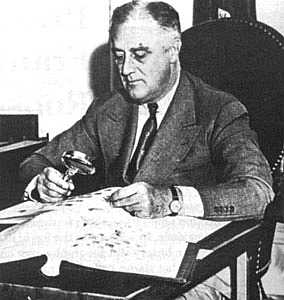
|
| Roosevelt Stamps |
There's an irony that Franklin Roosevelt was a hobbyist who collected postage stamps because stamp collectors were about the only Americans who were dimly aware that Germany and Austria had hyper-inflation as the main curse. Austrian postage for billions of marks gradually filtered into our collections of odd foreign stamps, arousing mild international curiosity. But Friedrich August von Hayek was living in the midst of it, painfully aware of its pain and chaos. It became the central focus of the life of an aristocratic decorated war veteran who became a distinguished economist, eventually winning a Nobel Prize. What caused inflation? Why didn't it stop? Why was it so destructive? How can inflation be prevented? How could Maynard Keynes possibly urge the leaders of nations to inflate their currency deliberately?
As a scholar in the dismal days of world depression, Hayek had a hard time, living for long periods on the charity of a few philanthropists who recognized his talents. He is best known for his scorching analysis of collectivism, a craze which swept through academic and political leadership, particularly in Europe, and his persuasive views probably constitute the main intellectual force which ultimately ended the Cold War. It is seriously stated that personal animosity by Socialist-leaning academics materially injured his academic career, although it probably gave him more time, and motive, for serious writing. Inflation and political collectivism do not seem tightly connected, but it is easy to observe that command economies do inevitably clash with private property and market decisions. For the present, it seems useful to set aside Hayek's monumental political achievement of discrediting Communism and focus on his penetrating view of inflation.
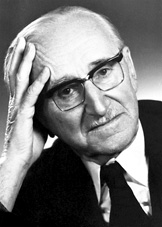
|
| August von Hayek |
You can almost watch his mind at work. If you give long hard consideration to the topic of inflation, you have to conclude that there seems no reason for it to be a bad thing. It may take a little time, but the price of everything will eventually readjust to a new higher level, and relationships will go on undisturbed. At first glance,
You can almost watch his mind at work. If you give long hard consideration to the topic of inflation, you have to conclude that there seems no reason for it to be a bad thing. It may take a little time, but the price of everything will eventually readjust to a new higher level, and relationships will go on undisturbed. At first glance,
inflation is just a harmless numbers game. You can understand the power of inflation; everybody likes a little of it for his own personal benefit. If everybody enjoys a little of it in his own sphere, then the whole world is pushed to a higher numerical level.
After long consideration, Hayek came to see that the disruptions of inflation are caused by the uneven speed of penetration throughout an economy or nation. If the price of oil goes up, the price of transportation goes up, then the price of home heating. But those who take the train or who heat their homes with coal are not affected so soon. Mortgages carry a fixed interest rate for thirty years until the unwisdom of such agreements becomes clear, but it takes time. The process of inflation creates winners and losers, and disruption in the culture of payments. The speed of payment is itself a factor in the virtual size of the monetary pool. In the long run, we're all dead and it all settles out unless we set in motion a universal scramble to get out the door before others get there. Inflation is just as much evil as collectivism, and somehow the two are usually seen together. The Road to Serfdom sits on the shelf, right next to The Austrian Theory of the Trade Cycle, and Other Essays .
Bertrand Russell Disturbs the Barnes Foundation Neighbors
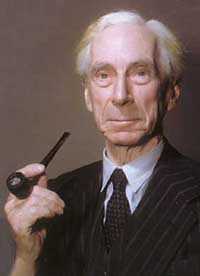
|
| Russell |
In 1940, the Barnes Foundation disturbed its Philadelphia's Main Line neighborhood in a way that had nothing to do with art. Dr. Barnes was still alive and running the place at that time so there can be no question about the testamentary intentions of the donor. He hired Bertrand Russell for a five-year contract to teach philosophy at the Foundation, under highly lurid circumstances. By doing so, he put his thumb in the eye of religions generally but especially the Roman Catholic Church, into the eye of the Main Line neighborhood that prized its privacy, and into the eye of the judiciary, although the judiciary found a way to get back at him.
 Do not fear to be eccentric in opinion, for every opinion now accepted was once eccentric. 
|
| Bertrand Russell |
Under the circumstances, hiring anyone at all would have been socially defiant, but Barnes went out of his way to offer a position to a man who was already internationally famous for sticking his own thumb in everybody's eye.
Lord Bertrand Russell was the third Earl, the son of a Viscount and the grandson of a British prime minister. He had such a brilliant mathematical mind that no less an observer than Alfred North Whitehead regarded him as the smartest man he ever met. He burned up the academic track at Trinity College, Cambridge, and was made a Fellow of the Royal Society at an early age. There was absolutely no one in the academic world who could look down on him, particularly no one in any American community college. His association with Haverford Quakers was established by marrying Alys Pearsall Smith, a rich thee-and-thou Quakeress then living in England, whose brother was the famous author Logan Pearsall Smith. Many early letters of Bertrand Russell contain instances of what the Quakers call "plain" speech.
 If a man is offered a fact which goes against his instincts, he will scrutinize it closely, and unless the evidence is overwhelming, he will refuse to believe it. If, on the other hand, he is offered something which affords a reason for acting in accordance to his instincts, he will accept it even on the slightest evidence. 
|
| Bertrand Russell |
By the time of World War I, this odd mixture of Quaker pacifism and English aristocratic arrogance seems to have unhinged Russell from social moorings, and he began a lifelong career of defiance mixed with a rapier wit that made just about everybody his enemy. He went to jail for pacifism, got divorced three or four times, openly slept with the wives of famous people like T.S. Eliot, and proclaimed that monogamy was not a natural state for anybody. He wrote ninety books, and his denunciation of religion was sweeping. All religious ideas were, in his view, not only false but harmful. Accordingly, everybody in polite society kicked him out, and although he was entitled to a seat in the House of Lords, by 1939 he was nearly impoverished. In desperation, he went to (ugh) America to seek his fortune. He didn't last at the University of Chicago, and even California eased him out. Finally, he was reduced, if you can imagine, to accepting an offer to teach Philosophy at the City College of New York. That proved to be totally unacceptable to Bishop Manning, who led a public outcry against using public funds to support such a radical, known to have held long conversations with Lenin. When a CCNY student was induced to file suit along those lines, an especially hard-nosed judge overturned the College appointment, with the rather gratuitous declaration that Russell's appointment would establish a Chair of Indecency. At that point, Albert Barnes stepped in and offered Russell a five-year contract to teach philosophy at the Barnes Foundation on Philadelphia's main line.
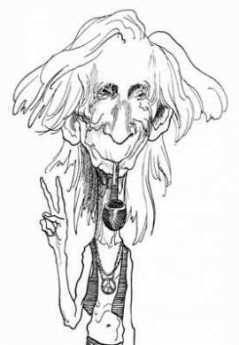
|
| Bertrand Russell in 1960s regalia. |
Bertrand Russell the bomb-thrower accepted the offer and came down to that quiet little lane where the neighbors object to the traffic coming to look at pictures. The five-year contract only lasted three years, when even Barnes got fed up, and summarily dismissed him. The circumstances have not been extensively documented, but they were sufficient to enable Russell to win a lawsuit for a redress of grievances. During that three year period on the Main Line, he had produced a book called History of Western Philosophy, which became a best seller and permanently relieved his financial difficulties, and was the basis for his winning the Nobel Prize in Literature. He spent the rest of his ninety-odd years leading demonstrations against the atom bomb, the Vietnam War, monogamy, religion and so on. There are those who regard Bertrand Russell as the role model for the whole Sixties generation, and, unfairly, the 2004 Democrat candidate for President. However, all that may be, his activity at the Barnes Foundation undoubtedly was a factor in the firm but the unspoken tradition of the Merion Township neighbors that they wanted to get that Art Gallery out of here.
Yale Blue
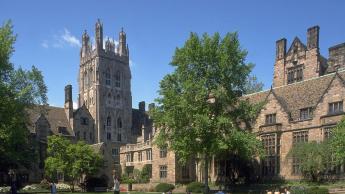
|
| Yale |
When a college applicant recently asked me what was so good about Yale, the question was so unexpected it took a moment to find a graceful answer. What finally occurred to me was the battle cry of New Orleans, before Hurricane Katrina. "It is impossible to find a bad meal in New Orleans." In culinary matters, New Orleans had a deep bench; with everybody in the city interested in good cooking, even the most dilapidated diner would serve you something rather good.
Well, in 1940 at least, it was impossible to take a course in Yale College that wasn't stimulating, taught by a distinguished professor who was charming and likable. At one point, I wandered into a course in early 19th Century English Literature, taught by William DeVane, a courtly and urbane gentleman who happened to be Dean of Yale College. Yale College refers to those who are seeking a B.A. degree; those taking a B.S. degree are said to be part of the Sheffield Scientific School; a few others were going to be engineers. In retrospect, I suppose Bill DeVane was just having fun teaching a course, possibly satisfying himself that Yale College was still working the way he wanted it to. In any event, I certainly didn't take that course because I cared who was Dean, or who DeVane was. I just thought it would be interesting to take a course in Jane Austen, Charles Dickens and some other early Victorian novelists. I'm glad I took that course, but I would have been just as glad if the topic had been the history of the Civil War, or a dozen other things. Except then I would have missed the experience of being close to DeVane, whom I now imagine was the architect of modern Yale College. The essence of this is that a Yale College student could select a course in any subject that caught his fancy and be confident it would be first-rate. Essentially invisible to me at the time was the absence of certain courses for the main reason there was no one outstanding who was available to teach that subject. If some topic was so central that a course just had to be taught, Shakespeare for example, I suspect the Dean or the President would have found money no obstacle to getting someone outstanding to teach it. Meanwhile, as long as you wandered around inside the printed course catalog, you would need no particular guidance. The faculty obviously enjoyed the students, quite often coming to lunch at student tables in the various residential colleges. For example, William Lyon "Billy" Phelps usually arrived early, and Branford students would fight to sit at his table. At least in those days, the students liked the faculty, and the faculty liked to be with the students.
That sounds like quite a contrast with what is rumored at other colleges today, although it's hard to be sure of comparisons across several decades. Perhaps it was the student rebellions of the sixties, long hair, a fashion of crude speech, and all the other features of the social revolution that started during the summer of love. Perhaps it was the demographic bulge with attendant overcrowding of campus and classroom. And perhaps it was never as idyllic as I remember; my classmate Bill Buckley certainly believed we were at the mercy of godless secularism marching in academic lockstep, although I don't remember anyone else agreeing with him. Today, so many people agree with Buckley's viewpoint that it's hard to assess. But there is little dispute that graduate students never taught undergraduate courses in my day, any lecture that I remember had more than fifty students in the class, no one would have been admitted to class without a tie and jacket, everyone addressed the faculty as "Sir". No one went to Europe in Junior Year, so there was no suspicion that extra tuition for decreased teaching was an administrative goal. Even if there had been a Junior Year Abroad, I wouldn't have taken it because there were so many neat courses in New Haven that seemed more attractive. There were no illicit drugs to worry about, and girls only arrived on the train for special occasions. Yes, there were some beer-drinking playboys, but it was plain to see they would soon flunk out.
Advanced Placement Gains Attackers and Defenders
An abridged extract of what

|
| Naomi Riley |
Naomi Schaefer Riley writes in the October 6, 2006 Wall Street Journal, follows:
"... The rat race complaint is that AP courses put a strain on students-too many facts to memorize, too much reading. And teachers complain, too. They say that AP courses force them to teach to test.. .
"Conceived in the early 1950's by educators from three prep schools (Andover, Exeter, Lawrenceville) and three universities (Harvard, Princeton, Yale),
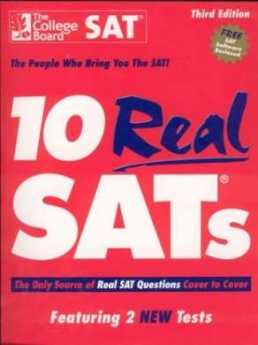
|
| SAT's |
the AP curricula demand that students acquire real knowledge. Unlike the SAT's which measure mental aptitude, the AP tests ask students hard questions on the history exam require students to place quotations and documents in their correct context and to identify events, dates, historical figures, and ideas....
"Why? Because college increasingly offers a crazed social experience at the expense of rigorous study. But high school does better: It is often the last time that students are forced to learn something...."
Ms. Riley goes on to imply that colleges have deteriorated into little more than binge drinking hide-outs. Since I am 62 years away from personal observation of the college scene, I can't comment or even know for certain whether things have changed much in this respect.
But on the topic of resistance to Advanced Placement, Ms. Riley explains enough to justify comment. The SAT revolution, which took place at the same time and much the same place, effectively converts the old college entrance based on genetic probabilities into the new college entrance based on mental aptitude. Since raw mental aptitude seems to be in oversupply, the final decisions are winnowed by extra-curricular success. It would appear to me that the extra-curricular success industry is threatened by proofs of academic achievement. And more importantly, since grade inflation has destroyed the value of high school transcripts, the AP courses serve as a surrogate for effective nerdiness and bookishness. In other words, the AP tests are a threat to the entitlements created by the SAT, one of which is grade inflation.
If grade inflation is under attack, that puts more pressure on high school teachers to teach, school districts to raise their salaries, and taxpayers to pay. Before that happens, there will be pressure to cut the cost of sports and other extracurricular expenses.

|
| Bill Gates |
And, come to think of it, if more nerds are admitted to prestige colleges, perhaps their social inadequacies will reduce college socializing that now appears to alarm, Ms. Riley. For proof of that trade-off, I enclose a photograph of some overachievers of 1978, two of whom dropped out of Harvard because it was unchallenging. Mr. Gates is lower left, Mr. Allen lower right.
Unintended Consequences for Advanced Placement
The Nov. 23, 2004 Wall Street Journal writes that "Elite High Schools Drop AP (Advanced Placement) Courses," thus taking me back to 1943, when I guess I started the idea now being dropped.
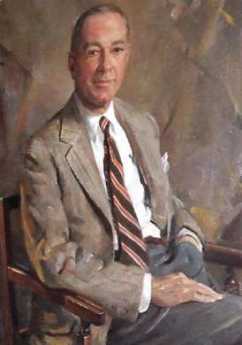
|
| Allan Heely |
The then Head Master of The Lawrenceville School, Allan V. Heely, came around to Yale to visit recent graduates in their college freshman year. For secondary school principals that would, in itself, be quite a novelty today. We certainly considered it a novelty to have him actually buy us a beer, since six months earlier we would have been instantly dismissed from school without hope of appeal, just for one provable beer. The alcohol issue to one side, I can see in retrospect that the Head Master made a serious effort to socialize with his senior students, inviting them to tea every afternoon, and coffee after Sunday chapel. What might sound like quaint Victorian ceremonies to an outsider were in fact conscious efforts to create a role model of the mythical Renaissance Man. He and the school chaplain played piano duets and sang witty songs of their own composition. He brought in famous guests from New York and Philadelphia and made them perform as conversationalists. Jacques Barzun and John Erskine were memorable examples. I can even see in retrospect he was displaying his elegant talented wife as an example of the sort of woman we were urged to marry. To visit his graduates in their early formative years in college was entirely in keeping with his concept of education as the basis for character development. There was even a quote from J. P. Morgan: "Brains don't make success, character does."
Well, for all his effort to be friendly, when the Head Master visits you at college it's a little hard to know what to talk about. So, to be helpful, I pointed out that the science courses were not smoothly integrated between secondary school and college. An example was the contrast between my roommate (Peter Max Schultheiss, now Professor Emeritus of Electrical Engineering at Yale) and me. Pete had scored 100 -- no mistakes on any quiz, all year -- in both Chemistry and Physics, whereas I had not taken either course at Lawrenceville at all. Yet, here were both of us in the same Freshman introductory courses at Yale, required before more advanced courses could be taken. Naturally, Pete had an easier time of it, but at the end of the year we were at the same point, and we both felt he had wasted his time taking the same courses twice. Why couldn't Lawrenceville make an arrangement with Yale to waive the requirement for some introductory courses, saving educational time for something else?
Mr. Heely did a lot better than that. At that time, ninety seniors from Lawrenceville went to Princeton every year, a hundred seniors from Andover went to Yale, and about the same number went from Exeter to Harvard. A pleasant dinner was arranged for the three headmasters and the three University presidents, at the conclusion of which the deal was done. Advanced placement was put into effect. As I understand it, the AP system gradually spread, and last year 14,900 secondary schools offered Advanced Placement courses. You could play around with those numbers and conjecture several million college person-years of education were put to better purposes over the last 62 years. It's a really nice feeling to believe that one twenty minute conversation by two eighteen-year-old boys could have such a useful effect.
So, now what's the problem with these elite high schools, that want to drop AP courses? It's hard to speak on their behalf, but I'm in a unique position to know the original idea has twisted out of shape a little. The original purpose was to eliminate mandatory repetition of introductory college courses, but nowadays competition for admission is so ferocious that repetition is considered a very smart thing, to beat the system. It works up and down the educational system, awarding a high score for coasting through a course the second time. Advance placement thus becomes a bribe not to do that, and the power of the bribe is prestige for admission to some higher level. With 15,000 high schools (like Garrison Keillor's Lake Wobegon) claiming to provide superiority, there has to be accreditation, and for that, there has to be a standardized test. Before long, the curriculum is dominated, not by what the teacher thinks is superior, but by what is likely to be on the accreditation test. In effect, we get a French-like system in which the bureaucracy dictates what is best for the Leaders of Tomorrow. That's quite different from the time when outstanding secondary schools produced an unusually good product, and colleges were asked to recognize it. It's hard to say who's been corrupted here; probably everybody, because it's mass-produced accreditation. If you want to evaluate whether to permit more or fewer waivers for a certain school, you need to evaluate earlier waivees when they reach Junior or Senior level in whatever college had previously done some waiving. Only at that longitudinal point in the process is it possible to conclude whether the waiving of repetitious introductory courses had been useful or harmful.
Underneath all of this is the self-fulfilling prophesy that graduation from a handful of elite colleges will assuredly lead to success in life. If what we need are leaders who are vicious competitors, practiced in circumventing hurdles on the way to getting to the top, credentialism is perhaps a regrettable necessity. But if, as Mr. Morgan said, it's character that matters, gaming the system is not a completely ideal way to promote it.
Charitable Immunity: An Underestimated Revolution

|
| Percent |
Until 1939, there was a legal doctrine of Charitable Immunity, which universally shielded hospitals and other charitable institutions from negligence lawsuits. No doubt the underlying reasoning was that charities possess limited funds for unlimited demands, and must be forgiven for imperfect compromises in the face of scarcity. To threaten them in court for falling short of perfection might drive charitable efforts away entirely. Since many professionals donated their services to the common effort, there was some spill-over protection for individual professionals, but this centuries-old doctrine applied to institutions more than individuals. There can be little doubt that improved financing of hospitals by health insurance and government programs resulted in both higher standards and lessened public tolerance for imperfection. One might say that twentieth century America decided it could afford better care, supplied the money for it, and expected to see results. It might also be commented that Medicare and Medicaid were significantly overfunded at first, but with time have become painfully underfunded, particularly by Medicaid.
The New Hampshire Supreme Court, against all prevailing doctrine of the time, held in 1939 that hospitals in that state should no longer be broadly shielded from liability by the doctrine of charitable immunity. By 1991, this new legal view had extended to the point where the Pennsylvania Supreme Court felt a need to define Corporate Negligence, emphasizing a hospital's duty to ensure a patient's safety while in the hospital. The court specified the duty to provide safe facilities, to select and retain only competent physicians, to oversee all persons who practice medicine within the walls, and to formulate and enforce adequate rules of behavior. Looking back, legal scholars point to two particularly significant intervening court decisions. In 1957, eight years before Medicare, the New York Court of Appeals declared that to say the doctor is the captain of the ship, acting on his own responsibility, no longer fits the facts. The court bore down hard on the existence of salaried physicians, and the illuminating fact that hospitals were openly sending out bills for medical services. In 1973, the Superior Court of Delaware deliberately and consciously extended the New York doctrine from salaried physicians to independent contractors working within the hospital. But independent contractors are still working for pay; the courts have been more hesitant to extend the idea of corporate control to volunteers who work without payment of any sort. But the movement is in that direction, so it is increasingly difficult to find anyone to volunteer. The American instinct to volunteer is still very great, as the response in 2005 to the South Asian tidal wave demonstrated, with relief agencies forced to send out appeals for the flood of volunteers please to stay home. But the central fact remains that the original premise was limited resources for unlimited needs; Medicare and Medicaid temporarily made it seem resources would be infinite, so why should an injured patient forgive a volunteer. As it becomes increasingly evident that the 1965 federal promises of infinite support are unsustainable, the invalidation of charitable immunity deserves to be re-examined.
The 1973 date of the Delaware decision is probably significant because that was a time of abandonment of malpractice coverage by insurance companies. If you couldn't sue doctors, and you feel you must sue somebody, plaintiffs were in effect told to sue the hospitals. With charitable immunity, hospitals didn't carry insurance, but they immediately searched for it. And thus, a bigger, far juicier deep pocket was created. Physician malpractice premiums, outside of California, were approximately $100 a year. Those rates proved to be far too low. The temporary collapse and disappearance of malpractice insurance companies took place in 1975. It is very hard to blame the actuaries of a malpractice company in say, California, for failing to take fully into account a decision by the Superior Court of Delaware in their premium-setting.
Before this revolutionary upheaval, a volunteer chief of medical staff was (nominally) in charge of every mistake made by any employee, and that was pretty unfair if he got sued. The captain of the ship idea devolved to department heads, or perhaps just the responsible surgeon in the operating room. If the scrub nurse counted sponges wrong and left one behind in the patient, the responsibility passed upward to one of these captains or sub captains. The manifest unfairness of demanding damages from someone six or more steps removed from the incident, particularly one who had a largely honorary title and no real control, exercised a restraint of sorts on lawsuits. Once the blame was shifted to a nebulous legal entity known as the corporation, blameless blame transformed into a corporate financial liability. The average size of awards against institutions escalated upward, raising the size of claims for similar injuries against individual physicians. Add to that the growing fact that hospital revenues are almost exclusively derived from insurance third parties, and thus the premiums for hospital insurance could only come from insurance as an automatic pass-through. Disaster looms if the intermediate parties have nothing to lose, and the public pays all the cost through health insurance or taxes. None of this adversary system, including the whole tort system and the whole malpractice insurance system, was designed to cope with a financially pain-free defense posture. One paradox of the situation is that the admirers of the plaintiff viewpoint are typically also sympathizers with universal health insurance. The two are utterly incompatible under any set of proposals, so far offered.
If matters had stopped at that point, well, it's only money. But obviously, the counter pressure on health insurers to hold down these costs was inevitable. Hospitals were practically under court order to make rules (the hospital associations would be happy to construct a model set of rules) and enforce them on their attending physicians, to pay professionals salaries wherever possible as a time-tested means of encouraging obedience, and to reorganize themselves as corporations practicing medicine rather than hotels providing space and services. (There are legal barriers, of course. Numerous state constitutions awkwardly state "No person may practice medicine in this state without a license so to do.") Needless to say, physicians resisted this trend toward the corporate practice of medicine, even though its early forms only took the shape of placing the hospital lawyer in charge of conferences about "risk" prevention. Since the lawyer knew very little about the topic, the discussion tends to focus on horror stories of suits that were lost or are in litigation.
This struggle between physicians and administrators for control of the hospital, using malpractice as a debating point, is bad enough. Far worse is the slanting of the system of actual medical organization of the staff. Hospitals now often have thousands of nurses and hundreds of doctors, each reporting upward within two guild structures. You would think the chief of surgery would have a lot to say about the selection of the nursing supervisor in the operating room, but heaven forbid. Nurses are hired and fired through the nursing hierarchy, not the department hierarchy which would cross guild lines. It's sometimes hard to say who is on which side of this issue, and probably everybody is on both sides, sufficient to paralyze rational discussion. Everybody involved wants to diffuse blame for an error through the whole organization, and so resists having responsibility conferred in any consistent way. The chief of surgery, for example, is ambivalent about whether he wants nursing errors legally passed back to him, and thus tends to retreat from asserting himself. It can sometimes be hard to specify the ways this chaos expresses itself in poor quality or higher costs, but it would certainly be remarkable if it didn't.
Main Line School Night
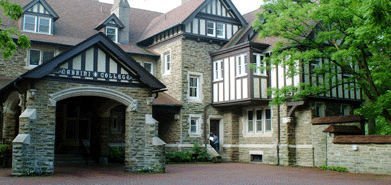
|
| Radnor |
There's a lot to learn from the Main Line School Night, and it isn't all taught in the classroom. The basic idea is life-long learning, going to school because it's fun. The idea started five or six decades ago in the Radnor, PA high school, that a lot of educated people wanted to become still more educated in topics of their own selection. No tests, please, and forget about academic credits; most of the students already have an excess of them. Forget about improving your income with advanced degrees; since this is Main Line Philadelphia, quite a few of the students already have all the income they could ever want. As related by the very low-key president of MLSN, David Hastings, the idea was an almost instant success. There were 1200 students enrolled for the second semester. They outgrew the original high school, and now teach courses in seven schools among 40 locations, to 14,000 students a year. There are 400 teachers in any given year, and the tuition charged is aimed at breaking even on the overhead. The academic world is inclined to say the courses lack rigor, by which is partly meant that if the students don't like the course, they walk out. Volleyball, yoga, and nutrition certainly do have a California sound, but computers, foreign languages, and science can be as difficult as you want to make them. If you get serious about contract bridge, you soon learn that isn't a simple child's game. Courses in wine tasting are given in the local senior citizens' retirement communities, but mostly not to the residents. It's not welcome to give that sort of course in a high school. To some extent, this continuing education is an exclusive social occasion, but then so is a course in diplomatic history at Princeton. Mr. Hastings tells of a group of sixteen ladies in a bridge course who have been coming for years, and have learned to close the course rolls by all sending in their checks on the day of registration. This is, after all, the Main Line where exclusionary techniques once learned are hard to forget. There are clouds on the horizon. In the past three years, enrollment has leveled off and declined a little. Almost no major corporation continues to be successful for more than seventy-five years, and many of the people running Main Line School Night are drawn from the Executive Service Corps. In retrospect, for example, the owners and editors of the Saturday Evening Post should have sold out and closed down, as soon as they learned the first million television sets had been sold. Perhaps the decline of enrollment of Main Line School Night reflects the advent of the Internet, or the cell phone, or some other new technological competitor. Or maybe the venture just got too big and successful to maintain its original format; perhaps it's outgrowing its blood supply. But anyway, they have 14,000 students and can be proud to be in a resting phase, when the rest of the city, or state, or country, hasn't even tried to get started on such a project.
A Woman's Work

|
| Feminism |
Whatever the gains and losses of the Industrial Revolution, reproductive need endures. Feminists who proclaim the advice to their sisters, "Have a baby; just don't have two." ignore some pretty simple arithmetic about population growth. What's perhaps worse, they fail to notice conflict with the goal of marrying rich. Rich men can afford a lot of things, but most of them can't afford a working wife. There's a fantasy in soap opera about meeting a fabulously rich man, one who owns motorboats and horses. How glamorous to be swept up by such a paragon; after all, every American hope to get rich.
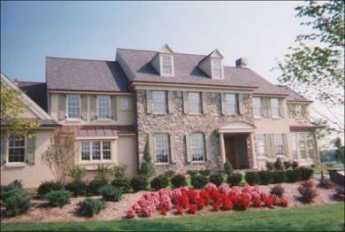
|
| Big House |
, In fact, it takes training to run a big house, organize big parties, cope with artisans and servants, facilitate the complicated diplomacy of business and political affairs. A rich man expects his wife to run a big establishment, facilitate a complicated social life with those horses, sailboats and extensive travel. And she better maintains her personal glamor, too, because there are lots of younger women who toy with the idea of grabbing him in a weak moment. So even a fun time at the dress shops and hairdressers is obligatory. A man in an exalted position can't afford to have a wife who is employed in some dumb profession; the money she earns is a nuisance.
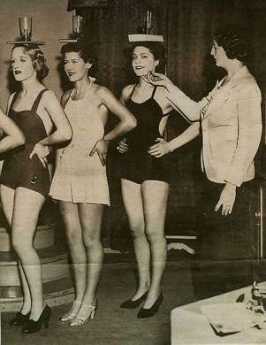
|
| Finishing School |
So that brings us to colleges and Quakers. A handful of elite women's colleges once tried to accommodate the finishing school with career preparation for blue-stocking women. The student could choose which path to follow but until recently finishing school was predominant, and comparatively few chose to be spinsters. Bryn Mawr College quickly grew to be the most prestigious college in the Philadelphia area, since both the finishing school and the bluestocking career had the needs of the upper class in mind. Quakers don't admit to an upper class but look at their colleges. Haverford was for Quaker males, Bryn Mawr for Quaker women, and Swarthmore for Quakers who fancied co-education. It was a nice arrangement, with Quaker students almost always in the minority, the rest either upper-class (read Katherine Hepburn) or brilliant scholarship students. Bryn Mawr was a little sniffy about the farm-boys at Haverford and the engineering nerds at Swarthmore. Much of that was an adolescent pose, but it created quite a rearrangement when Haverford went co-ed.
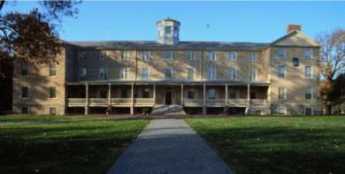
|
| Haverford College |
Almost overnight, women college applicants declared a preference for going to Haverford if there was a choice. Within a few years, Haverford students became 57% female, and Bryn Mawr suffered a decline in average aptitude scores. Why ever would girls prefer Haverford to Bryn Mawr? Indeed, if Haverford was headed in the direction of an all-female student body, Bryn Mawr would seem to be the better woman's college to pick. Somewhere buried in this adolescent stampede is probably some television-inspired confusion between the life of a suburban housewife and the life of a rich man's wife, but there certainly is a big difference in attitude about two-career families. On the other hand, there are lots more opportunities for the upper middle class than the lower upper class, both in the number of available mates and in the fall-back opportunity to try to make it as a career woman. Rich men are no longer invariably upper class, nudged by their chums to be wary of career girls. Anyway, college freshmen are pretty malleable; Haverford is a little safer bet if you aren't entirely sure of yourself.
Lumpers In Constant Combat With Splitters
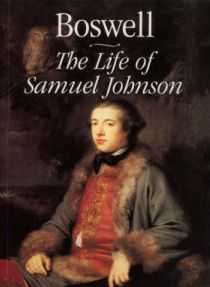
|
| James Boswell's Book |
Some colleges produce managers by teaching management theory, but in certain Ivy League colleges it is thought to be more useful to teach how to dominate a committee, eventually perhaps a board of directors, or a board of trustees. The handbook of instruction is James Boswell's Life of Johnson which is a rather large book of verbatim notes that Boswell took of his many lunches at a London club in the 18th Century. Boswell was a quiet mouse privileged to sit in the company of the great Dr. Samuel Johnson, surrounded by the most eminent intellects of the Enlightenment. Boswell carefully manages the background of each episode, describing the issue and the various arguments, and then -- Sam Johnson's booming voice settles the matter. After he speaks, the meeting is over.
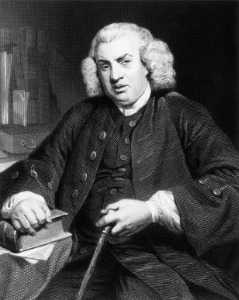
|
| Dr. Samuel Johnson |
"Why, sir", says Johnson, and then look out for the one-liner to follow. We get the impression that Dr. Johnson used that "Sir" signal to indicate he had enough of these dumb arguments, and soon would come the growled epigram that scatters any token resistance. Boswell may have neglected to record instances where the great Johnson was defeated in debate, who knows. We are left with the distinct impression that if you engaged in lunch table conversation with Sam, you were almost certain to lose. So that's what Ivy League students are being taught: how to win a debate at a committee meeting, in the expectation they would spend much of their lives in committees, boards, and even cabinets. That's how the English-speaking world gets its work done and its decisions made. That's what lunches at the Franklin Inn Club, or the club tables of the Union League, are trying to do for the education of neophytes.
As the goggle-eyed student of the great Chauncey Tinker, who gave young Pottle his start in life, it was an awesome performance for me to watch. But the rules of this game never became entirely clear to me, I'm afraid, until the other evening when I listened to Peter Nowell describe in a half-dozen brief paragraphs how he had revolutionized prevailing theories of the cause of cancer. The Franklin Institute then followed the award ceremony by putting on an all-day symposium of notables who run elaborate enterprises in cancer research, essentially funded by the National Institutes of Health, your tax dollars at work again. Last year, the NIH dispensed thirty billion -- you heard me -- dollars in research grants to internationally known research entrepreneurs, and if you can stay awake during their talks, there must be something the matter with you. So far as I could see, they were painstakingly describing every grain of sand on the beach, whereas Peter Nowell made the whole beach electric and clear in ten minutes. Essentially, he was saying that each patient's cancer is caused by a long chain of events, starting with a single mutation within a single cell. All the other cancer cells of a patient are descendants of that first one, which triggered the cascade of chemical events now repeated by the descendants. To stop the process, you probably only have to find a way to break the chain at one vulnerable point. Then you have a cure, without necessarily understanding every other link in the chain.
Peter Nowell described himself as a "lumper", admitting that most scientists are "splitters". A splitter quite reasonably attacks a complex problem by isolating one small piece of it at a time; that's really a pretty good way to address overwhelming complexity when you encounter it. But you can be sure that people of that mindset should not be found in a President's cabinet, deciding how to save the world from impending disaster. Whether by their own genetic predisposition or as a result of peer pressure in their profession, they are habitual splitters. And it suddenly occurred to me why Sam Johnson's one-liners always won the argument; he was a lumper. Usually right, sometimes wrong, never in doubt. Witty as a Frenchman, but as quick as a rattlesnake. Cordial, perhaps, unless you disagreed with him.
We need more lumpers. If they get that way from the likes of Chauncey Tinker, we need to print more copies of The Life of Johnson. If they are born that way, maybe we need a breeding farm for lumpers, which is what the Assembly Ball amounts to. But don't get me wrong, we need more splitters, too. They just have to learn their place at the table.
Volunteerism Needs a Business Plan
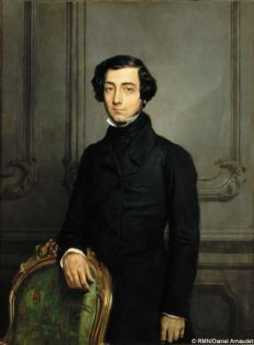
|
| Alexis de Tocqueville |
The visiting Frenchman Alexis de Tocqueville was struck most by the volunteerism he found everywhere in the young American nation; in his view, the first reaction of 19th Century Americans to a problem was to create a volunteer organization to fix it. Benjamin Franklin, who created dozens of such initiatives, was held up as its great exemplar. But de Tocqueville visited us at the beginning of the Industrial Revolution, and we are now well past that into the Information Revolution; volunteerism has noticeably declined. Not only have the great volunteer organizations like the Masons and the Red Cross suffered, but it is far more difficult to enlist the help of others to form a pick-up group to attack some issue or other. It is in that sense the general spirit of volunteerism has declined. The likely difficulty is not selfishness, but the helplessness of people to control their own time.
When volunteer groups to assemble, they are mostly composed of self-employed people like plumbers and dentists, free to be somewhere else during "normal business hours", which although shorter than they once were, seem extended by commuting time and by chores pushed aside during workplace confinement. To some extent longer commuting distances make it physically impossible to do personal chores in the vicinity of the workplace. But constrained personal time is also related to increased control behavior by management. A successful big business has to employ strategies to get employees with cell phones to stick strictly to business while the employer is paying for their time. Now that so many women are going out to work, the family unit needs to struggle to coordinate everyone's work time so there will be some remaining opportunity to conduct family life. When a working couple shares the home tasks and babysitting, the preempted time now extends to two working partners, and what is left is called "quality time". A probably temporary elaboration of this time competition is the need to chauffeur teenagers to their resume-enhancing activities. For the time being, you don't pick a college, the college picks you, and parents desperately labor to assist their children on a career path. Quite obviously, America needs to evolve better ways of trading work at home for more flexibility in the actual workplace, and we also need to build more first-rate colleges, but those issues are not the present topic. To summarize: It's awfully hard to assemble a group of volunteers simultaneously because employers have so successfully assembled their time. Failing to appreciate the tradeoffs inherent in commuting time is a secondary but still important factor, somehow related to the recent housing/schools mania.
Consequently, volunteer organizations increasingly tend to regard their chores as something you hire someone else to do if it proves impossible to dump them on someone who is retired or unemployed, or too timid to refuse. Even nominal volunteers are reluctant to step forward. This leads to recruitment lectures along the line that naturally you must sacrifice if you really truly believe in the goals of the dear old Whatsis Association, surely just a coercive speech pattern. That claptrap was never heard during the age of universal volunteers; volunteering was just one of those things everyone expected to do to get community activities accomplished. We're losing something important if we continue to endorse this attitude. Sometime during the first twenty-four hours in military service, for example, someone will surely advise the new recruit -- never volunteer.
For a penniless non-profit to adopt the solution of hiring staff when there is no revenue stream to pay them, is the first step toward the dissolution of the organization. Essentially, the non-volunteers are ordered to contribute money if they choose to be draft-evaders, and eventually, the officers and staff begin to look back at the organization members as cows to be milked. A class of people who are only making a living is substituted for those who understand and promote the goals, and it just goes downhill from there.
Instead, all volunteers really must each do some unpaid work, and the officers and directors must set an example of it. What an organization does next is crucial. Individual members, either anonymous or hoping to remain anonymous, must be approached with the suggestion they accept responsibility for a task. The wild-eyed response to this approach is quite familiar, like the lame excuse that there is no time. A counter response that I'm busier than you are, does not improve the conversation because it suggests the refuser is merely a selfish shirker. Instead, initial requests must take the following form: They should be for a simple, limited task without any obligations stretching to infinity. Almost everyone will be glad to bake a cake for a party, but almost no one will agree to be chairman of the cake-baking department unless the boundaries of that commitment are more reliably limited than they usually are.
In modern times, any major undefined volunteer responsibility is seen as potentially leading to an unthinkable conflict with gainful employment or else its ill-considered outgrowths like commuting. Since that's the basic problem, all-volunteer invitations must respect the true issue and devise workable ways to circumvent it. Role models certainly help if you have any.
www.Philadelphia-Reflections.com/blog/1448.htm
Pets For all Seasons
People who have had a chance to talk with Queen Elizabeth report she is so fond of the Korgi dog pets that she scarcely talks about anything else. Perhaps because he is British, then, Professor James Serpell seems natural to have been elected chairman of a new department at the University of Pennsylvania Veterinary School, devoted to the study of Human-Animal Interactions. In any event, he made an interesting presentation to the Right Angle Club recently, reviewing the history of acquiring pets. A domesticated animal is not necessarily a pet; chickens and cows raised for food purposes are not considered real pets. A pet is domesticated purely for the purpose of companionship and love. Study of cave paintings and fossils seems to show that pets were maintained for many years before animals were domesticated for food purposes, although hunting dogs might have utility beyond providing love and companionship. The ancient nature of pets does seem to suggest purposes other than utility have been prized for a very long time, and not exclusively by people who are affluent.
Pets are steadily increasing in number, however, and are estimated as approaching 160 million, a number growing faster than the human population of the earth. The human residents of the earth are just about the only species known to make pets of other species, although monkeys will occasionally treat marmosets in a pet-like way. There might still be some utilitarian purposes in keeping pets, however; a goat companion is observed to have a calming effect on wild horses. For something whose utility is marginal, pets are a pretty expensive hobby. It is estimated that $45 billion is annually spent on them. A non-pet lover was once heard to remark that a cat is a domesticated parasite. Apparently, you either love pets or you don't.
It probably hasn't much to do with the motives of pet-lovers, but research does seem to show that those who maintain pets live longer than those who do not, whether the pet is a cat, dog, or rabbit. Pet owners have lower average blood pressure and score better on tests which reflect the prevailing stress level. In spite of snide remarks sometimes heard about people who love pets better than their neighbors, tests of interpersonal relationships actually seem to favor pet lovers.
In recent decades, there has been a growing tendency to confer rights, animal rights, on animals in general, and pets in particular. Remarkably, animal rights advocates seem to be more common in urban environments, than in rural ones. Perhaps the experience of wringing a chicken by the neck in order to prepare dinner hardens the heart. Next thing you know, the Tea Party phenomenon will start getting blamed on observations like this, so watch your language, please.
Avian Footnote
Waldo E. Nelson was a much revered professor of Pediatrics at Temple University School of Medicine for several decades. He was the original source of fame for St. Christopher's Hospital for Children, a powerful and revered teacher, and has recently been mentioned as the "Father of Pediatrics." He died in 1997 at the age of 98.

|
| Saint Christopher Hospital |
Everyone admitted he was a demanding task-master, to the point of eccentricity. That's a quality almost essential in any editor of a multi-author textbook because authors regularly procrastinate in submitting their contributions, while publishers have rigid deadlines and no patience at all with editors who ask to extend them. The central element in Nelson's fame was his 1600-page textbook of Pediatrics, with more authors than it is reasonable to count in the decades it was published and re-published, eventually establishing itself as the standard work in the field. Nelson applied discipline to his resident physicians, too. One former resident recently recalled his forbidding a husband and wife resident pair to eat lunch together in the hospital cafeteria. Not in my hospital, you won't.
What his family life was like is not reported, but it can easily be imagined that he had rebellious children. One day he instructed his daughter to prepare a complete index of the textbook for the next edition. Apparently there was some resistance, eventually quashed. And to emphasize how unlikely it was that anyone would read an index very carefully, the book went through editing and proof-reading, and was in the bookstores for several months before anyone noticed the entry tucked away under "Birds".
BIRDS, For the. page 1-1650.
Starving the Beast of Early Retirement
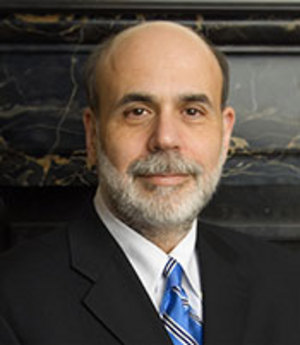
|
| Chairman, Ben Bernanke |
Inflation-targeting, unless someone is keeping a big secret from us, is the only arrow in the quiver of a nation's central bank, in our case the Federal Reserve. A strong case that the Federal Reserve should acquire no other duties, rests on the fear that any new duty might conflict with holding inflation on target (at present, 2% per year). The recent adventure of the present Chairman, Ben Bernanke, into "Quantitative Easing" illustrates that diluting and confusing the role of the Federal Reserve will tempt the Executive Branch to poach on its independence. In this particular case, the adventure was the purchase of vast amounts of bad loans in order to remove them from the economy, never mind the future problem it will create of re-selling those loans to someone. Mr. Bernanke is lending credibility to the outcry of Representative Ron Paul (R, Tx) that the Federal Reserve should be abolished entirely.
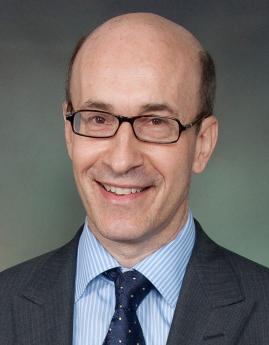
|
| Kenneth S. Rogoff |
Maintaining price stability (Inflation targeting) rests on Alan Greenspan's simplification of Milton Friedman's "monetary" theory that you can combat inflation or deflation by appropriate adjustments of interest rates and the money supply. Greenspan's further insight was that you needn't measure "monetary aggregates", you just have to measure inflation itself and react like a helmsman with a compass. Until 2008 it looked as though Greenspan had won the argument, by avoiding a deep recession for seventeen years, in the so-called "Great Quieting". Inherent in this helmsman theory is a deeper theory that all episodes of deflation (depression, recession, whatever) are merely over-reactions to inflation; avoid inflation and then forget about deflation. Still further behind this analysis is the observation that all governments at all times are pushing toward inflation, count that as an immutable law. The blunder of holding interest rates too low in 2001-3, for example, has been blamed as deliberately inflating in order to combat the Dot-Com crash of 2001 for political reasons; by this reasoning, the rescue of the DotCom dip led straight to the 2008 Subprime plunge. There is thus evidence that monetary effort by the Federal Reserve is powerful enough to control inflation, provided other branches of government abstain from political interference. In the long run, however, the Fed can only smooth out wobbles in the main trajectory. As Rogoff has shown, all crises whether of currency, banking, commodities or securities, are pretty much the same and caused by unwise borrowing. Avoiding inflation is enough to prevent a recession since government pressure to inflate can be counted on. Paul Volcker may have proved the issue in another way in 197_. During the Carter Administration, the country experienced "stagflation", we had inflation and unemployment at the same time. Improving one might seemingly make the other worse. But, dismissing the whole mess as inflation in disguise, Volcker promptly jacked up interest rates a great deal -- and both inflation and unemployment then went away. What seems proven is that stagflation is just a variant of inflation and should be treated by sharply raising interest rates.
If inflation targeting is as powerful as that and as simple as that, what could go wrong? One present worry is that so much American money has fallen into foreign hands that the Federal Reserve could lose control. There is a second source of danger. Broadly speaking, this concern is that public opinion might demand inflation -- or policies which would surely cause it -- and in a democracy, the time might come when the Federal Reserve would have to give people what they demand. James Madison warned us about that. In a democracy, it's their country to ruin if they please.

|
| Fringe Benefits |
New Jersey increased the number of state employees and their fringe benefits. As is so often the case, these state employees and their union became the core voting bloc for the party in power, usually Democrats. Not only are there a remarkable number of employees in each of the local offices for the Bureau of Motor Vehicles for example, but New Jersey included the local municipal and school employees (mainly police and school teachers) in the state health and pension system, a decidedly unusual step. These were not trivial costs. Longer life expectancy makes pensions and health care more expensive. Just how a ten-mile ambulance ride gets to cost $1700 is a related story, passed over here. And then, a few years ago it seemed like clever bookkeeping to float a bond issue to bring the state pension system up to full funding. Long term full funding tends to mean a stock portfolio, buying stocks with a bond issue is like buying stock on margin. By a stroke of timing, the booming dot-com stock market promptly crashed, taking New Jersey's margined stocks down even faster. In a sense, not only has the state raised the reimbursement of its workers, it has guaranteed them for life.
New Jersey has always had high real estate taxes, now painfully high. But Jersey residents once could console themselves they had no sales tax and no income tax. Now, NJ sales and income taxes are nearly the highest in the country, and just about every other form of state taxation is at unsustainable levels. Doesn't matter, the state is running a $5 billion deficit and will run a greater deficit for as long as anyone can predict. Forbidden by the courts to borrow money, it's not easy to see what the Governor can do except raising taxes some more. Well, perhaps there is one thing if the unions will let him. He can extend the retirement age of state employees from the present age 55 to age 75. Having retired at age 81 I have little sympathy and have even written a long essay praising the joys of late retirement.
But let's see him try to do that without anyone noticing.
New Museum of Chemical Heritage
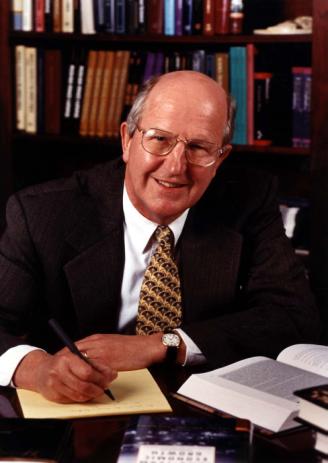
|
| Arnold Thackray |
Eighty percent of the ethical drug industry is located within a hundred miles of Philadelphia, and the whole chemical industry has had its center here for two centuries. The chemical industry is the region's largest manufacturer, now that locomotives and beer brewing have come and gone, but its profile remains low. In fact, chemists personally have a low profile too and harbor a smoldering annoyance about it. No one has been more determined to change that nerdy image than Arnold Thackray, the recently retired President of the Chemical Heritage Foundation. He's not only a big idea man but bubbles with energy and persuasiveness. That largely accounts for the fact that CHF has the second largest endowment among public institutions in Philadelphia, the best library of chemical history in the world, and a growing reputation for fine art concentrated in the field. That's not enough for him, so it came about that a new museum was envisioned, funded and created. But not built; building it was assigned to Miriam Schaefer, a famous go-getter who had the unusual qualification of being squeamish about chemistry. It was her assigned task to find a way to make chemistry exciting to people who were not instinctively excited by it, just exactly because she was the world's authority on that point of view. What was vital was that she was the sort of person who can't resist a challenge, and was capable of thinking, well, big.
With the unlimited backing of Arnold and his board and their almost unlimited financial support, Miriam set about soliciting big ideas from uninhibited people all over the world, and some of their suggestions were even a little too wild to be acceptable. But since the whole idea was to awaken the enthusiasm of anybody, however sullen, who happens to shuffle through the museum, many outlandish suggestions were forced through the filter of a skeptical, conservative, Philadelphia establishment. The result is a series of pleasant surprises, ranging from fine art with a focus on alchemists trying to make gold out of lead, to astonishing computerized graphic displays of the elements of the periodic table fifty feet high, to depictions of Joseph Priestly known as the father of chemistry, a personal friend of Benjamin Franklin, the founder of the Unitarian Church, and a resident of Philadelphia. There's Arnold Beckman's original Beckman spectrophotometer which made hundreds of millions of dollars, was a major factor in the Twentieth century blossoming of biochemistry, and is here shown to be a clever elaboration of a simple idea. Meanwhile, the museum is housed in a massive old bank building, with it is interior reamed out and replaced with as much transparent glass as could support the weight. Inga Saffron the architectural critic, more than foamed over with praise in her review of just the structure itself. Don't neglect to notice the stunning portrait of Gay-Lussac, the man who discovered that water is H2O. The pigments of his portrait were mixed with beeswax, and with clever lighting have an astonishing luminosity.
The museum is part of an emerging conference center, which should attract audiences of chemists for decades. But that's not entirely the whole idea. The underlying vision is to convince those skeptical, non-chemical bozos that not only are chemists rather richer than the rest of us, and smarter, but clever and fascinating, too. Go visit this museum, before everyone else does.
 |  |  |
 |  |
School Tax Seldom Equates to School Spending
 |
| Little Red Schoolhouse |
As this blog went to press, voters throughout South Jersey had just gone to the polls to vote for school boards and school budgets. Or, at least they had the opportunity to do so, but mostly 15% of eligible voters actually troubled to vote. Meanwhile, school officials chewed their nails in apprehension that many budgets would be disapproved by the taxpayers, and then what? As it turned out, Haddonfield and Moorestown approved their budgets, but over half of the 700 school districts of the state did not. The voters wanted to send a message they were angry about property taxes, and the seemingly related fact that over half of school employees are not teachers. Some of them mistakenly believe county taxes have something to do with schools. If they had really understood the situation, they would have been angry that the size of their local school budget has comparatively little to do with the level of their total tax burden.
Meanwhile, voters with children had been agitating to support the budget or even raise it, even if it raised their taxes; but empty nesters were urging each other to go vote down this budget because their taxes were already excessive. The parents of schoolchildren urged the empty nesters to move somewhere else where they couldn't vote down school budgets. Actually, however, if more empty nesters moved in, property taxes would go down without affecting the school budget, because empty-nesters pay taxes without using the schools. Both groups are quite misguided, however, because raising or lowering school budgets would probably have very little effect on overall taxes. Even school officials failed to make their best case to the public because they misunderstood the tricky way taxes are arranged. They defend every budget by saying it is already cut to the bone. Since it presently makes relatively little difference to overall taxes whether the budget is cut or increased, that's not useful in persuading empty nesters. Budget cutting does make a lot of difference to the quality of education, however, but that's only half of the facts, not a balanced one. The moral of all this is that the voters better get educated about the Jersey political scene, before their children lose the chance to get educated at all.

Since I'm an empty nester, I am pretty familiar with the empty-nest viewpoint. Three of my friends have told me they moved to neighboring suburbs in order to lower their tax burden; they undoubtedly know what they are talking about. But no one I know is able to reconcile that fact with the equally certain fact that Haddonfield has the lowest spending on education, per pupil, in the southern half of the state. In fact, they don't care, because they know that local school taxes are significantly lower almost everywhere else, and they don't have to explain why. School officials should be more concerned with explaining their rank in per-pupil spending compared with other districts, but they are driven to make cuts in service where ever they can in order to produce a leaner budget for the voters. They too, seem oblivious to the fact that voter anger won't be soothed for long by their budget cutting because it won't affect overall taxes. Taxes are what people are mad about, but they must consider all of them, and understand that as one goes down, the other will probably go up. In another article, we discuss how they mysteriously go up even more. A more sophisticated view would be that in addition to concern about eradicating poverty in the long run, residents of New Jersey are increasingly driven by the need to get their children into better quality colleges. They would like to improve secondary education to do so but are hampered by the relative unavailability of high-quality colleges in the state. Some of this has to do with the recent tendency of Princeton and Rutgers to seek a geographical diversity of students. But to be cynical about it, the development officers of those colleges know that major donors are to be found in Texas and California. In New Jersey, the majority of income taxes are paid by 1% of the population, and that !% are fleeing the state to avoid its heavy income and estate taxes, just as fast as they can. This is the group that tends to donate most heavily to college improvements, and New Jersey colleges are suffering from their flight. That argument may well be hard to sell in Newark and Camden, but it has a major indirect effect on business creation and employment in the state as a whole.
To return to basics, New Jersey school spending is governed by the Abbott decision, which happens to have been written by a friend of mine, who is a fine, smart, well-intentioned jurist. So-called Abbott districts were found by the courts to have significantly underfunded schools, to the point where it seemed an important public issue that the wealthier parts of the state must help these underprivileged kids get an adequate education. Whether improving the school system in their districts would reduce the crime rate, or welfare rate, among these children in later life, was not then known, but subsequent experience does not give it much support. Mainly, it wasn't so much trying to reduce public expenditures in the long run that was behind the Abbott decision, as the feeling it was the duty of a prosperous society to give deprived kids an even break, a sort of penance for success. Accordingly, state school tax revenues were rearranged in an effort to make the per-pupil spending for education approximately equal in all districts, and particularly in the most deprived areas, the Abbott Districts. The first clear sign that something unintended was happening is shown in the accompanying table, indicating that spending in the Abbott districts was in fact now about fifty percent greater than in prosperous nearby suburbs. Equality might be all right, but fifty percent greater was probably not acceptable to the taxpaying public. Just how that paradox gets accomplished in Trenton is not yet clear, but the discomfort level about it is heightened by noticing there is generally an inverse relationship between the spending per-pupil and the perceived quality of the educational product. You might compare drop-out rates, crime rates, SAT scores or whatever, but public perception is not likely to overcome data seeming to show that the more you spend, the worse the education. One wag commented that the data also seems to show that the further you get from the Delaware River, the lower the educational spending gets; that relationship is also more or less linear. So, what matters here is opinion, and the prevailing opinion is emphatic that this data is upside down. The Abbott decision that school spending must be equalized but is actually greater accounts for much of this funny data, but in addition there almost has to be some overlooked secondary factor which exaggerates the Abbott effect by as much as 50% beyond equality.
Even the education industry has an incentive to explain at least and possibly to correct, this disparity. Because in politics while you can prove almost anything with statistics, it is quite seductive to imply that this data proves that extra educational spending hurts the quality of education, at least above a certain level. The education industry wouldn't be wise to let that sort of accusation go unanswered, even if it comes as a wisecrack. The real empty-nester accusation, sorry to say, is that "My school taxes are way too high. They not only do me no personal good but are not helping underprivileged children, either." The consequence is empty-nesters are driven out of town and out of state, making taxes higher for everyone else. It could take decades to undo this damage with an angered public, so everybody better get to work explaining and correcting the problem.
The Supreme Court Gets Fed Up With Professors
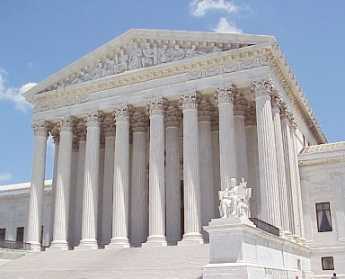
|
| Supreme Court |
In March 2006, years later, the Supreme Court, like a sleeping alligator, suddenly clamped its jaws on the whole Ivy League. Unanimously and without explanation, the Court told Universities they could not block the U.S. Armed Forces from recruiting on their campuses. A number of Ivy League Universities, in this case, the Yale Law School, had turned away Army recruiters because the Professors were offended by the Army's "don't ask, don't tell" policy on homosexual soldiers. The Supreme Court didn't even consider the reasons for the University's' policies, although private opinions of the Court conservatives could readily be imagined. The Court would not even dignify the matter with the thunderous phrases about first principles which otherwise might have seemed tempting. The Chief Justice signed the order, the Court unanimously agreed, and that's as final as you are going to get, for a show of power.
About a month earlier, things had seemed to be going the other way. The Harvard Faculty had forced out their president, Lawrence Summers because he violated their idea of politically correct speech. Quite significantly, two-thirds of the students took the side of Summers in the dispute, a warning that the faculty was getting itself into an isolated position. And if you look back, the nation had divided when it twice elected the younger George Bush, support for East Coast urban elitism was likely coming to the end of a fifty-year dominance of American life. Not to put too fine a point on it, the country was getting tired of the bitter-end Vietnam War protesters, now entrenched in academic strongholds like Robert the Bruce. It may well be that the country was irked by expensive gasoline, French disloyalty, and Middle East intransigence, while the Legal profession was having a private quarrel. Clever of the Chief Justice to allow people to think what they pleased. The Constitution directs the Armed Forces to defend us; interfering with recruitment is at best impertinent, at worst imperils the nation.
The Supreme Courts of the various states and the U.S. Supreme Court within the federal court system retain the power of administration of all the courts which report to them, but they rarely exercise that power actively. As the number of judges has increased significantly in the past thirty years, public oversight of the selection or election of judges has been stretched to the vanishing point. The result has been a strengthening of political control over the courts, a lessening of the quality of the judges themselves, and a growth of the influence of law schools. The same parade of professors keep appearing as friends of the court, the metropolitan newspapers can always count on them for Op-Ed pieces on difficult topics. Their opinions begin to surface as their graduates start to enter law practice. Slowly and relentlessly, the viewpoints of faculty members of the five prestige law schools have come to challenge, and sometimes to up-end, the rigidly organized opinions, right or wrong, of judge-made law. When it reaches the point where law schools can blithely block the ability of the armed forces to defend the country from foreign attack, it is past time to do something about it.
Some things never change. But this is going to change, and soon.
Gardening Survives
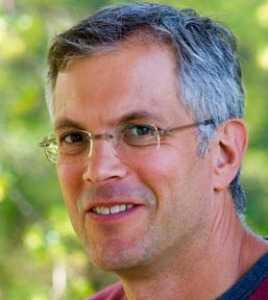
Adam Levine, the author of a new book about the Philadelphia public garden scene was recently the featured guest speaker at the Franklin Inn. He's a charming person, and has given us a great book.
He draws to our attention that the Philadelphia region is pre-eminent in the garden world, and has been so for several centuries. While it is true that Philadelphia has a mild enough climate to be suitable to two climate zones, the early settlers came from a region of middle England that has been a garden center since Roman times. And they were Quakers, uncomfortable with the outward show in buildings and furnishings, but flowers were innocent instruments of the display. Although Chanticleer was created by a Pennsylvania German family, the great centers of public gardens are mostly traceable to the influence of Quakers, and the du Pont family. Since one or two years of neglect will ruin almost any garden, the essence of great gardens lies in the ability to survive.

|
| The Horticultural Society |
In fact, the Philadelphia area contains hundreds of gardens which have decayed and virtually disappeared. The Horticultural Society is at the heart of garden preservation, financed in large part by the annual flower show, but even that thriving organization is hard pressed to do justice to the vast areas that need tending. Woodlands would be an example of an area needing tending, and Friends Hospital is an object lesson. When that venerable institution was sold to sharp pencil types from out of town, the Azalea gardens on the grounds were closed to visitors, except for two hours a year. It makes you tremble to imagine how long this famous azalea collection will probably survive. Meanwhile, Germantown's famous gardens are maintained in a minimal way, stretching the resources of the owners who have more urgent demands to meet in their buildings and furniture. Indeed, it is hard to name a really outstanding garden within the city limits, with the exception of the Morris Arboretum, which barely makes it within city boundaries. The area back of the Art Museum along Boathouse Row makes a brave attempt in the spring, but it's a pale reminder of the glory which used to be seen in East Fairmount Park, especially at Lemon Hill, Stenton, and Cliveden. Stotesbury is just a relic.

|
| Morris Arboretum |
Gardens have moved to the suburbs. Chanticleer, the Morris Arboretum, Longwood Gardens, Nemours, the Scott Arboretum at Swarthmore, West Laurel Hill, The University of Delaware in Newark, Cabrini College in Villanova, Haverford College Arboretum, Temple University's Ambler campus, and the Trenton Sculpture Gardens on the old fairgrounds -- all would demand mention in any list of outstanding gardens in America. But only a few of them aspire to the standards of an outdoor sculpture garden, where the goal was to surround each piece of sculpture with a garden in such a way that only one sculpture could be seen at a time. Now, that was gardening on the grand scale.
Hidden in a regional garden scene is the seed merchants, starting with John Bartram and famous under the Burpees, which make gardens possible. After all, there has to be a place to find these things. Perhaps the catalog stores, like Wayside Gardens, are the hope for the future. Every shrub or tree transported from a nursery takes up a ball of topsoil along with the specimen, and the appearance of nurseries around the periphery of a city is usually the first step in the development of housing projects. If there is an investment of topsoil in every garden, perhaps we ought to think a little bit about the way we let the investment dry up and blow away.
REFERENCES
| Gardens of Philadelphia and the Delaware Valley William Klein Jr. ISBN-10: 1566393132 | Amazon |
America's New Theater Capital
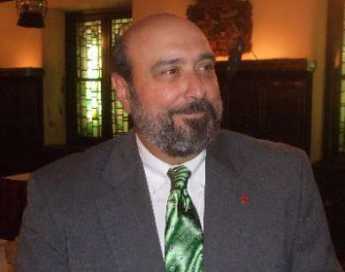
|
| Gene Terruso |
In the Elizabethan era, London experienced a remarkable burst of legitimate theater; Shakespeare was only one part of it. There were fifty-five theaters in London at a time when only two were open in Paris; no one is certain why that happened. Similarly, no one is sure why Philadelphia has decided to have a flourishing theater scene, but if you look around it is true. After 1929, Philadelphia became a "try-out town" for plays hoping to go to New York; we were in a class with New Haven CN and Washington DC. Home-grown talent languishes in competition for audiences who would rather see famous visiting stars. The try-out image is harmful and must disappear before local talent can develop. Once established, however, audiences rather like a theater company with a deep bench; fresh young aspirants at every level, as contrasted with one famous star surrounded by hacks in the lesser roles. The same reaction is seen in minor-league baseball. And no doubt union seniority systems are partly designed to protect the hacks from competing young aspirants. A certain amount of amateurism is forgiven for inexpensive amateurs; when they get expensive it's better to watch movies. The Right Angle Club was pleased to have it all described if not explained by Gene Terruso, the Professor of Drama at the University of the Arts on Broad Street where the old Ritz-Carlton used to be.
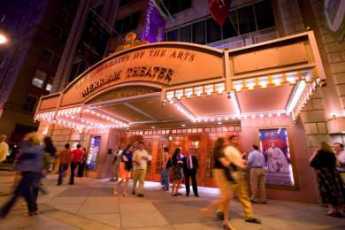
|
| The Merriam Theater |
As far as inside gossip is concerned, the Merriam Theater is owned by the University of the Arts but is sort of doomed to shabby prosperity for the next 13 years by a lease which is too lucrative to modify. That's why the seats are a little uncomfortable, the lobby dilapidated, and comparatively few student productions are on the stage. The University would like to have more student presentations but isn't in a financial position to displace the tenants generating such high revenue. The best that can be made of the present arrangement is to encourage the visiting professionals to mingle with the drama students, bedazzling and advising them how to advance in the Big Time. It's been a fairly successful compromise.
Until recently, Chicago seemed to have the most successful regional theater experience, but now is thought to be on a par with Los Angeles, Seattle, and Cincinnati whereas Philadelphia has supplanted it as the very best place to be. Going backstage, the kids express little interest in going to Broadway, where overpriced theater seems to them to be just part of the tourist industry. Television is regarded as old-fashioned, so Hollywood is unattractive to them, too. If that's all the future holds, these kids would rather become accountants and computer engineers. And stay right here if they can; that seems to be a central motif. Gene Terruso says there is an "Iceland phenomenon" in Philadelphia, a wonderful hidden place to live, so tell everybody else it is cold and dreary and they will stay away and not ruin it.
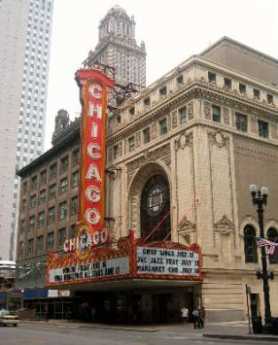
|
| The Chicago Theater |
The fact seems to be that Chicago is seen to have a great many "hole-in-the-wall" theaters, while Philadelphia has well over thirty flourishing theater troupes. The professor in him prompts Gene Terruso to postulate that the secret of our success is for each repertory troupe to specialize in something, get good at it, and bank on the motto Be clear about your mission; the audiences will follow. Therefore, we have Shakespeare companies, musicals companies, Restoration comedy companies, and so on. Some specialties are obviously more popular than others. Somewhere in this business school analysis is the likelihood that artsy craftsy people are seldom very good at running a business, so theater success does depend on non-actors who are business-oriented minding the store, and possibly not much good at acting. It's a lesson many idealists and liberals need to learn, and not just in the theater.
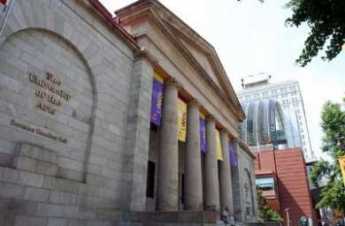
|
| University of the Arts |
Professor Terruso does ruefully admit that the University of the Arts is a conservatory, by which he means a trade school. Its graduates are more likely to know how Hamlet should run a sword through Polonius without killing the other actor than to discuss the place of Shakespeare in our cultural heritage. To have a successful theater, however, there has to be an enthusiastic audience. Somewhere, our universities have found it easier to provide a liberal education to one group of people and impart the tricks of the trade as a specialty of someone else. If the two talents merge at all, it is in the profession of Dramaturge, but all in all, it would be better if both sides of the footlights understood each other somewhat better. Going to the theater really isn't a specialty, and it isn't a secret society, either. That's part of the response to city leaders who greatly desire a thriving theater, but wish we didn't have to see so many of those artist types walking around town. Both groups need to understand "There's plenty of room at the top, but no room at all at the bottom."
Perpetuities
Although some churches and mummies are well preserved after thousands of years, and no doubt a few corporations do last century, the fact is most of them don't last very long. Most new corporations go bankrupt within ten years, and only one (General Electric) of the original thirty members of the Dow-Jones Industrial Average existed in 1900. Members of the Dow may seem the biggest and best, but in fact, live on a slippery slope. Not-for-profits, like churches, may do somewhat better, although the handful who approach perpetual status may be rare exceptions. One big reason not to leave a major bequest to any of them may well be that most will not survive. While we are on this subject, the same reasoning applies to the stock in for-profit corporations. Since few of them thrive for more than seventy-five years, the idea of buying their stock, holding it forgotten in a safety-deposit box, and passing it on intact to heirs, is probably doomed to investment failure. The oldest stockholder company in America is called the Proprietors of West Jersey, founded in 1676 but still meeting once or twice a year. It would be moderately interesting to know how well this investment performed over the years, but Google sounds like a better bet offhand. Just don't hold it too long.
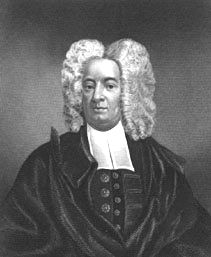
|
| Cotton Mather |
There may be a connection between success as a non-profit and success in the merciless marketplace. Those who have compiled statistics will tell you that steadily withdrawing more than 4% a year from an endowment portfolio, sooner or later leads to a day when there is nothing left. Most trustees expect better results than that, and most managers of non-profits will need more than that, no matter how big the pile was when they started. Sooner or later, markets will decline, mistakes will be made, and the endowment will be exhausted by "emergency" withdrawals which relentlessly withdraw more than 4%. This pitiful decline might be avoided by gathering the managers of influential non-profits together, giving them a stern lecture, and somehow forcing them to live within their means, but offhand nothing sounds more futile. Jonathan Edwards and Cotton Mather were said to be good at haranguing. But since it must be obvious that non-profits usually survive by constantly soliciting fresh endowment funds, what would be the matter with taking a direct approach to that goal. Why not just state in advance that the institution is only intended to do its good work for say fifty years, and then it must turn its residuals over to somebody else? Not many endowments have been limited to a lifetime of fifty years, but in those who have done so, the experience seems to be that most of them immediately set about to raise additional funds to keep the institution from disappearing. The American Enterprise Institute in Washington, for example, started out dispensing about a million dollars a year; last year it dispensed over $30 million. Whether he intended it or not, the message Mr. Olin transmitted was not that think tanks are only good for thirty years. He told his executors in effect, "You have some seed capital with which to start a think tank. Whether it lasts longer than fifty years, is now up to you."
Politics of Employer Hiring Preferences

|
| Interview |
To a remarkable degree, employees tend to remain in either the nonprofit or for-profit sectors of the economy for a lifetime. A prospective new employer naturally wants to know about previous work experience so it is natural enough to poke around for clues. An interviewer may just be jumping around when most questions are fired at a prospective new hire, but this one is hard to dodge.
Whether it is a reasonable position or not, almost everyone on both sides of the interview desk has the impression that for-profit employers prefer to hire people with experience in the for-profit sector, and the reverse is true for non-profits. So far, so good; experience in related fields is an attractive feature. But going considerably beyond favoring prospective employees with related experience, there is a general impression that experience in the other sector has a curse attached, reducing the chances of being hired. When an impression is this widespread, it no longer matters whether it is sensible. Make the wrong answer, and you don't get the job; that's reason enough. And it's equally true in both sectors, so the workforce segregates pretty quickly.
It's plainly true that the for-profit sector votes Republican, the non-profit sector registers, votes and talks pro-Democrat. Since young people usually vote for Democratic candidates, it seems to follow that party-switching is mainly in the direction of young Democrats becoming Republican after a few years of employment, although the reverse is seen when young residents of farm communities move to the city, with college sandwiched in-between.
Going to college may not be exactly like being employed by a college, but it's close enough. The faculty are in a similar power relationship to students as a boss is to employees, in command, but also portraying a role model and parent-figure; it is axiomatic that students emerge from college more liberal-leaning than they entered. It's beyond challenge that college faculties are the most liberal-leaning group in America; their institutional employers are all in the non-profit sector to some degree. As long as government research grants, scholarship grants, construction subsidies (and indirect overhead allowances) continue to dominate the finances of higher education, the allegiance of all colleges and universities will belong to the party so proudly representative of non-profit principles. Professor Gordon S. Wood of Brown University has propounded the theory that the 18th Century concept of a gentleman had three distinctive features: he didn't need to work, he deplored aggressive money-making, and he went to college. Americans dislike the concept of the aristocracy, but they strongly favor playing the role of a gentleman. It's as good an explanation as any.
Future trends are of course hard to predict, but since the proportion of the population going to college is steadily increasing, there is a strong force in the direction of continuing to strengthen the Democratic party. But since taxes derived from the for-profit sector are the ultimate source of all non-profit revenue, some strong push-back from present trends also seems inevitable.
Sorting Out Future Winners Some Suggestions
 It's getting to be time for the country to tell the education industry what is expected of it. 
|
| Dr. Fisher |
Secondary schools strive to be known for their well-rounded excellence. That's pretty hard to measure, so the prevailing in-a-nutshell scoring system is the placement of graduates into highly selective colleges. Secondary school reputation is thus a creature of college admission officers, who mostly rely upon aptitude test scores. To cut all this down to size, what's measured is inborn aptitude of the students more than the quality of teaching. Maybe it's time we acknowledged that, and acted upon it more openly.
One approach would be to give each one of a very large group of college admission officers sole authority to admit a small number of students and then to make the careers of the admission officers depend on the longitudinal outcome. If the students flunk out of college, you better get a new college admission officer. If a majority are admitted to high prestige graduate schools, however, consider a promotion for the admission officer. If a graduate wins a Nobel prize, the immediate question should be, "Whose admission was this?" Ultimately, there would be another question, "Who's picking these admission officers?"
A second approach would be to devise more dynamic relationships between the SAT testing system, and its long-term results. Good scores on multiple-choice questions may closely predict later success -- as a computer designer or dermatologist. But important leadership professions like politics, business, and the military are skeptical that "braininess" is the most important asset for their careers. People in those walks of life regard the aptitude tests as a nuisance, designed mostly to simplify the task of overburdened admission officers. College admission officers, in short, are under suspicion of promoting themselves into a new elite. After fifty years of experience with their tools, it is time their outcomes were evaluated by the public they serve.
Still a third approach, arises out of growing discomfort with recent advances in molecular genetics. After all, if Darwin's theory of evolution is essentially accepted, it brings us close to the old positions of Calvinism. God must surely hate poor people, or he wouldn't have made them poor; or, He must surely love rich people if he made them rich. If Chinese people have 10% higher IQ than Caucasian Americans, you can safely predict what will happen in fifty years if we encourage immigration, or in a hundred years if we don't. But this is too general; let's look at more specific aptitudes.
When remarkable musical talent makes its appearance at the age of three and follows a noticeable family clustering, there can be little doubt of its genetic source. The Curtis School of Music has long attracted a student body of child prodigies, and the long term results seem to demonstrate lifelong musical excellence is what emerges. A fair amount of artistic temperament also emerges, but its genetic origin is less clear. It's hard to escape the conclusion that inheritance of a small number of genes is responsible for unusual musical ability, and that a blood test for this condition will probably soon be offered us. Whether intermarriage is a good thing or not, throwing these children together in a special school is practically certain to result in intermarriage, with consequent inbreeding of the Arabian racehorse variety. If we decide we want this to happen, we can establish more schools for the musically gifted. But if what else the system produces turns out to resemble side-show freaks, then the matter is less tolerable.
And likewise for the athletes, perhaps subdivided by sport. Football tackles and eighty-pound gymnasts may well be different genetic groups. Speed reading and speed talking seem to run in families. And then, there's an interesting observation about artists and literary figures.
In the past, it has been observed that fine art tends to be produced by the children of the artisan class, while literary celebs are more often the product of professional families. Professionals do tend to live in certain suburbs, artisans in different suburbs; selective intermarriage seems inevitable. Special schools for the artistically talented might be selectively placed in artisan neighborhoods, literary schools in professional districts, mathematics in areas with many engineers. The virtuous circle would soon emerge, as talented people sought these school districts out. It's rather probable that most of the prodigies selected by such eugenic scheming would fail to meet the standard of being well-rounded. Surely there are ways to test this sociology and determine whether we want more Arabian racehorses or whether we don't. Rich men marry beautiful women, and their children, therefore, tend to be handsome. Few people would challenge the accuracy of the observation. Nobody knows whether it is a good thing. Political correctness is a hindrance to finding out some things of immediate importance.
No Laborer Left Behind
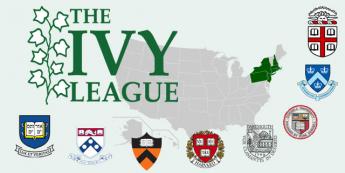 |
| Ivy League |
The top thirty American colleges have ten times the applicants they have room for. Demand vastly exceeds supply, prices are essentially fixed; shortages result. Can-do is the American way, so our first reaction is to build a lot more colleges and beat them over the head if they aren't first-rate. To bring this down to a local scale, implications are that Philadelphia has a moral duty to build eighteen more Ivy-League universities.
 |
| Cosa Ricians Roofers |
Let's think about that, in a back-of-the envelope way. Since the rest of the country is going to be similarly driven, we can't attract Americans to run those universities. Philadelphians who are doing other things must staff those universities; people inclined to become professionals of a different sort are going to have to be trained to be university professors. Students now being rejected will be admitted, since that's the purpose of the thing. Unless we somehow increase academic productivity, every man, woman and child from Trenton to Wilmington is going to be in a college classroom in some capacity or other. We here confront the extrapolation fallacy; a new problem must be addressed in more productive ways than just more of the same.
Curiously, the readjustments to this overall shift from an industrial to a service economy are first making their appearance in things like roof repairs and ironing shirts. When my house needed a new roof, I found I had a choice of workgangs composed of Costa Rican, Puerto Rican, or Polish roofers. The Costa Ricans made the best bid and went to work immediately. They started pounding on my roof at 6 AM, and we're still pounding after I went to bed at night; I have grave doubts that American roofers would approach that work standard. I am told that the entire building industry, on which our current prosperity rests, would collapse if we banned illegal immigration. In a different industry, Philadelphia's convention hall cannot attract visitors unless we build more hotels. But the hotel industry cannot find nearly enough people who speak English to make the beds. For one purpose or another, we have imported 12 million illegal immigrants who mostly remain invisible because they are so hard at work.
We are going too recklessly fast with what is fundamentally a useful transformation of our society. Americans want to go to college because statistics show that will make them prosper. But that's only half of their transformation. The other half is a resulting shortage of labor in the jobs which do not require college. Normally, you would expect wages to rise, but they are suppressed -- deflated -- by substituting immigrant labor, legal and illegal. Impose an effective barrier to immigrants, and you would quickly see inflation like you wouldn't believe. Combat inflation by raising interest rates and the housing market would quickly collapse. That would prove to be a painful way to make the immigrants decide to go back home, although it would be effective. And so on, and so on, and so on.
Slow down, America. You're going in the right direction, but exceeding the speed limit.
Existing Websites Which Offer Higher Education
Immense: Here are a few of my favorites--
https://ocw.mit.edu/OcwWeb/web/home/home/index.htm
https://mitworld.mit.edu/browse
https://www.youtube.com/user/MIT
https://numericalmethods.eng.usf.edu/
https://www.apple.com/education/itunes-u/whats-on.html
Wistar Institute, Spelled With an "A"
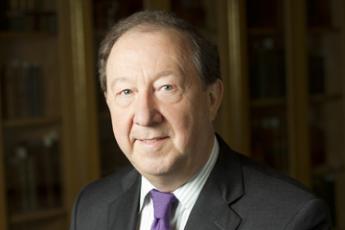
|
| Dr. Russel Kaufman |
The Right Angle Club was recently honored by hosting a speech by Dr. Russel Kaufman, the CEO of the Wistar Institute. Dr. Russel is a charming person, accustomed to talking on Public Broadcasting. But Russel with one "L"? How come? Well, sez Dr. Kaufman, that was my idea. "When I was a child, I asked my parents whether the word was pronounced any differently with one or two "Ls", and the answer was, No. So if I lived to a ripe old age, just think how much time and effort would be wasted by using that second "L". In eighty years, I might spend a whole week putting useless "Ls" on the end of Russel. I pestered my parents about it to the point where they just gave up and let me change my name". That's the kind of guy he is.
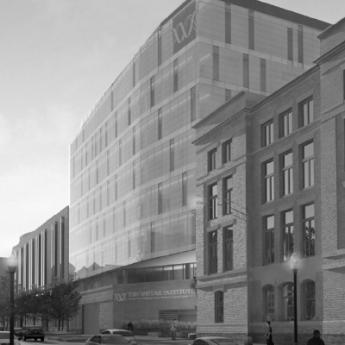
|
| The Wistar Institute |
The Wistar Institute is surrounded by the University of Pennsylvania, but officially has nothing to do with it. It owns its own land and buildings, has its own trustees and endowment, and goes its own academic way. That isn't the way you hear it from numerous Penn people, but since it was so stated publicly by its CEO, that has to be taken as the last word. It's going to be an important fact pretty soon since the Wistar Institute is soon going to embark on a major fund-raising campaign, designed to increase the number of laboratories from thirty to fifty. The Wistar performs basic research in the scientific underpinnings of medical advances, often making discoveries which lead to medical advances, but usually not engaging in direct clinical research itself. This is a very appealing approach for the many drug manufacturers in the Philadelphia region, since there can be many squabbles and changes about patents and copyrights when the commercial applications make an appearance. All of that can be minimized when fundamental research and applied research are undertaken sequentially. Philadelphia ought to remember better than it does, that it once lost the whole computer industry when the computer inventors and the institutions which supported them got into a hopeless tangle over who had the rights to what. The results in that historic case visibly annoyed the judge about the way the patent infringement industry seemingly interfered with the manufacture of the greatest invention of the Twentieth century.
Patents are a tricky issue, particularly since the medical profession has traditionally been violently opposed to allowing physicians to patent their discoveries, and for that matter, Dr. Benjamin Franklin never patented any of his many famous inventions. But the University of Wisconsin set things in a new direction with the patenting of Vitamin D, leading to a major funding stream for additional University of Wisconsin research. Ways can indeed be devised to serve the various ethical issues involved since "grub-staking" is an ancient and honorable American tradition, one which has rescued other far rougher industries from debilitating quarrels over intellectual property. You can easily see why the Wistar Institute badly needs a charming leader like Russel, to mediate the forward progress of our most important local activity. From these efforts in the past have emerged the Rabies and Measles vaccines, and the fundamental progress which made the polio vaccine possible.
It was a great relief to have it explained that there is essentially no difference at all between Wisters with an "E" and Wistars with an "A". There were two brothers who got tired of the constant confusion between them, see and agreed to spell their names differently. When the Wistar Institute gathered a couple of hundred members of the family for a dinner, the grand dame of the family declared in a menacing way that there is no difference in how they are pronounced, either. It's Wister, folks, no matter how it is spelled. Since not a soul at the dinner dared to challenge her, that's the way it's always going to be.
College of Physicians of Philadelphia
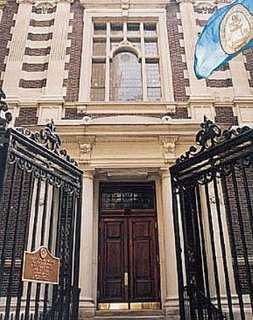
|
| College of Physicians of Philadelphia |
The College of Physicians of Philadelphia is the oldest medical organization in America, or even the Western Hemisphere, having been founded in 1787, the year of the Constitutional Convention. The CPP, located on 22nd Street near Market, is not to be confused with the American College of Physicians (a much more recent organization, formed in 1923 and located at Fifth and Arch Streets). The term "Physician" was then much more specific, and Philip Syng Physick, now known as the father of American Surgery was not considered eligible for membership because he was a surgeon, not a physician.
The general idea of the founding of the College seems to have been to focus on the physicians who had attended medical school (usually in Edinburgh), as distinguished from the general run of a physician at the time, who had merely served an apprenticeship. The first medical school, at the University of Pennsylvania (then at Ninth and Walnut Streets, but now at 36th and Spruce) caused the College of Physicians to turn away from pedagogy to the direction of setting standards and providing a forum for the "better sort" of the profession to be self-governing. At one point, there was even a real possibility that the College of Physicians of Philadelphia would become the credentialing agency for the whole country, but licensing took the direction of state boards during the Nineteenth Century. Every book and journal must have a Library of Congress number. The Transactions of the College of Physicians of Philadelphia has a Library of Congress number, all right. Number one. Jonathan Rhoads, the giant of 20th Century surgery and the only person to be president of the College twice, once remarked that being first may not be terribly important in the greater scheme of things, but -- it's awfully hard to imitate.
The College was a very strong guiding force in the development of a system of medical ethics for the profession. A curious false turn was taken in the direction of Lambda Chi, a secret society of physicians for the purpose of invisibly policing medical conduct, but the College soon recognized this was the wrong direction to take, and eventually, it assumed the lead in forming the American Medical Association in 1848. The portrait of Chapman, the first President of the AMA, hangs above the mantle in the fellows' reception room, the original minutes and rolls of the delegates are found in the library. Half a dozen presidents of the College were also presidents of the AMA, but for some curious reason the College never became the local branch of the AMA, reserving that for the State and Pennsylvania County Medical Societies.
Every year a number of the most distinguished physicians in the world address the College, and an annual lecture by a Nobel Prize winner has been established. The College had the largest medical library in the country until recently, and it is still one of the largest. The present building is a Carnegie Library, in a sense. Andrew Carnegie was a patient of S. Weir Mitchell at the time Mitchell was president of the College and donated a large sum for a new building. The present elegant marble and the walnut-paneled structure was built in 1905, fairly recent by Philadelphia standards but nevertheless a national landmark.
With all this dignity, history and tradition, it likely comes as a surprise to learn that the College building has sixty thousand paid visitors each year. The source of this popularity is a combination of medical exhibits for the public, and the Mutter Museum. In the late Nineteenth Century Thomas Dent Mutter gave his large personal collection of anatomical specimens to the College for a museum in the style of the medieval European medical schools, where the students could learn from specimens on display because anatomical dissection was discouraged if not forbidden, and Kodachrome slides had not been invented. Mutter's collection is a combination of believe-it-or-not "freaks", anthropological studies of human variations, and a museum of medical history. The former curator, Gretchen Worden, has produced an illustrated book of the exhibits which quickly sold out and must be reprinted, and a yearly illustrated calendar which is quite popular. The doctors are a little bemused by the popularity of this material with the public, but tolerant.
Among the odd features of this collection is the brain of Sir William Osler, the giant of modern medical education. Osler belonged to a club of people who had such a high opinion of their own genius they pledged to donate their brains after death to the collection of specimens, in the hope that eventually science would be able to determine the anatomical source of their talents. Most people today are a little staggered at the arrogance of such an idea, so widely at variance with the concept that all men are created equal. Albert Einstein is another acknowledged genius whose brain is still floating in a pickle jar, waiting for its unique properties to be discerned. Presumably, time will eventually tell whether even the greatest intellects suffer from unconquerable hubris, or whether the envious rest of us must adapt to the consensus of political correctness, just to avoid facing the reality of our own inferiority.
71 Blogs
Future Directions for Colleges
 America is in a mad expensive race to construct enough first-rank universities for everyone to use. Eventually, we will have too many of them.
America is in a mad expensive race to construct enough first-rank universities for everyone to use. Eventually, we will have too many of them.
Colleges and Religions Drift Apart

Financing a Research University
 Responding to staggering financial temptations, our most prestigious universities are beginning to put both themselves and the rest of the country at unacceptable risk.
Responding to staggering financial temptations, our most prestigious universities are beginning to put both themselves and the rest of the country at unacceptable risk.
The University City
 Ben Franklin would scarcely recognize the college he created. It isn't named for him, but he probably would be concerned about how quickly it is changing.
Ben Franklin would scarcely recognize the college he created. It isn't named for him, but he probably would be concerned about how quickly it is changing.
Paying for College I
 A service economy needs more education past high school. Soaring college tuition costs imply a supply shortage, and hence we need more colleges.
But cheaper ones.
A service economy needs more education past high school. Soaring college tuition costs imply a supply shortage, and hence we need more colleges.
But cheaper ones.
Paying For College - II
 As college education strives to be universal, forcing a few prosperous students to subsidize many needy ones becomes unsustainable. Colleges must devise better tuition systems before somebody else does it for them.
As college education strives to be universal, forcing a few prosperous students to subsidize many needy ones becomes unsustainable. Colleges must devise better tuition systems before somebody else does it for them.
The University Museum: Frozen in Concrete
 Archaeology has long been at the center of Philadelphia culture. The University Museum of Archaeology, the largest of its kind in America. is a victim of success, stranded in a congested and overbuilt corner of town.
Archaeology has long been at the center of Philadelphia culture. The University Museum of Archaeology, the largest of its kind in America. is a victim of success, stranded in a congested and overbuilt corner of town.
Pyramid-Building, Greatly Simplified
 After several thousand years, building the Egyptian pyramids might turn out to be easier than we imagined.
After several thousand years, building the Egyptian pyramids might turn out to be easier than we imagined.
B. Franklin, Scientist
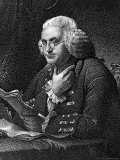 Kites are children's toys; going out in a thunderstorm is deliciously dangerous. We have thus been taught to regard Franklin's science as a lark, when in fact he largely discovered the nature of electricity and was regarded as one of the greatest scientists of his age.
Kites are children's toys; going out in a thunderstorm is deliciously dangerous. We have thus been taught to regard Franklin's science as a lark, when in fact he largely discovered the nature of electricity and was regarded as one of the greatest scientists of his age.
A Toast to Doctor Franklin
 The Franklin Inn annually toasts three doctors. Even though Ben never went past second grade, his medical contributions are the most illustrious of the three. One of the most remarkable men who ever lived.
The Franklin Inn annually toasts three doctors. Even though Ben never went past second grade, his medical contributions are the most illustrious of the three. One of the most remarkable men who ever lived.
Beyond Most of Us
 Louis I. Kahn and Robert Venturi have a lot in common. One was the student of the other, both Philadelphians are revered as giants of the field of architecture, and -- it's awfully hard to find one of their buildings.
Louis I. Kahn and Robert Venturi have a lot in common. One was the student of the other, both Philadelphians are revered as giants of the field of architecture, and -- it's awfully hard to find one of their buildings.
Exit, Pursued by a Bear
 Its medical school consumes 75% of Penn's budget, causing a lot of difficulty for the rest of the University.
Its medical school consumes 75% of Penn's budget, causing a lot of difficulty for the rest of the University.
Please Don't Lose Any Sleep Over This
 New research suggests that when medical Resident physicians stay up all night working, they get sleepy. When a minimum sleep requirement for doctors was suggested, administrators were a little stunned to find doctors were annoyed.
New research suggests that when medical Resident physicians stay up all night working, they get sleepy. When a minimum sleep requirement for doctors was suggested, administrators were a little stunned to find doctors were annoyed.
Why Are Hospital Prices So High?
 The answer is that they are discounts to insurance companies. People with insurance pay a lower price than those without.
The answer is that they are discounts to insurance companies. People with insurance pay a lower price than those without.
The Blue Cross Discount (6)
 Hospitals customarily inflate many charges so far beyond their costs that you must buy insurance to protect yourself. Whatever the dominant health insurers may be doing to encourage that practice, they are the main ones to benefit from it.
Hospitals customarily inflate many charges so far beyond their costs that you must buy insurance to protect yourself. Whatever the dominant health insurers may be doing to encourage that practice, they are the main ones to benefit from it.
Healthcare Reform: Looking Ahead (2)
 Spending for health care will just grow and grow forever. Oh, yeah?
Spending for health care will just grow and grow forever. Oh, yeah?
The American Health Non-system
 America is betting heavily that elimination of disease will ultimately reduce healthcare costs.
America is betting heavily that elimination of disease will ultimately reduce healthcare costs.
Cost of Medical Care
 Milton Hershey agreed to fund the Hershey Medical School out his own pocket, after a ten-minute conversation.
Milton Hershey agreed to fund the Hershey Medical School out his own pocket, after a ten-minute conversation.
Flexner Report, Revisited
 A new book by John A. Kastor compares the doctor-run Cleveland Clinic with the University-run Hospitals of Case Western Reserve under the managed care insurance system. Both hospital systems had plenty of problems, many of them self-inflicted, but it looks like doctor-run is winning the race.
A new book by John A. Kastor compares the doctor-run Cleveland Clinic with the University-run Hospitals of Case Western Reserve under the managed care insurance system. Both hospital systems had plenty of problems, many of them self-inflicted, but it looks like doctor-run is winning the race.
Picking Up the Usual Suspects
 When the U.S. President plans to change health care, everyone involved in healthcare gets excited. Some want to resist change, some want to exploit it, but everyone wants to have influence.
When the U.S. President plans to change health care, everyone involved in healthcare gets excited. Some want to resist change, some want to exploit it, but everyone wants to have influence.
A Toast To J. William White, MD
 Franklin Inn holds the J. William White dinner every year on Benjamin Franklin's birthday. A surgeon, author, politician, athlete, cavalryman, and duelist, Bill was a real Philadelphia gentleman.
Franklin Inn holds the J. William White dinner every year on Benjamin Franklin's birthday. A surgeon, author, politician, athlete, cavalryman, and duelist, Bill was a real Philadelphia gentleman.
Philosophy Means Science in Philadelphia
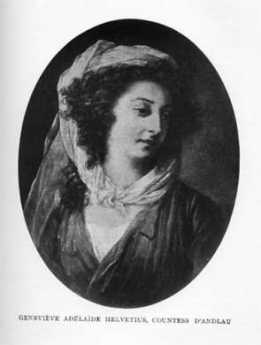 At least until he met Madame Helvetius, Benjamin Franklin displayed little interest in moral philosophy. His interest was in science, which was called natural philosophy in the Eighteenth Century. The American Philosophical Society is America's oldest and most prestigious society of scientific scholars. If investing is a science, the APS is good at that, too.
At least until he met Madame Helvetius, Benjamin Franklin displayed little interest in moral philosophy. His interest was in science, which was called natural philosophy in the Eighteenth Century. The American Philosophical Society is America's oldest and most prestigious society of scientific scholars. If investing is a science, the APS is good at that, too.
TOAST TO E. DIGBY BALTZELL (1915-1996)
 A toast to E. Digby Baltzell (1915-1996), given by Theodore Friend, Sr. at the Franklin Inn Club annual dinner on Franklin's birthday, where toasts are customary.
A toast to E. Digby Baltzell (1915-1996), given by Theodore Friend, Sr. at the Franklin Inn Club annual dinner on Franklin's birthday, where toasts are customary.
Puritan Boston & Quaker Philadelphia
 The University of Pennsylvania Sociology professor E. Digby Baltzell drew attention to the strong persistence of earlier elite influences, using Philadelphia's Quakers and Boston's Puritans as prime examples.
The University of Pennsylvania Sociology professor E. Digby Baltzell drew attention to the strong persistence of earlier elite influences, using Philadelphia's Quakers and Boston's Puritans as prime examples.
Swarthmore College

Lithuanian Law
 American lawyers teaching law students in Lithuania illustrate the strange contrast between the hunger of some Europeans for American leadership and the rejection of American culture by others.
American lawyers teaching law students in Lithuania illustrate the strange contrast between the hunger of some Europeans for American leadership and the rejection of American culture by others.
Home of the U.S. Naval Academy
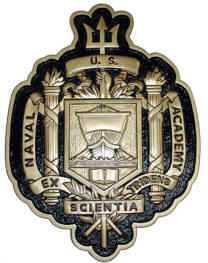 The Naval Acadamy now in Annapolis originally was on Gray's Ferry Avenue. It's still a handsome building, in some danger of destruction by real estate developers.
The Naval Acadamy now in Annapolis originally was on Gray's Ferry Avenue. It's still a handsome building, in some danger of destruction by real estate developers.
The Scotch-Irish In the Revolution
 English Quakers and Rhineland Germans were eternally grateful to the British Monarch for offering them an American refuge. By contrast, the Scotch-Irish, although energetic frontiersmen, harbored lasting resentment against the English Kings who had driven them here.
English Quakers and Rhineland Germans were eternally grateful to the British Monarch for offering them an American refuge. By contrast, the Scotch-Irish, although energetic frontiersmen, harbored lasting resentment against the English Kings who had driven them here.
The Schools of School House Lane
 Exclusive privates schools and colleges are usually to be found in isolated rural settings. But our oldest, best, and most famous schools are clustered together in a neighborhood that is far from exclusive.
Exclusive privates schools and colleges are usually to be found in isolated rural settings. But our oldest, best, and most famous schools are clustered together in a neighborhood that is far from exclusive.
Military School
 Valley Forge Military Academy takes rambunctious boys and makes them into leaders. Even some of the misfits and dropouts seem to benefit from the difficult experience.
Valley Forge Military Academy takes rambunctious boys and makes them into leaders. Even some of the misfits and dropouts seem to benefit from the difficult experience.
Germantown Before 1730
 The early German settlers of Germantown were religious intellectuals, with a Swiss background and a history of religious martyrdom.
The early German settlers of Germantown were religious intellectuals, with a Swiss background and a history of religious martyrdom.
Settlement Music School
 Without much notice, fifteen thousand music students attend six branches of a school with connections to the NAACP, ACLU, and the Bull Moose Party.
Without much notice, fifteen thousand music students attend six branches of a school with connections to the NAACP, ACLU, and the Bull Moose Party.
Tree Huggers: Delaware Valley College
 Delaware Valley College is a curious mixture of farm school with scientific aspirations and a Jewish history, located in Doylestown, where New York City and Philadelphia meet,
Delaware Valley College is a curious mixture of farm school with scientific aspirations and a Jewish history, located in Doylestown, where New York City and Philadelphia meet,
Rise and Fall of Books
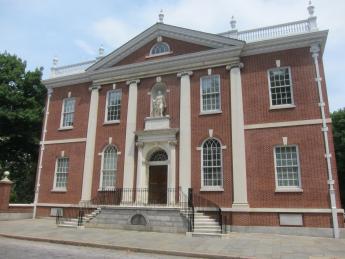 The The Director of America's first library sees books as mainly a 19th Century phenomenon.
The The Director of America's first library sees books as mainly a 19th Century phenomenon.
Gallatin Part II
 When Jefferson won the deadlocked election of 1800, Albert Gallatin was the obvious choice for Treasury Secretary. But having destroyed Hamilton's Bank, he had the humiliating duty to reverse position to fight the War of 1812. A five-act play, with duels.
When Jefferson won the deadlocked election of 1800, Albert Gallatin was the obvious choice for Treasury Secretary. But having destroyed Hamilton's Bank, he had the humiliating duty to reverse position to fight the War of 1812. A five-act play, with duels.
On the Subject of Rights
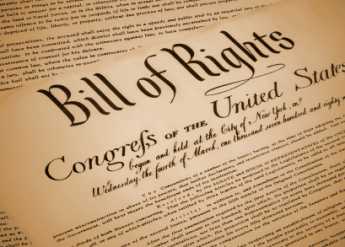 Human rights were mainly a religious issue to the Founding Fathers, demanding a Bill of Rights to signify God's supremacy over legislatures. When John Marshall transformed the Constitution into the capstone of the legal system, constitutionally affirmed rights became a legal trump card for those who feared or opposed the actions of the government. With that difference, it's little different, two hundred years later.
Human rights were mainly a religious issue to the Founding Fathers, demanding a Bill of Rights to signify God's supremacy over legislatures. When John Marshall transformed the Constitution into the capstone of the legal system, constitutionally affirmed rights became a legal trump card for those who feared or opposed the actions of the government. With that difference, it's little different, two hundred years later.
Commercial Academic Think Tank
 There are universities and there are think tanks. Philadelphia has at least one commercial consulting firm which combines elements of both.
There are universities and there are think tanks. Philadelphia has at least one commercial consulting firm which combines elements of both.
Rara Avis
 The Academy of Natural Sciences is one of the great jewels of Philadelphia, and like the rest of the city, cringes from publicity but needs it badly.
The Academy of Natural Sciences is one of the great jewels of Philadelphia, and like the rest of the city, cringes from publicity but needs it badly.
Religion at Girard College:Spiritual But Irreligious
 In his will, Stephen Girard famously banished all clergymen from the grounds of his school for orphans, even as visitors. Nevertheless, the school's atmosphere is a highly ethical, even religious, one. Many graduates have become ministers.
In his will, Stephen Girard famously banished all clergymen from the grounds of his school for orphans, even as visitors. Nevertheless, the school's atmosphere is a highly ethical, even religious, one. Many graduates have become ministers.
The Supreme Court Revisits Girard's Will
 The tangled history of Stephen Girard's will and its two trips to the US Supreme Court, tells us a lot about what's at stake in the appointment of judges.
The tangled history of Stephen Girard's will and its two trips to the US Supreme Court, tells us a lot about what's at stake in the appointment of judges.
Wagner Free Institute of Science
 The Wagner science museum may not be the oldest museum in Philadelphia, but it is certainly the only one that is exactly the same as it was in the Nineteenth Century. It's a museum museum.
The Wagner science museum may not be the oldest museum in Philadelphia, but it is certainly the only one that is exactly the same as it was in the Nineteenth Century. It's a museum museum.
Two Pacifists: Einstein and Eddington
 The English Quaker Sir Arthur Eddington was granted draft exemption during World War I, on condition that he conduct a test of the Theory of Relativity produced by the German conscientious objector, Albert Einstein. Einstein won.
The English Quaker Sir Arthur Eddington was granted draft exemption during World War I, on condition that he conduct a test of the Theory of Relativity produced by the German conscientious objector, Albert Einstein. Einstein won.
There She Goes, Miss America
 The Miss America contest is all changed and different, but maybe it stays the same.
The Miss America contest is all changed and different, but maybe it stays the same.
Sugarloaf
 The Strouds of Stroudsburg used to live here at the top of the town. It's now a conference center.
The Strouds of Stroudsburg used to live here at the top of the town. It's now a conference center.
Preppies of the Future?
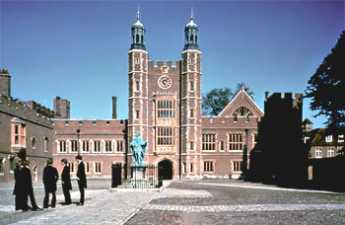 Elite boarding schools may not perceive their proper role, which is a useful one.
Elite boarding schools may not perceive their proper role, which is a useful one.
David F. Bradford, 1939-2005
 David Bradford, Princeton economist, recently died in an unfortunate accident. His 1977 paper "Blueprints for Tax Reform" inspired Individual Retirement Accounts, Health Savings Accounts, individual Social Security Accounts, the flat tax, and the advantages of shifting from income taxation to consumption taxes.
David Bradford, Princeton economist, recently died in an unfortunate accident. His 1977 paper "Blueprints for Tax Reform" inspired Individual Retirement Accounts, Health Savings Accounts, individual Social Security Accounts, the flat tax, and the advantages of shifting from income taxation to consumption taxes.
Hayek Confronts Keynes
 The influence of Austrian economist Friedrich von Hayek is slowly winning out over the views of the English economist Maynard Keynes, even though both of them are dead. Which is worse, inflation or depression?
The influence of Austrian economist Friedrich von Hayek is slowly winning out over the views of the English economist Maynard Keynes, even though both of them are dead. Which is worse, inflation or depression?
Bertrand Russell Disturbs the Barnes Foundation Neighbors
 How one of Britain's most notorious philosophers wandered into the city of brotherly love and vaulted out of destitution to wealth.
How one of Britain's most notorious philosophers wandered into the city of brotherly love and vaulted out of destitution to wealth.
Yale Blue
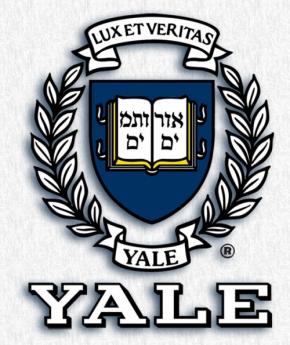 Academia is acquiring unaccustomed power, wealth and arrogance. It can cause friction with students whose career plans lie in other directions.
Academia is acquiring unaccustomed power, wealth and arrogance. It can cause friction with students whose career plans lie in other directions.
Advanced Placement Gains Attackers and Defenders
 College admission is so competitive it creates vested interests. Everything is questioned, even the value of college itself.
College admission is so competitive it creates vested interests. Everything is questioned, even the value of college itself.
Unintended Consequences for Advanced Placement
 The story of how the author complained to his head master about preparation for college and how it led to the concept of Advanced Placement courses in high schools.
The story of how the author complained to his head master about preparation for college and how it led to the concept of Advanced Placement courses in high schools.
Charitable Immunity: An Underestimated Revolution
 This particular judge-made change in the laws opened the floodgates for malpractice lawsuits..
This particular judge-made change in the laws opened the floodgates for malpractice lawsuits..
Main Line School Night
 There are a lot of continuing education courses, but few are as successful as Main Line School Night, with 14,000 students, hardly any of whom need education.
There are a lot of continuing education courses, but few are as successful as Main Line School Night, with 14,000 students, hardly any of whom need education.
A Woman's Work
 When Haverford admitted women students perhaps it meant to go all-women.
When Haverford admitted women students perhaps it meant to go all-women.
Lumpers In Constant Combat With Splitters
 The home dinner table is no longer the place most families teach the rules of conduct to each other, probably because of the invasion of homes by television. But there are places where friendly debate is still conducted and social issues are settled. In Philadelphia, newcomers are still taught what's what, in this manner.
The home dinner table is no longer the place most families teach the rules of conduct to each other, probably because of the invasion of homes by television. But there are places where friendly debate is still conducted and social issues are settled. In Philadelphia, newcomers are still taught what's what, in this manner.
Volunteerism Needs a Business Plan
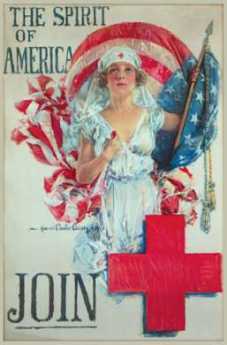 Volunteerism has declined in recent years because of conflicting demands made by gainful employment. The spirit of volunteerism has not diminished, it just needs a different business plan.
Volunteerism has declined in recent years because of conflicting demands made by gainful employment. The spirit of volunteerism has not diminished, it just needs a different business plan.
Pets For all Seasons
 Penn's Veterinary School has established a department for the study of pets and pet loving.
Penn's Veterinary School has established a department for the study of pets and pet loving.
Avian Footnote

Starving the Beast of Early Retirement
 New Jersey may be about to demonstrate that taxpayers should be on the lookout for too many government employees, not too much government spending.
New Jersey may be about to demonstrate that taxpayers should be on the lookout for too many government employees, not too much government spending.
New Museum of Chemical Heritage
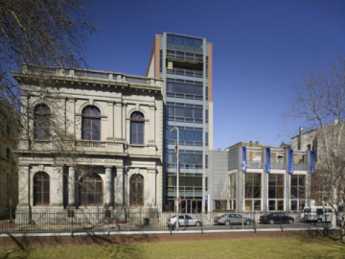 There's a stunning new museum on Chestnut Street, right across the street from Carpenters Hall. It's intended to convince everybody that chemistry is fascinating, particularly those who incline to doubt it.
There's a stunning new museum on Chestnut Street, right across the street from Carpenters Hall. It's intended to convince everybody that chemistry is fascinating, particularly those who incline to doubt it.
School Tax Seldom Equates to School Spending
 Voting today on school budgets, local districts in New Jersey do not seem to realize how poorly school spending correlates with school tax rates.
Voting today on school budgets, local districts in New Jersey do not seem to realize how poorly school spending correlates with school tax rates.
The Supreme Court Gets Fed Up With Professors
 The interpretation of American law belongs to Judges, not to law schools, and administration of the courts is controlled by the U.S. Supreme Court. Period. What the two subjects have to do with each other was not explained, but Washington DC has a way of circulating rumors. The opinion was a warning.
The interpretation of American law belongs to Judges, not to law schools, and administration of the courts is controlled by the U.S. Supreme Court. Period. What the two subjects have to do with each other was not explained, but Washington DC has a way of circulating rumors. The opinion was a warning.
Gardening Survives
 A new book has arrived, describing the 90 great public gardens of the Philadelphia regions, and discussing the best 40 of them in detail.
A new book has arrived, describing the 90 great public gardens of the Philadelphia regions, and discussing the best 40 of them in detail.
America's New Theater Capital
 New York's professional theaters have mostly become a tourist industry. The new capital of legitimate theater in America is -- Philadelphia.
New York's professional theaters have mostly become a tourist industry. The new capital of legitimate theater in America is -- Philadelphia.
Perpetuities
 Although most founders of institutions look far into the future, the fact is comparatively few corporations, for-profit or not-for-profit, last longer than seventy-five years.
Although most founders of institutions look far into the future, the fact is comparatively few corporations, for-profit or not-for-profit, last longer than seventy-five years.
Politics of Employer Hiring Preferences
 The for-profit or nonprofit nature of your previous employer affects your chances of being hired by a new boss.
The for-profit or nonprofit nature of your previous employer affects your chances of being hired by a new boss.
Sorting Out Future Winners Some Suggestions
It's getting to be time for the country to tell the education industry what is expected of it.
No Laborer Left Behind
 Expanding prestige universities to fill American academic demands, unexpectedly provoke inflation obscured by illegal immigration.
Expanding prestige universities to fill American academic demands, unexpectedly provoke inflation obscured by illegal immigration.
Existing Websites Which Offer Higher Education
The number of Internet websites which currently offer free education on the college level is immense and growing rapidly. Just as terabyte is the next step after gigabyte, we need a new word to denominate "much larger than merely immense".
Wistar Institute, Spelled With an "A"
 The Wistar Institute is properly pronounced "Wister", but in fact it's all the same family. Its fame in biomedical research makes that quite irrelevant.
The Wistar Institute is properly pronounced "Wister", but in fact it's all the same family. Its fame in biomedical research makes that quite irrelevant.
College of Physicians of Philadelphia
 The oldest medical organization in the Western Hemisphere was original founded by eight doctors who had gone to medical school, unlike the rest. It's now a museum of medical history with a huge public attendance, it's a fabulous medical historical library and a famous medical lecture venue. And it's a doctor's club.
The oldest medical organization in the Western Hemisphere was original founded by eight doctors who had gone to medical school, unlike the rest. It's now a museum of medical history with a huge public attendance, it's a fabulous medical historical library and a famous medical lecture venue. And it's a doctor's club.